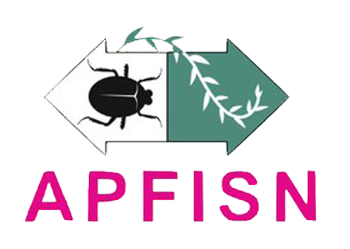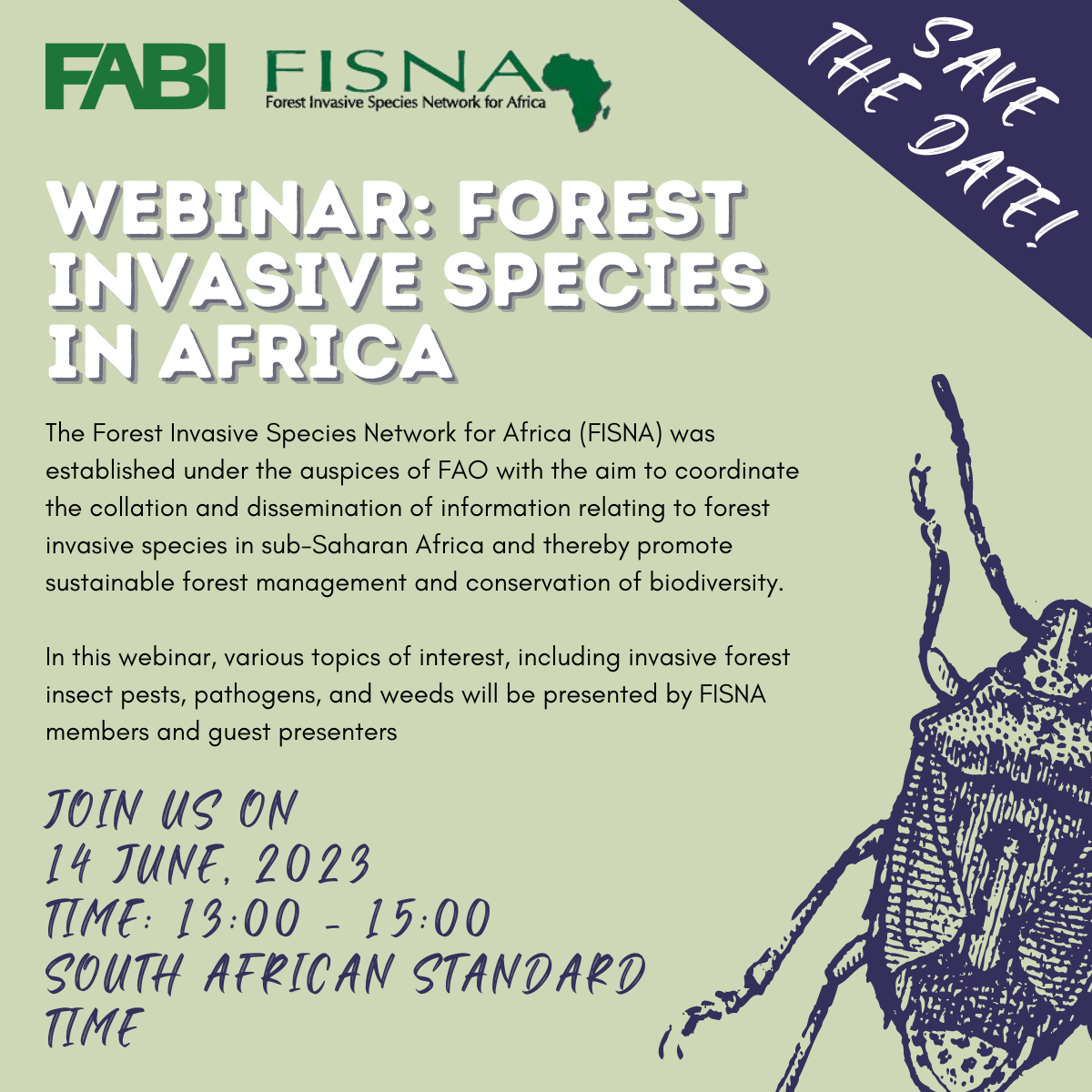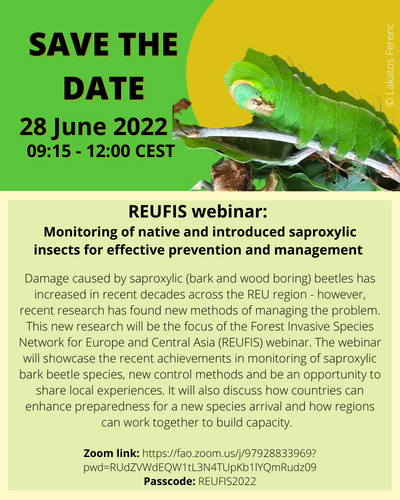Press Clippings
-
 01/09/2025WA scientists are banding together to tackle the mammoth task of controlling and managing the polyphagous shot-hole borer, with three research projects to minimise the risk of infestation beyond the Perth metro area. The WA Agricultural Research Collaboration will invest $2.17 million across three projects led by the University of Western Australia, Murdoch University, and Curtin University. As of June, there had been 764 active infested premises identified, 1161 trees pruned, and 4794 trees removed in the fight against the Polphagous shot-hole borer. The first project to increase tools for control of the beetle will be led by UWA Associate Professor Theo Evans. The project will research the beetle’s dispersal behaviour and survival, chemical control methods, biological control, and increasing community engagement and reporting of shot-hole borer infection. Dr Evans said the outcomes of the project would include a better understanding of the beetle’s dispersal behaviour and survival, preventative control through tree trunk injections and new biocontrol agents, and new management tools to save trees from being destroyed. Read more here
01/09/2025WA scientists are banding together to tackle the mammoth task of controlling and managing the polyphagous shot-hole borer, with three research projects to minimise the risk of infestation beyond the Perth metro area. The WA Agricultural Research Collaboration will invest $2.17 million across three projects led by the University of Western Australia, Murdoch University, and Curtin University. As of June, there had been 764 active infested premises identified, 1161 trees pruned, and 4794 trees removed in the fight against the Polphagous shot-hole borer. The first project to increase tools for control of the beetle will be led by UWA Associate Professor Theo Evans. The project will research the beetle’s dispersal behaviour and survival, chemical control methods, biological control, and increasing community engagement and reporting of shot-hole borer infection. Dr Evans said the outcomes of the project would include a better understanding of the beetle’s dispersal behaviour and survival, preventative control through tree trunk injections and new biocontrol agents, and new management tools to save trees from being destroyed. Read more here -
 01/09/2025(A Fijian crested iguana. Photo: Benjamint444, Wikimedia Commons) Smack-bang in the center of the Pacific Ocean – slightly north of the equator and about 1,800 kilometers south of Hawaii – lies uninhabited Palmyra Atoll, a U.S. National Wildlife Refuge managed by The Nature Conservancy (TNC). This year, a group of zoologists spent their Easter weekend there hunting for – and finding – Easter eggs of an unconventional kind: those laid by four much-watched pairs of sihek, or Guam kingfishers (Todiramphus cinnamominus). “While they might not be as shiny or brightly colored, these tiny, unassuming-looking eggs are far more exciting and precious than any of their chocolate counterparts,” enthuses John Ewen of the Zoological Society of London (ZSL), who chairs its global Sihek Recovery Program Team. “They are a remarkable milestone for the decades-long mission to rescue the sihek from the edge of extinction.” His excitement was understandable: these eggs were the first laid by the species in the wild in almost 40 years. Read more here
01/09/2025(A Fijian crested iguana. Photo: Benjamint444, Wikimedia Commons) Smack-bang in the center of the Pacific Ocean – slightly north of the equator and about 1,800 kilometers south of Hawaii – lies uninhabited Palmyra Atoll, a U.S. National Wildlife Refuge managed by The Nature Conservancy (TNC). This year, a group of zoologists spent their Easter weekend there hunting for – and finding – Easter eggs of an unconventional kind: those laid by four much-watched pairs of sihek, or Guam kingfishers (Todiramphus cinnamominus). “While they might not be as shiny or brightly colored, these tiny, unassuming-looking eggs are far more exciting and precious than any of their chocolate counterparts,” enthuses John Ewen of the Zoological Society of London (ZSL), who chairs its global Sihek Recovery Program Team. “They are a remarkable milestone for the decades-long mission to rescue the sihek from the edge of extinction.” His excitement was understandable: these eggs were the first laid by the species in the wild in almost 40 years. Read more here -
 03/06/2025Mashudu Phalanndwa is the project lead for PSHB response and head of green jobs in the City of Cape Town’s Invasive Species Unit. Part of his role is to coordinate the management of invasive species across Cape Town. (Photo: Kristin Engel) South Africa is facing an escalating ecological crisis – a tiny invasive beetle from Vietnam is killing off trees in urban and natural forests. More than 7,000 trees have been affected by the tree-killing beetle in Cape Town alone. Since its discovery in KwaZulu-Natal in 2017, the polyphagous shot hole borer (PSHB) has been confirmed in eight of South Africa’s nine provinces — Limpopo being the only exception. In Cape Town, the infestation has been severe, with more than 7,000 trees confirmed to have been infected. The PSHB infestation in South Africa was first seen affecting crops such as pecan and macadamia orchards, and then moved to commercial forestry species. Read more here
03/06/2025Mashudu Phalanndwa is the project lead for PSHB response and head of green jobs in the City of Cape Town’s Invasive Species Unit. Part of his role is to coordinate the management of invasive species across Cape Town. (Photo: Kristin Engel) South Africa is facing an escalating ecological crisis – a tiny invasive beetle from Vietnam is killing off trees in urban and natural forests. More than 7,000 trees have been affected by the tree-killing beetle in Cape Town alone. Since its discovery in KwaZulu-Natal in 2017, the polyphagous shot hole borer (PSHB) has been confirmed in eight of South Africa’s nine provinces — Limpopo being the only exception. In Cape Town, the infestation has been severe, with more than 7,000 trees confirmed to have been infected. The PSHB infestation in South Africa was first seen affecting crops such as pecan and macadamia orchards, and then moved to commercial forestry species. Read more here -
 03/06/2025Ecosystems which have never been seen before are being accidentally created by humans. They offer a stark look into the nature of tomorrow. Venture deep into the forests on O’ahu, Hawaii’s third largest island, and you’ll find yourself threading through a dense understory of richly scented pepper, cinnamon and guava trees. “It’s beautiful,” says Corey Tarwater, an ecologist at the University of Wyoming in the US who began researching O’ahu’s ecosystems in 2014. Sounds like the “cheww-chewww” song of the pale green warbling white-eye and the chattering, almost electrical call of the red-billed leiothrix surround you. “There’s really neat lizards around,” adds Tarwater. “There’s these highly structured forests with these amazing tropical plant species.” For hikers setting out on O’ahu’s mountain trails, these are thrilling wildernesses within easy reach of Hawaii’s capital, Honolulu, says Tarwater. Yet nothing is quite as it might seem, she adds. “You wouldn’t know unless you study them, but if you walk around any forest around Honolulu, there’s not going to be one single native plant species there.” Read more here
03/06/2025Ecosystems which have never been seen before are being accidentally created by humans. They offer a stark look into the nature of tomorrow. Venture deep into the forests on O’ahu, Hawaii’s third largest island, and you’ll find yourself threading through a dense understory of richly scented pepper, cinnamon and guava trees. “It’s beautiful,” says Corey Tarwater, an ecologist at the University of Wyoming in the US who began researching O’ahu’s ecosystems in 2014. Sounds like the “cheww-chewww” song of the pale green warbling white-eye and the chattering, almost electrical call of the red-billed leiothrix surround you. “There’s really neat lizards around,” adds Tarwater. “There’s these highly structured forests with these amazing tropical plant species.” For hikers setting out on O’ahu’s mountain trails, these are thrilling wildernesses within easy reach of Hawaii’s capital, Honolulu, says Tarwater. Yet nothing is quite as it might seem, she adds. “You wouldn’t know unless you study them, but if you walk around any forest around Honolulu, there’s not going to be one single native plant species there.” Read more here -
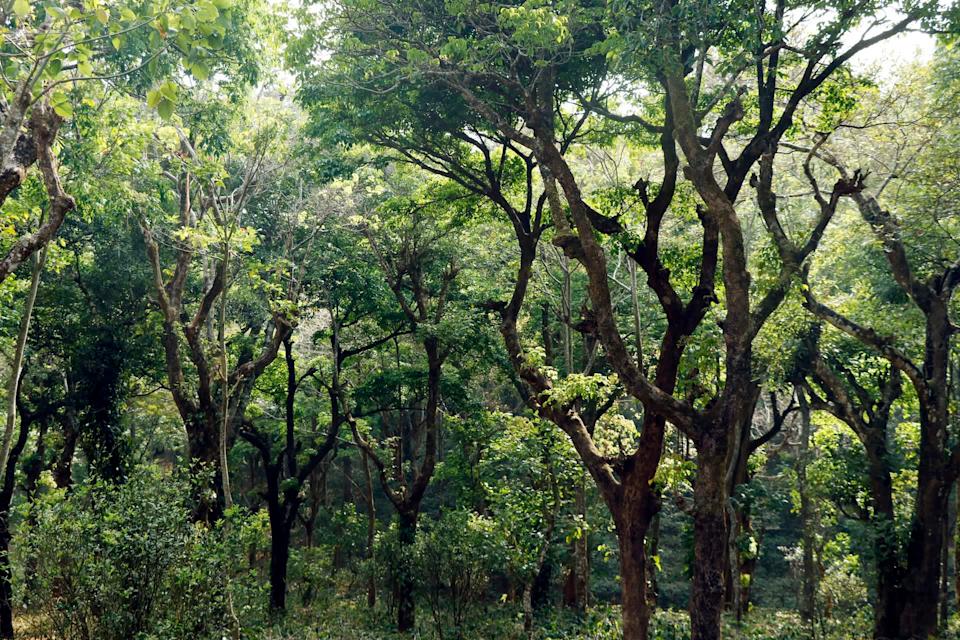 03/06/2025The Indian state of Haryana is facing a silent takeover. Experts are sounding the alarm as invasive plant species, especially one called Lantana camara, have spread uncontrollably through the region, pushing out native plants and threatening the health of the entire ecosystem. What’s happening? According to a report from the Times of India, 12% of the state’s forest land has been overtaken by invasive species, with Lantana camara being one of the biggest challenges. This tropical American shrub, originally imported by the British, is now crowding out native vegetation across local forests. Experts warn that “immediate intervention is crucial,” as the invasive spread is choking native plant growth, altering soil chemistry, increasing fire risks, and disrupting the ecosystem. If left unchecked, the damage could become irreversible. Read more here
03/06/2025The Indian state of Haryana is facing a silent takeover. Experts are sounding the alarm as invasive plant species, especially one called Lantana camara, have spread uncontrollably through the region, pushing out native plants and threatening the health of the entire ecosystem. What’s happening? According to a report from the Times of India, 12% of the state’s forest land has been overtaken by invasive species, with Lantana camara being one of the biggest challenges. This tropical American shrub, originally imported by the British, is now crowding out native vegetation across local forests. Experts warn that “immediate intervention is crucial,” as the invasive spread is choking native plant growth, altering soil chemistry, increasing fire risks, and disrupting the ecosystem. If left unchecked, the damage could become irreversible. Read more here -
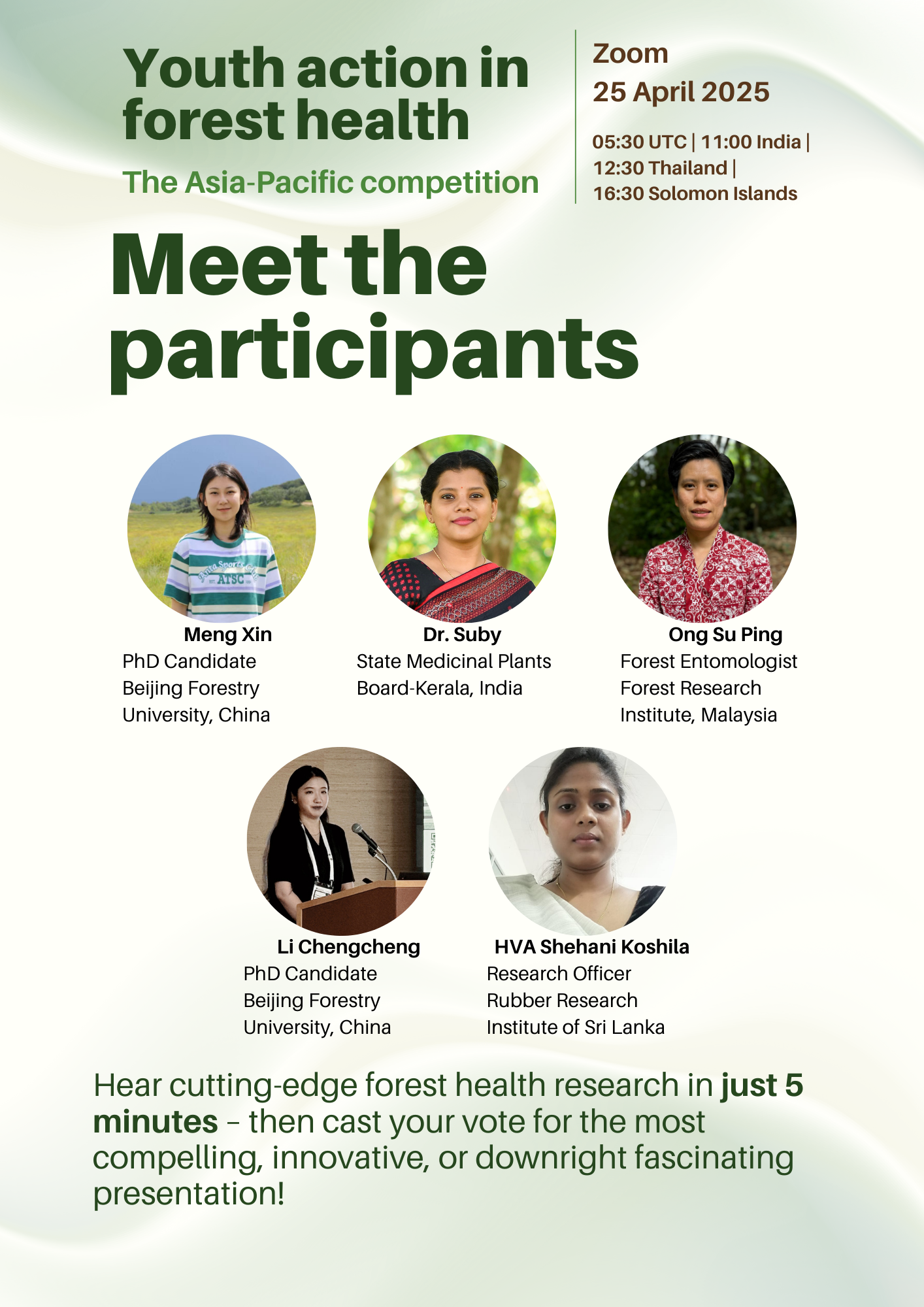 16/04/2025Join the Watch Party for the Youth Action in Forest Health – Asia-Pacific Be part of the action on 25 April 2025 and cast your vote for the most compelling presentation! In just 5 minutes, each participant will present their research in a concise, impactful, and engaging presentation, highlighting how their work contributes to tackling critical forest health issues across the region. 🌱 Watch, engage and vote for the pitch that stands out—your choice matters in the competition! 📅 Mark your calendar: Date: April 25, 2025 Time: 05:30 UTC | 11:00 India | 12:30 Thailand | 16:30 Solomon Islands Register here: https://www.fao.org/forestry/pests/events/detail/youth-action-in-forest-health—asia-pacific-competition/en Let’s come together to support youth engagement in forest health and celebrate scientific excellence across the Asia-Pacific region. We look forward to your participation!
16/04/2025Join the Watch Party for the Youth Action in Forest Health – Asia-Pacific Be part of the action on 25 April 2025 and cast your vote for the most compelling presentation! In just 5 minutes, each participant will present their research in a concise, impactful, and engaging presentation, highlighting how their work contributes to tackling critical forest health issues across the region. 🌱 Watch, engage and vote for the pitch that stands out—your choice matters in the competition! 📅 Mark your calendar: Date: April 25, 2025 Time: 05:30 UTC | 11:00 India | 12:30 Thailand | 16:30 Solomon Islands Register here: https://www.fao.org/forestry/pests/events/detail/youth-action-in-forest-health—asia-pacific-competition/en Let’s come together to support youth engagement in forest health and celebrate scientific excellence across the Asia-Pacific region. We look forward to your participation! -
 11/03/2025Youth action in forest health competition (APFISN) – call for participants is open! 🌱 Are you a young scientist passionate about forest health? We want to hear from you! 🌏 FAO & Asia-Pacific Forest Invasive Species Network (APFISN)’s Youth action in forest health competition is your chance to shine! 💡 Present your cutting-edge forest health research in a five-minute pitch, engage with forestry experts, and contribute to global sustainability efforts. 🏆 Why participate? ✔️ Showcase your research on a global stage ✔️ Connect with professionals and peers ✔️ Get recognized for your innovative solutions 🎤 Finalists will present to an expert panel & audience voters, with top participants receiving certificates from the FAO Forestry Director! 📅 The call for participants is open until Sunday 23 March —click here to apply! 👉 https://www.fao.org/forestry/pests/events/detail/call-for-participants!-youth-action-in-forest-health/en #FAO #ForestHealth #YouthInForestry
11/03/2025Youth action in forest health competition (APFISN) – call for participants is open! 🌱 Are you a young scientist passionate about forest health? We want to hear from you! 🌏 FAO & Asia-Pacific Forest Invasive Species Network (APFISN)’s Youth action in forest health competition is your chance to shine! 💡 Present your cutting-edge forest health research in a five-minute pitch, engage with forestry experts, and contribute to global sustainability efforts. 🏆 Why participate? ✔️ Showcase your research on a global stage ✔️ Connect with professionals and peers ✔️ Get recognized for your innovative solutions 🎤 Finalists will present to an expert panel & audience voters, with top participants receiving certificates from the FAO Forestry Director! 📅 The call for participants is open until Sunday 23 March —click here to apply! 👉 https://www.fao.org/forestry/pests/events/detail/call-for-participants!-youth-action-in-forest-health/en #FAO #ForestHealth #YouthInForestry -
 05/03/2025FAO’s Asia-Pacific Forest Invasive Species Network (APFISN) launched a new webinar series, ‘Voices of future forest health leaders’, aimed at connecting and empowering young professionals in the field. The first session, held on 18 February, was organized with support from the FAO Forest Health Team and the FAO Regional Office for Asia and the Pacific. It focused on career paths in forest health and featured a distinguished panel of early-career researchers and practitioners who shared their experiences, challenges, and aspirations in this field. Read more here
05/03/2025FAO’s Asia-Pacific Forest Invasive Species Network (APFISN) launched a new webinar series, ‘Voices of future forest health leaders’, aimed at connecting and empowering young professionals in the field. The first session, held on 18 February, was organized with support from the FAO Forest Health Team and the FAO Regional Office for Asia and the Pacific. It focused on career paths in forest health and featured a distinguished panel of early-career researchers and practitioners who shared their experiences, challenges, and aspirations in this field. Read more here -
 03/03/2025Screenshot Join the Voices of Future Forest Health Leaders webinar and hear from young professionals tackling forest health challenges: 🔹 Aviwe Simandla – Pest Risk Analyst, Forestry & Agricultural Biotechnology Institute (FABI) / Department of Agriculture, South Africa 🔹 Mouad Moumene – Forestry Engineer, National Agency of Water and Forests (ANEF), Morocco 🔹 Dr. Michelle Pretorius – Quantitative Researcher, Institute for Communities and Wildlife in Africa (iCWild), University of Cape Town, South Africa 🔹 Intissar Zarrouk – Research Engineer, Laboratory of Management and Valorization of Forest Resources, National Research Institute of Rural Engineering, Water and Forestry (INRGREF), Tunisia 🔹 Nigel Kombora – Master’s Student, University of Pretoria, collaborating with FABI and the Institute for Commercial Forestry Research (ICFR), South Africa 📅 Date: 04 March 2025 ⏰ Time: 11:00 CET | 13:00 EAT | 10:00 UTC 🌎 Interpretation in English, French & Arabic 🔗 Register now: https://fao.zoom.us/webinar/register/WN_hxSzcRE4TryEM9NTsq_A_Q Be part of the conversation and connect with future forest health leaders!
03/03/2025Screenshot Join the Voices of Future Forest Health Leaders webinar and hear from young professionals tackling forest health challenges: 🔹 Aviwe Simandla – Pest Risk Analyst, Forestry & Agricultural Biotechnology Institute (FABI) / Department of Agriculture, South Africa 🔹 Mouad Moumene – Forestry Engineer, National Agency of Water and Forests (ANEF), Morocco 🔹 Dr. Michelle Pretorius – Quantitative Researcher, Institute for Communities and Wildlife in Africa (iCWild), University of Cape Town, South Africa 🔹 Intissar Zarrouk – Research Engineer, Laboratory of Management and Valorization of Forest Resources, National Research Institute of Rural Engineering, Water and Forestry (INRGREF), Tunisia 🔹 Nigel Kombora – Master’s Student, University of Pretoria, collaborating with FABI and the Institute for Commercial Forestry Research (ICFR), South Africa 📅 Date: 04 March 2025 ⏰ Time: 11:00 CET | 13:00 EAT | 10:00 UTC 🌎 Interpretation in English, French & Arabic 🔗 Register now: https://fao.zoom.us/webinar/register/WN_hxSzcRE4TryEM9NTsq_A_Q Be part of the conversation and connect with future forest health leaders! -
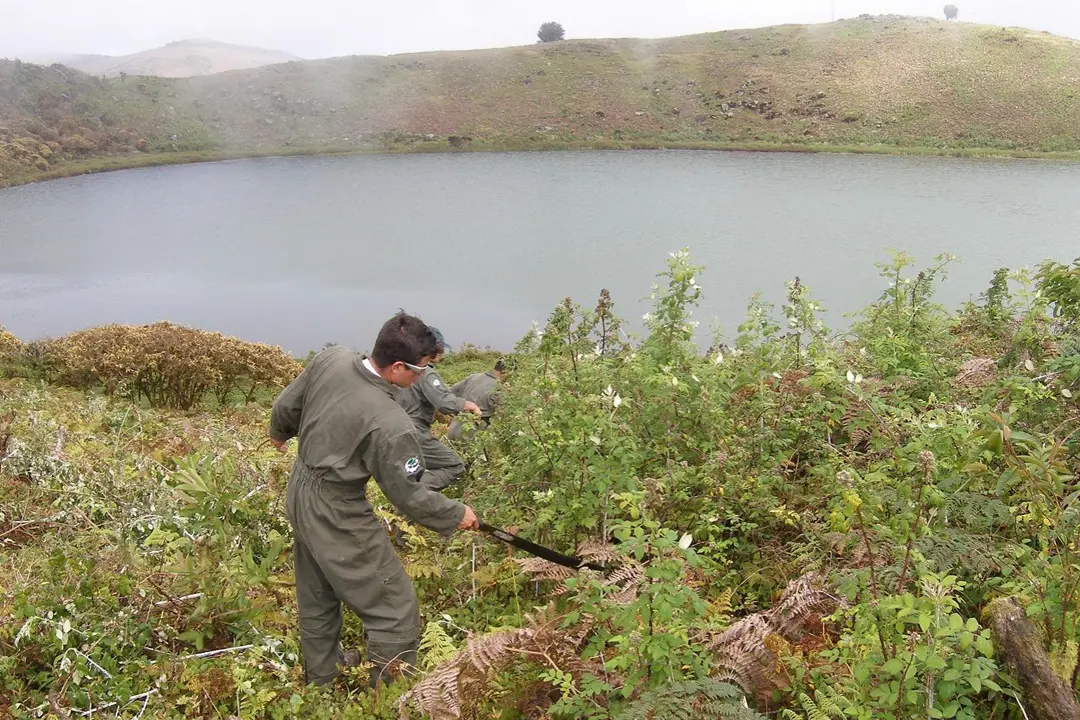 03/03/2025Park rangers controlling invasive blackberry (Rubus niveus) at El Junco Lagoon, San Cristóbal Island. ©DPNG The Invasive Species Threatening Galápagos From goats that have devastated giant tortoise habitats to fire ants and feral cats depredating native wildlife, invasive species pose one of the greatest threats to the fragile ecosystems of Galápagos. New threats continue to emerge, making prevention, monitoring, and control essential. Read more here
03/03/2025Park rangers controlling invasive blackberry (Rubus niveus) at El Junco Lagoon, San Cristóbal Island. ©DPNG The Invasive Species Threatening Galápagos From goats that have devastated giant tortoise habitats to fire ants and feral cats depredating native wildlife, invasive species pose one of the greatest threats to the fragile ecosystems of Galápagos. New threats continue to emerge, making prevention, monitoring, and control essential. Read more here -
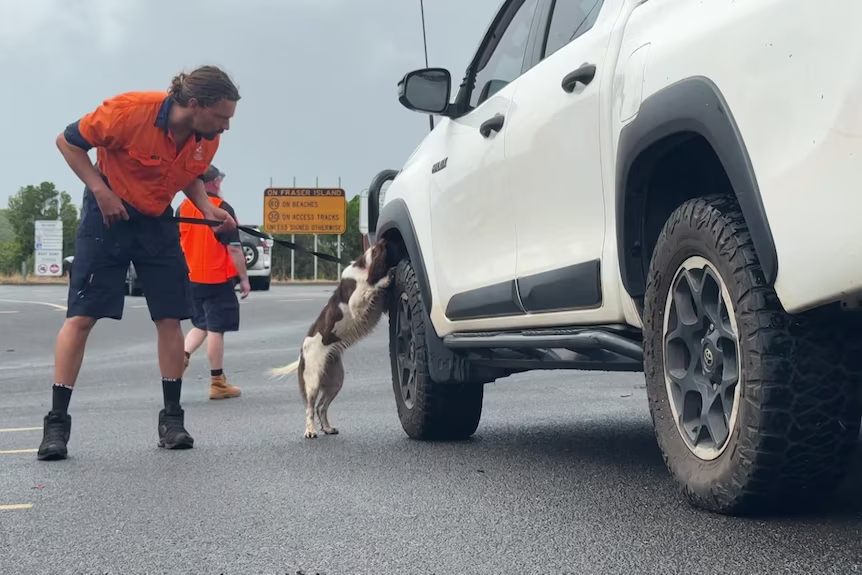 03/03/2025Investigations are underway to identify the source of invasive pests on a Queensland island of the same environmental calibre as the Galapagos Islands and Uluru. The 20,000 cars that travel to the picturesque paradise K’gari (Fraser Island) each year are all at risk of carrying invasive species to the World Heritage listed island, researchers say. While waiting to load onto the barge at River Heads to begin their holiday, 20 minutes south of Hervey Bay, scientists and traditional owners are sampling mud from their vehicles. Plant debris, insects, and weed seeds are just some of the unwanted pests that could be lurking below the mudflaps — all hard to spot with the untrained human eye. But it is a job that three-year-old English springer spaniel Alice was made for. “She has been training since she was eight weeks old to look for phytophthora,” said dog trainer Ryan Tate. Read more here
03/03/2025Investigations are underway to identify the source of invasive pests on a Queensland island of the same environmental calibre as the Galapagos Islands and Uluru. The 20,000 cars that travel to the picturesque paradise K’gari (Fraser Island) each year are all at risk of carrying invasive species to the World Heritage listed island, researchers say. While waiting to load onto the barge at River Heads to begin their holiday, 20 minutes south of Hervey Bay, scientists and traditional owners are sampling mud from their vehicles. Plant debris, insects, and weed seeds are just some of the unwanted pests that could be lurking below the mudflaps — all hard to spot with the untrained human eye. But it is a job that three-year-old English springer spaniel Alice was made for. “She has been training since she was eight weeks old to look for phytophthora,” said dog trainer Ryan Tate. Read more here -
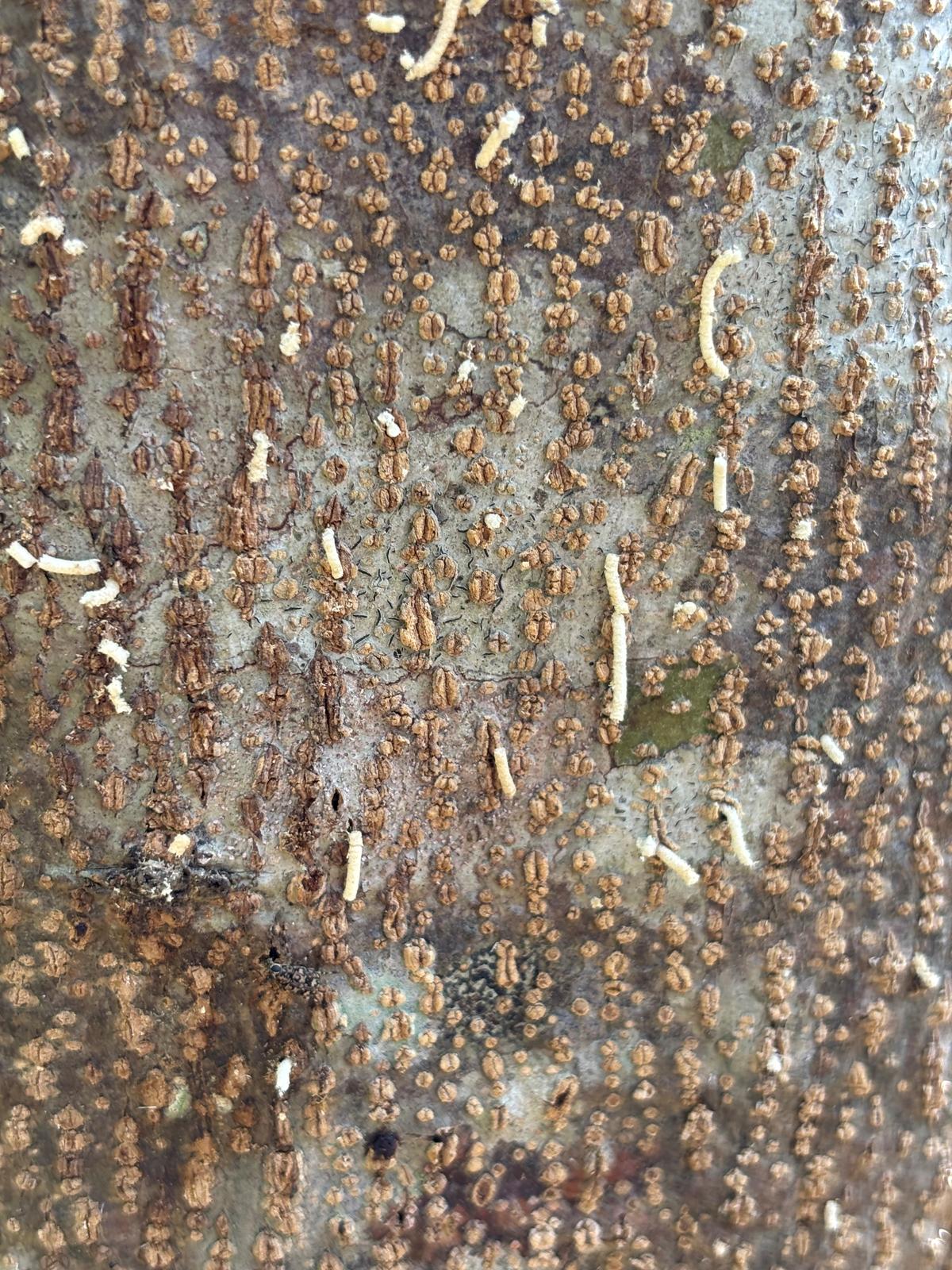 24/02/2025It could be a blessing in disguise that Senna spectabilis, a fast-spreading invasive alien tree species in Wayanad forests, is now under massive attack from island pinhole borer (Xyleborus perforans). This insect, which burrows tiny pin-sized holes into the tree trunks, has become a serious threat to the invasive tree that damages wildlife habitats. Xyleborus perforans is called a “pinhole borer” as it creates tiny, pin-sized holes in wood by burrowing into it to lay eggs. The females of the species carry fungal spores with them. Both the larvae and adults feed on the fungus they cultivate within the tree trunk, and it is this combination of insect activity and fungal infection that eventually kills the tree. T.V. Sajeev, who coordinates the Nodal Centre for Biological Invasions at the Kerala Forest Research Institute (KFRI), Peechi, notes that the insect’s massive infestation was first spotted at Thakarapadi in the Muthanga Forest Range and is now rapidly spreading across the region. The insect attacks live trees, and infested trees don’t survive for long. Interestingly, Xyleborus perforans is native to India. Read more here
24/02/2025It could be a blessing in disguise that Senna spectabilis, a fast-spreading invasive alien tree species in Wayanad forests, is now under massive attack from island pinhole borer (Xyleborus perforans). This insect, which burrows tiny pin-sized holes into the tree trunks, has become a serious threat to the invasive tree that damages wildlife habitats. Xyleborus perforans is called a “pinhole borer” as it creates tiny, pin-sized holes in wood by burrowing into it to lay eggs. The females of the species carry fungal spores with them. Both the larvae and adults feed on the fungus they cultivate within the tree trunk, and it is this combination of insect activity and fungal infection that eventually kills the tree. T.V. Sajeev, who coordinates the Nodal Centre for Biological Invasions at the Kerala Forest Research Institute (KFRI), Peechi, notes that the insect’s massive infestation was first spotted at Thakarapadi in the Muthanga Forest Range and is now rapidly spreading across the region. The insect attacks live trees, and infested trees don’t survive for long. Interestingly, Xyleborus perforans is native to India. Read more here -
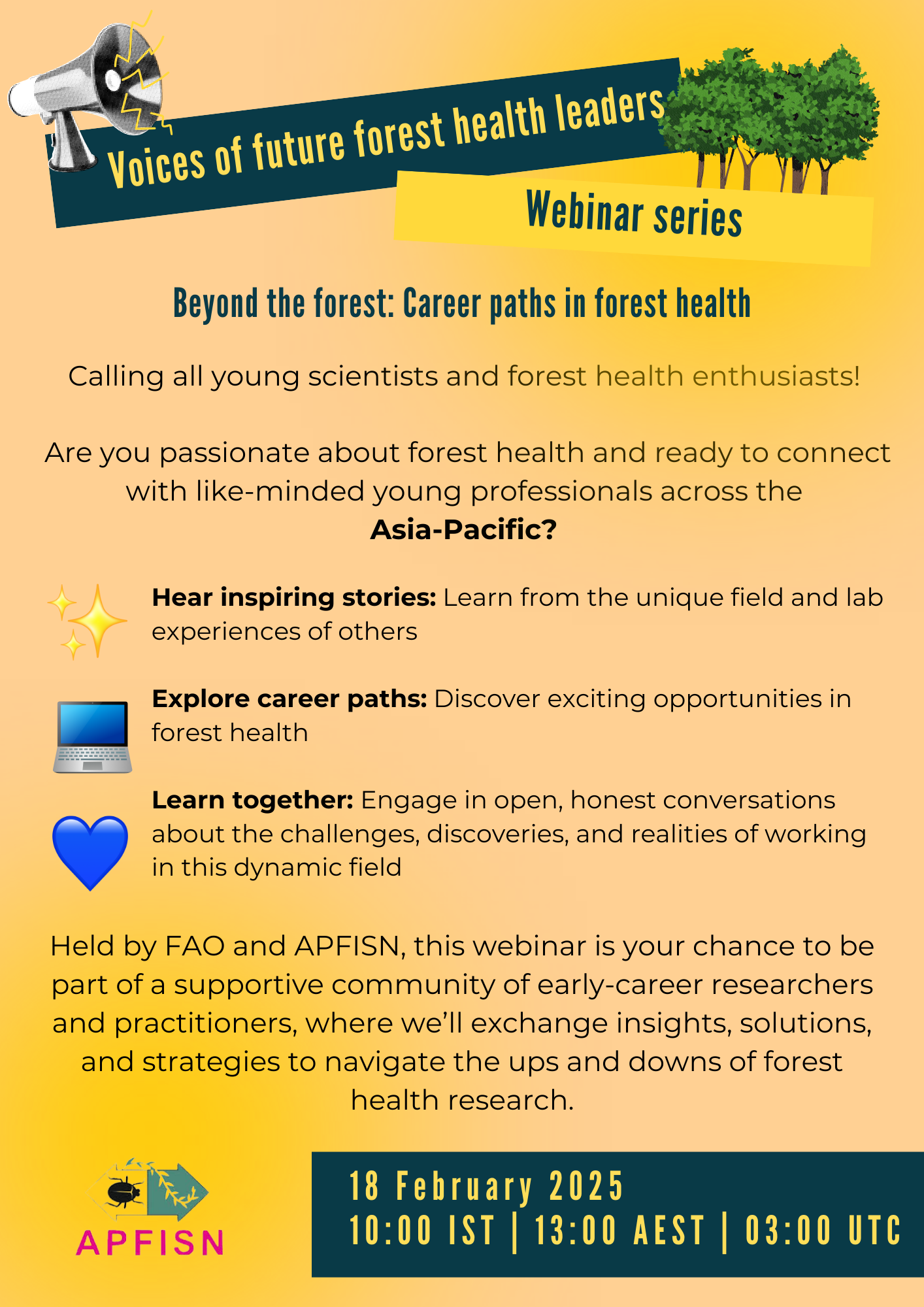 29/01/2025Join Us for the the Webinar “Beyond the forest: Career paths in forest health” the first in the “Voices of Future Forest Health Leaders” Webinar series Register now: https://fao.zoom.us/webinar/register/WN_umQDrV45Sx6Z_H4vefG5bg Download the flyer here! Are you passionate about preserving and restoring forest ecosystems? Ready to connect with like-minded young professionals in forest health? Join us for the first session of the “Voices of Future Forest Health Leaders” webinar series and be inspired by early-career researchers and practitioners from across the Asia-Pacific region! This series provides a platform for young scientists and forest health practitioners to share experiences, explore diverse career paths, and engage in collaborative dialogue around forest health challenges and innovations. Gain insights from the unique field and lab experiences of young forest health leaders, discover exciting career opportunities and engage in open conversations and build a supportive global network. Our panel of young leaders includes: Jithu Krishnan (India) | Scientist-B, Forest Entomology Department, Kerala Forest Research Institute Quynh Nhu Dang (Viet Nam) | Director, Science Training and International Cooperation Department, VAFS Maika Lesubula (Fiji) | Senior Forestry Officer, Forest Health, Ministry of Forestry, Fiji Jessa Ata (Philippines) | Associate Professor, Department of Forest Biological Sciences, University of the Philippines Los Baños Zhan Xudong (China) | PhD Candidate, Beijing Key Laboratory for Forest Pest Control, Beijing Forestry University 📅 Date: 18 February 2025 ⏰ Time: 10:00 IST | 13:00 AEST | 03:00 UTC 🔗 Register now: https://fao.zoom.us/webinar/register/WN_umQDrV45Sx6Z_H4vefG5bg Don’t miss this opportunity to connect, learn, and grow with a global community dedicated to preserving and advancing forest health. We look forward to seeing you there!
29/01/2025Join Us for the the Webinar “Beyond the forest: Career paths in forest health” the first in the “Voices of Future Forest Health Leaders” Webinar series Register now: https://fao.zoom.us/webinar/register/WN_umQDrV45Sx6Z_H4vefG5bg Download the flyer here! Are you passionate about preserving and restoring forest ecosystems? Ready to connect with like-minded young professionals in forest health? Join us for the first session of the “Voices of Future Forest Health Leaders” webinar series and be inspired by early-career researchers and practitioners from across the Asia-Pacific region! This series provides a platform for young scientists and forest health practitioners to share experiences, explore diverse career paths, and engage in collaborative dialogue around forest health challenges and innovations. Gain insights from the unique field and lab experiences of young forest health leaders, discover exciting career opportunities and engage in open conversations and build a supportive global network. Our panel of young leaders includes: Jithu Krishnan (India) | Scientist-B, Forest Entomology Department, Kerala Forest Research Institute Quynh Nhu Dang (Viet Nam) | Director, Science Training and International Cooperation Department, VAFS Maika Lesubula (Fiji) | Senior Forestry Officer, Forest Health, Ministry of Forestry, Fiji Jessa Ata (Philippines) | Associate Professor, Department of Forest Biological Sciences, University of the Philippines Los Baños Zhan Xudong (China) | PhD Candidate, Beijing Key Laboratory for Forest Pest Control, Beijing Forestry University 📅 Date: 18 February 2025 ⏰ Time: 10:00 IST | 13:00 AEST | 03:00 UTC 🔗 Register now: https://fao.zoom.us/webinar/register/WN_umQDrV45Sx6Z_H4vefG5bg Don’t miss this opportunity to connect, learn, and grow with a global community dedicated to preserving and advancing forest health. We look forward to seeing you there! -
 23/01/2025Background Forests are essential to biodiversity, climate stability, and sustainable development. However, they face threats from invasive pests, climate change, and diseases that undermine their health and resilience. With global attention on preserving and restoring forest ecosystems, it is vital to encourage innovative solutions from young scientists. Forest health is the condition of a forest ecosystem (planted and natural) that sustains its ecological state while providing ecosystem services for human needs. There are many studies related to forest health such as entomology, pathology, invasive species ecology, silviculture, forest biosecurity, and climate change impacts. These disciplines help assess and address factors like pest and disease outbreaks, biodiversity loss, and abiotic stressors, ensuring forests remain resilient and productive. The “Voices of future forest health leaders” webinar series aims to inspire, educate, and connect young scientists and forest health practitioners globally by providing a platform for sharing work experiences, career exploration, engaging in collaborative competition, and learning from professionals in the field. This three-part series fosters global awareness, professional development, and mentorship for early-career researchers in forest health: The first of these webinars is planned for the 18th February 2025, so keep this date in your Calendar! More information to be posted soon!
23/01/2025Background Forests are essential to biodiversity, climate stability, and sustainable development. However, they face threats from invasive pests, climate change, and diseases that undermine their health and resilience. With global attention on preserving and restoring forest ecosystems, it is vital to encourage innovative solutions from young scientists. Forest health is the condition of a forest ecosystem (planted and natural) that sustains its ecological state while providing ecosystem services for human needs. There are many studies related to forest health such as entomology, pathology, invasive species ecology, silviculture, forest biosecurity, and climate change impacts. These disciplines help assess and address factors like pest and disease outbreaks, biodiversity loss, and abiotic stressors, ensuring forests remain resilient and productive. The “Voices of future forest health leaders” webinar series aims to inspire, educate, and connect young scientists and forest health practitioners globally by providing a platform for sharing work experiences, career exploration, engaging in collaborative competition, and learning from professionals in the field. This three-part series fosters global awareness, professional development, and mentorship for early-career researchers in forest health: The first of these webinars is planned for the 18th February 2025, so keep this date in your Calendar! More information to be posted soon! -
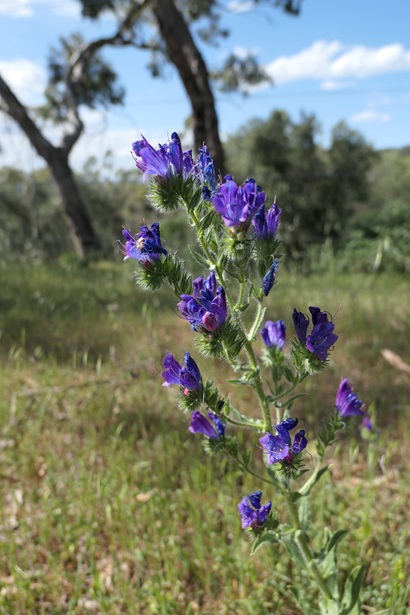 17/01/2025© melodieoll via iNaturalist / Atlas of Living Australia Creating a biosecurity crisis is shockingly simple. In the 1850s, Jane Paterson, a settler near Albury planted seeds of a European plant with an attractive purple flower in her garden. She had no way of knowing that plant would spread across southern Australia and become known as Paterson’s Curse (Echium plantagineum), a weed that’s since infested plenty of previously productive grazing pastures. About 150 years later, an unknown shipping container from the United States arrived in the Port of Brisbane. It had on board a colony of Red Imported Fire Ants (Solenopsis invicta). They had hitchhiked across an ocean before settling in Queensland. In the years since, fire ant nests have been found in an area spanning an estimated 600,000 hectares in southern Queensland, and are at risk of spreading into other states. Australia receives a huge volume of imports every year, each of which poses a risk of bringing invasive species into Australia. While a complex biosecurity system is in place at the border that blocks most invasive species, early detection of invasive pests, weeds, and fungi in the environment can further protect Australia’s biodiversity and secure important industries. Read more here
17/01/2025© melodieoll via iNaturalist / Atlas of Living Australia Creating a biosecurity crisis is shockingly simple. In the 1850s, Jane Paterson, a settler near Albury planted seeds of a European plant with an attractive purple flower in her garden. She had no way of knowing that plant would spread across southern Australia and become known as Paterson’s Curse (Echium plantagineum), a weed that’s since infested plenty of previously productive grazing pastures. About 150 years later, an unknown shipping container from the United States arrived in the Port of Brisbane. It had on board a colony of Red Imported Fire Ants (Solenopsis invicta). They had hitchhiked across an ocean before settling in Queensland. In the years since, fire ant nests have been found in an area spanning an estimated 600,000 hectares in southern Queensland, and are at risk of spreading into other states. Australia receives a huge volume of imports every year, each of which poses a risk of bringing invasive species into Australia. While a complex biosecurity system is in place at the border that blocks most invasive species, early detection of invasive pests, weeds, and fungi in the environment can further protect Australia’s biodiversity and secure important industries. Read more here -
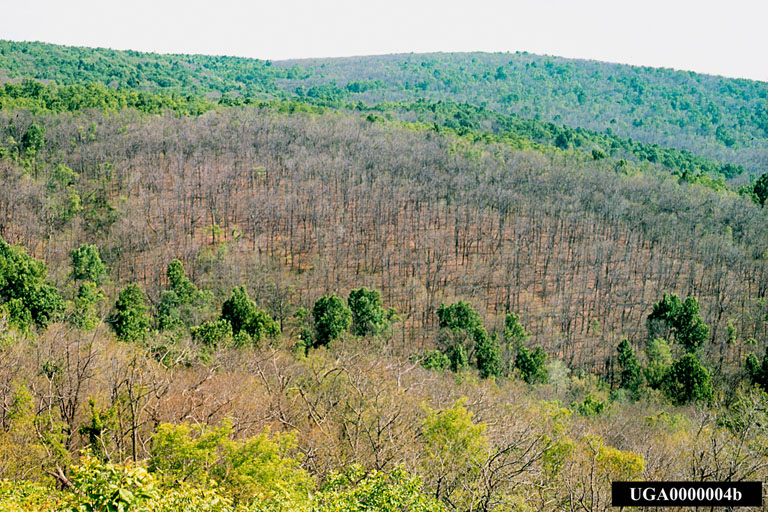 13/01/2025Image: Mark Robinson, USDA Forest Service, Bugwood.org Computer models developed by the University of Chicago and Argonne National Laboratory predict that hotter, drier conditions in North America will limit the growth of a fungus that normally curbs the spread of the spongy moth, an invasive species that has caused millions of dollars in damage to forests. The research, published in Nature Climate Change, emphasizes the importance of accounting for multiple organisms and their interactions when predicting the potential impacts of climate change, as warmer temperatures cause unexpected domino effects in ecosystems. Read more here
13/01/2025Image: Mark Robinson, USDA Forest Service, Bugwood.org Computer models developed by the University of Chicago and Argonne National Laboratory predict that hotter, drier conditions in North America will limit the growth of a fungus that normally curbs the spread of the spongy moth, an invasive species that has caused millions of dollars in damage to forests. The research, published in Nature Climate Change, emphasizes the importance of accounting for multiple organisms and their interactions when predicting the potential impacts of climate change, as warmer temperatures cause unexpected domino effects in ecosystems. Read more here -
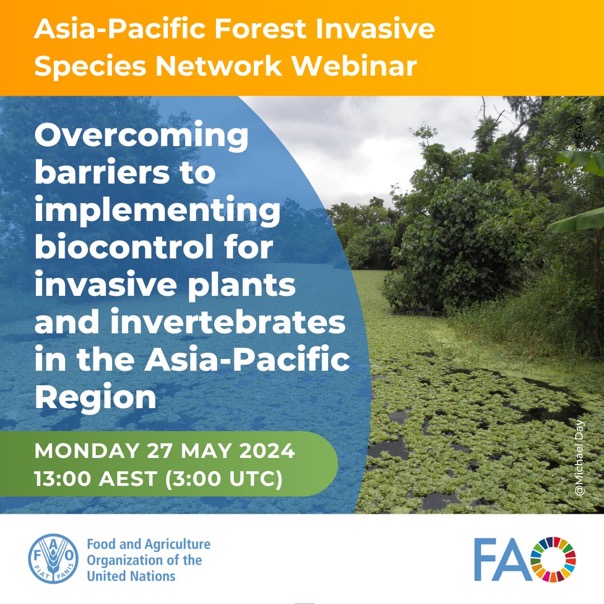 12/11/2024The Asia-Pacific Forest Invasive Species Network webinar “Overcoming barriers to implementing biocontrol for invasive plants and invertebrates in the Asia-Pacific Region” was held on the 27 May 2024. The Webinar recording can be viewed here The Webinar featured the following four presentations: “Weed Biological Control: Challenges and Opportunities” – Michael Day, Principal Entomologist (Honorary), Biosecurity Queensland “Dispelling Myths and a Bad Rap: telling the modern biological control story” – Christy Martin, Program Manager and Information Officer, Coordinating Group on Alien Pest Species, University of Hawaii at Manoa “African Tulip Tree – management and biocontrol challenges in Fiji” – Maika Lesubula, Senior Forestry Officer – Forest Health, Forestry Research & Development Division, Ministry of Forestry, Fiji “Introduction of a biocontrol agent for Leptocybe invasa in Lao PDR” – Sounaly Sommany, Deputy Director, Plant quarantine Division, Ministry of Agriculture and Forestry,Lao PDR
12/11/2024The Asia-Pacific Forest Invasive Species Network webinar “Overcoming barriers to implementing biocontrol for invasive plants and invertebrates in the Asia-Pacific Region” was held on the 27 May 2024. The Webinar recording can be viewed here The Webinar featured the following four presentations: “Weed Biological Control: Challenges and Opportunities” – Michael Day, Principal Entomologist (Honorary), Biosecurity Queensland “Dispelling Myths and a Bad Rap: telling the modern biological control story” – Christy Martin, Program Manager and Information Officer, Coordinating Group on Alien Pest Species, University of Hawaii at Manoa “African Tulip Tree – management and biocontrol challenges in Fiji” – Maika Lesubula, Senior Forestry Officer – Forest Health, Forestry Research & Development Division, Ministry of Forestry, Fiji “Introduction of a biocontrol agent for Leptocybe invasa in Lao PDR” – Sounaly Sommany, Deputy Director, Plant quarantine Division, Ministry of Agriculture and Forestry,Lao PDR -
 12/11/2024EPPO established a Network of experts working on surveillance, monitoring, and control of the Emerald ash borer, Agrilus planipennis (https://www.eppo.int/RESOURCES/special_projects/agrilus_planipennis_network). In the framework of this Network, the EPPO Panel on Quarantine Pests for Forestry agreed to organize a webinar focusing on the current distribution of A. planipennis in the EPPO region, control measures undertaken by the EPPO countries in which this pest is already present, and preparedness of other EPPO counties to possible arrival of this pest in their country in the near future. The webinar will be held on 5th December 2024, 10.00 – 13.00 (CET) via Zoom. Presentations will be given by National Plant Protection Organizations (NPPOs) of countries in which A. planipennis is present and countries located near the current limits of the distribution of this species in the EPPO region. They will share information on distribution of this pest and their preparedness for its further spread. The webinar is open to representatives of NPPOs, scientists, students, and practicians concerned about the spread of Emerald ash borer in Europe. There will be opportunities for those attending to ask questions to the speakers. To register for the webinar please follow the link: http://meeting.eppo.int/index.php/V8542 by 17.00 (CET) of 15th November (Friday). Contact point: Dmitrii Musolin: dm@eppo.int
12/11/2024EPPO established a Network of experts working on surveillance, monitoring, and control of the Emerald ash borer, Agrilus planipennis (https://www.eppo.int/RESOURCES/special_projects/agrilus_planipennis_network). In the framework of this Network, the EPPO Panel on Quarantine Pests for Forestry agreed to organize a webinar focusing on the current distribution of A. planipennis in the EPPO region, control measures undertaken by the EPPO countries in which this pest is already present, and preparedness of other EPPO counties to possible arrival of this pest in their country in the near future. The webinar will be held on 5th December 2024, 10.00 – 13.00 (CET) via Zoom. Presentations will be given by National Plant Protection Organizations (NPPOs) of countries in which A. planipennis is present and countries located near the current limits of the distribution of this species in the EPPO region. They will share information on distribution of this pest and their preparedness for its further spread. The webinar is open to representatives of NPPOs, scientists, students, and practicians concerned about the spread of Emerald ash borer in Europe. There will be opportunities for those attending to ask questions to the speakers. To register for the webinar please follow the link: http://meeting.eppo.int/index.php/V8542 by 17.00 (CET) of 15th November (Friday). Contact point: Dmitrii Musolin: dm@eppo.int -
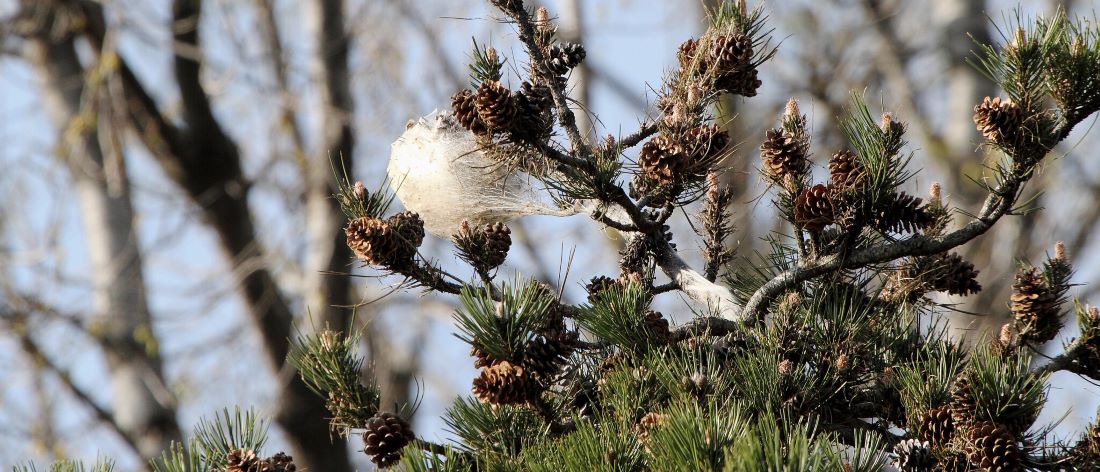 11/11/202405/11/2024 The Food and Agriculture Organization of the United Nations (FAO) today launched an updated “Guide to implementation of phytosanitary standards in forestry”, including good practices for forest health protection to help reduce the human-facilitated spread of forest pests and their impacts. The FAO publication uses plain language to describe a wide range of phytosanitary concepts and recommended practices to national and regional governments and industry stakeholders in the forest sector, including International Standards for Phytosanitary Measures. Originally published in 2011, this second edition of the guide includes an overview of new and revised standards and updated phytosanitary information and guidance that is relevant to the forest sector. International Standards for Phytosanitary Measures provide guidance to countries and governments in meeting their obligations to the International Plant Protection Convention (IPPC), an intergovernmental treaty relating to plant health, and are designed to harmonize phytosanitary measures for the purpose of facilitating international trade whilst preventing pest introduction and spread. They are crucial for safeguarding forests against the introduction and spread of harmful pests and diseases. “This updated guide will provide forest policymakers, planners, managers and workers with the knowledge and guidance they need to reduce the risk of pest spread in international trade and help protect forests and the livelihoods of forest-dependent people,” said Zhimin Wu, Director of FAO’s Forestry Division. For more information click here Download a copy of the Guide here View the promotional video here
11/11/202405/11/2024 The Food and Agriculture Organization of the United Nations (FAO) today launched an updated “Guide to implementation of phytosanitary standards in forestry”, including good practices for forest health protection to help reduce the human-facilitated spread of forest pests and their impacts. The FAO publication uses plain language to describe a wide range of phytosanitary concepts and recommended practices to national and regional governments and industry stakeholders in the forest sector, including International Standards for Phytosanitary Measures. Originally published in 2011, this second edition of the guide includes an overview of new and revised standards and updated phytosanitary information and guidance that is relevant to the forest sector. International Standards for Phytosanitary Measures provide guidance to countries and governments in meeting their obligations to the International Plant Protection Convention (IPPC), an intergovernmental treaty relating to plant health, and are designed to harmonize phytosanitary measures for the purpose of facilitating international trade whilst preventing pest introduction and spread. They are crucial for safeguarding forests against the introduction and spread of harmful pests and diseases. “This updated guide will provide forest policymakers, planners, managers and workers with the knowledge and guidance they need to reduce the risk of pest spread in international trade and help protect forests and the livelihoods of forest-dependent people,” said Zhimin Wu, Director of FAO’s Forestry Division. For more information click here Download a copy of the Guide here View the promotional video here -
 04/10/2024Don’t miss out on the side event titled “Plant Health: Why is it Crucial for the Success of One Health?” at the 29th Session of the Committee on Agriculture (COAG) on 4 October 2024 at the Sheikh Zayed Centre, FAO Headquarters, and online from 9:00 to 10:30 (CEST). This event will explore the essential role of plant health within the One Health framework, showcasing how efforts by FAO, its Members, the International Plant Protection Convention (IPPC), and the wider plant health community are reinforcing the links between human, animal, plant, and environmental health. For more information and to register, please download the flyer here
04/10/2024Don’t miss out on the side event titled “Plant Health: Why is it Crucial for the Success of One Health?” at the 29th Session of the Committee on Agriculture (COAG) on 4 October 2024 at the Sheikh Zayed Centre, FAO Headquarters, and online from 9:00 to 10:30 (CEST). This event will explore the essential role of plant health within the One Health framework, showcasing how efforts by FAO, its Members, the International Plant Protection Convention (IPPC), and the wider plant health community are reinforcing the links between human, animal, plant, and environmental health. For more information and to register, please download the flyer here -
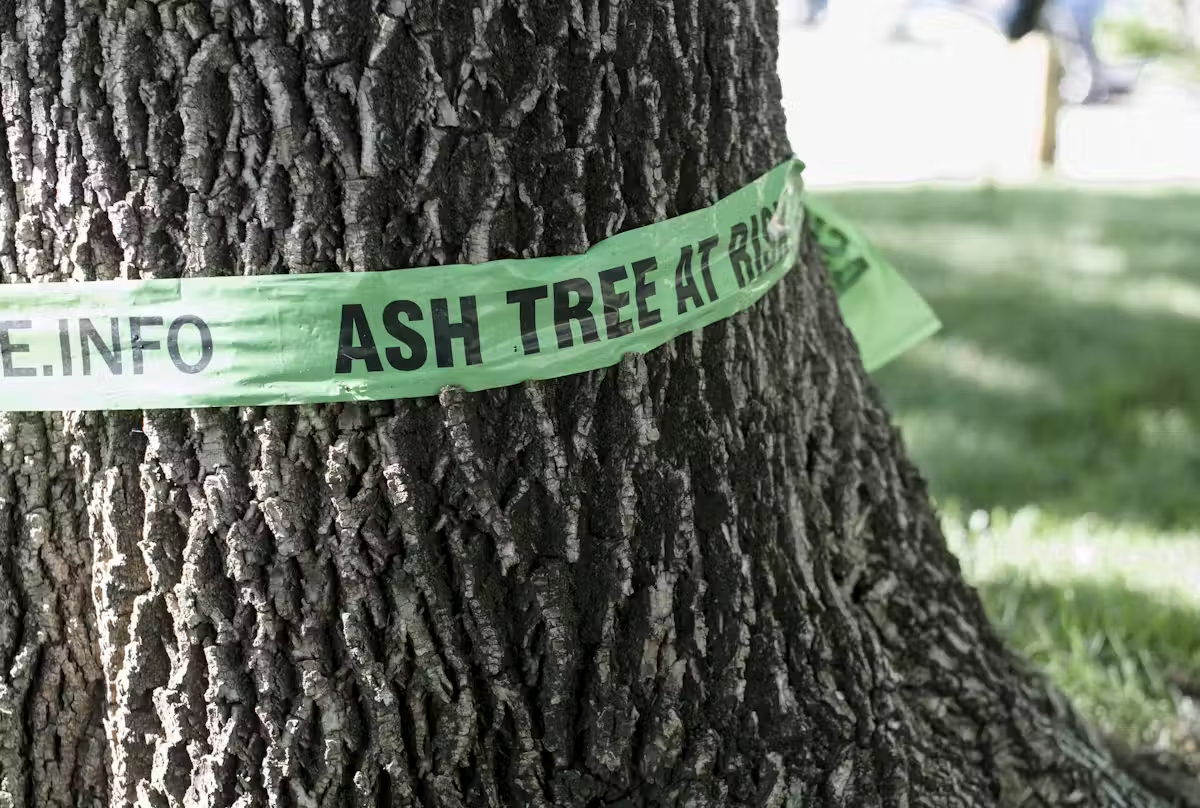 30/09/2024Invasive species are often looked upon with suspicion. From non-native “weeds” to insects and aquatic invaders, introduced (or non-native) species continue to be misunderstood— and consequently often mismanaged. Stated plainly, the vast majority of intentionally or unintentionally introduced species are not a threat to native ecosystems. Governments and conservation organizations spend an enormous amount of their time and funding targeting the control of invasive species. Yet, most introduced species removal efforts are ineffective, time-consuming and usually unsuccessful in the long term. Read more here:
30/09/2024Invasive species are often looked upon with suspicion. From non-native “weeds” to insects and aquatic invaders, introduced (or non-native) species continue to be misunderstood— and consequently often mismanaged. Stated plainly, the vast majority of intentionally or unintentionally introduced species are not a threat to native ecosystems. Governments and conservation organizations spend an enormous amount of their time and funding targeting the control of invasive species. Yet, most introduced species removal efforts are ineffective, time-consuming and usually unsuccessful in the long term. Read more here: -
 30/09/2024Effective weed control is essential for maintaining forest health. Without intervention, invasive weeds can create monocultures, reduce biodiversity, and weaken the entire ecosystem. Their unchecked growth threatens not only plants but also the animals and insects that depend on native vegetation for food and shelter. Additionally, invasive species can exacerbate the effects of climate change, making ecosystems even more vulnerable. The challenge in managing invasive species lies in their adaptability and resilience. These plants often thrive in disturbed environments, making it harder for native species to recover. Forest managers must balance maintaining natural habitats with using effective and sustainable methods to control invasive plants. Read more here:
30/09/2024Effective weed control is essential for maintaining forest health. Without intervention, invasive weeds can create monocultures, reduce biodiversity, and weaken the entire ecosystem. Their unchecked growth threatens not only plants but also the animals and insects that depend on native vegetation for food and shelter. Additionally, invasive species can exacerbate the effects of climate change, making ecosystems even more vulnerable. The challenge in managing invasive species lies in their adaptability and resilience. These plants often thrive in disturbed environments, making it harder for native species to recover. Forest managers must balance maintaining natural habitats with using effective and sustainable methods to control invasive plants. Read more here: -
 30/09/2024Videos of this series of IPPC webinars are now available to view online: 1. Climate Change and Phytosanitary Measures Global Webinar – Climate change, plants and pests Click here to view the Webinar 2. Climate Change and Phytosanitary Measures Global Webinar – Risk Assessment Click here to view the Webinar 3. Climate Change and Phytosanitary Measures Global Webinar – Pathways and Risk Management Click here to view the Webinar
30/09/2024Videos of this series of IPPC webinars are now available to view online: 1. Climate Change and Phytosanitary Measures Global Webinar – Climate change, plants and pests Click here to view the Webinar 2. Climate Change and Phytosanitary Measures Global Webinar – Risk Assessment Click here to view the Webinar 3. Climate Change and Phytosanitary Measures Global Webinar – Pathways and Risk Management Click here to view the Webinar -
 23/09/2024CLIMATE CHANGE WEBINAR SERIES – 24-26 SEPTEMBER 2024 Climate change is having an impact on ecosystems and agricultural production systems throughout the world. It influences international trade flows of plants and plant products, and it will change the infectivity, severity and distribution of plant pests throughout the world. Preventive, mitigation and adaptation measures are essential to limit the international spread of pests adapting to climate change. This webinar series aims to raise awareness and discussions on how climate change affects plant pests, and how mitigating measures can protect plant health, and ultimately safeguard food security, the environment and international trade. Topics to be covered: Webinar 1: Climate change, plants and pests 24 September 2024; 10.00 CEST (CET + 1) Register here Webinar 2: Risk assessment 25 September 2024; 15.00 CEST (CET +1) Register here Webinar 3: Pathways and risk management 26 September 2024, 10.00 CEST (CET +1) Register here Target participants: National and regional plant protection organizations including pest outbreak response experts, inspectors, administrators, pest risk analysis experts, policy developers and laboratory technicians, researchers supporting NPPOs, producer/exporter associations, extension services personnel and local government authorities
23/09/2024CLIMATE CHANGE WEBINAR SERIES – 24-26 SEPTEMBER 2024 Climate change is having an impact on ecosystems and agricultural production systems throughout the world. It influences international trade flows of plants and plant products, and it will change the infectivity, severity and distribution of plant pests throughout the world. Preventive, mitigation and adaptation measures are essential to limit the international spread of pests adapting to climate change. This webinar series aims to raise awareness and discussions on how climate change affects plant pests, and how mitigating measures can protect plant health, and ultimately safeguard food security, the environment and international trade. Topics to be covered: Webinar 1: Climate change, plants and pests 24 September 2024; 10.00 CEST (CET + 1) Register here Webinar 2: Risk assessment 25 September 2024; 15.00 CEST (CET +1) Register here Webinar 3: Pathways and risk management 26 September 2024, 10.00 CEST (CET +1) Register here Target participants: National and regional plant protection organizations including pest outbreak response experts, inspectors, administrators, pest risk analysis experts, policy developers and laboratory technicians, researchers supporting NPPOs, producer/exporter associations, extension services personnel and local government authorities -
 08/08/2024The International Workshop on Biological Control and Management of Eupatorieae and other Invasive Alien Plants will be organized under the patronage of the Kerala Forest Research Institute (KFRI), India, the International Organisation for Biological Control(IOBC), the Food and Agriculture Organization of the United Nations and the Asia-Pacific Forest Invasive Species Network. Earlier workshops in this series discussed the biological control of invasive alien plants such as Chromolaena odorata and Mikania micrantha. This workshop will evaluate the success, status and future prospects of the biological control of these species and the scope and options for biological control of the other major invasive plants widespread in the Asia-Pacific region and beyond. KFRI, the workshop venue, is located in the lap of the Western Ghats, which is one of the hotspots of biodiversity and a World Heritage Site. Invasive alien plants, especially the members of Eupatorieae and other species are widespread in most of the habitats in the region, posing significant impacts on the environment, wildlife, agriculture, and the livelihoods, especially of economically weaker communities. Climate, land-use change and forest degradation promote invasion by alien species and threats from these are predicted to increase in the future. Management of invasive alien plants in the region is mostly attempted through physical and chemical measures, which are not long-term and sustainable solutions. Biological control is considered the most suitable management approach to contain the problem, especially when the species are widespread. Download the workshop flyer here to register for further announcements Organizing Committee Mr. Michael Day (Queensland Dept. of Agriculture &Fisheries) Dr. KV Sankaran (IPBES Expert on Invasive alien species) Dr. Shiroma Sathyapala (Forestry Officer, FAO) Dr Kannan CS Warrier (Director, KFRI) For further details, please contact: Coordinating Committee: Dr P Sujanapal (sujanapal@kfri.res-in, sujanapalp@gmail.com) Dr TV Sajeev (sajeev@kfri.res.in, tvsajeev@gmail.com)
08/08/2024The International Workshop on Biological Control and Management of Eupatorieae and other Invasive Alien Plants will be organized under the patronage of the Kerala Forest Research Institute (KFRI), India, the International Organisation for Biological Control(IOBC), the Food and Agriculture Organization of the United Nations and the Asia-Pacific Forest Invasive Species Network. Earlier workshops in this series discussed the biological control of invasive alien plants such as Chromolaena odorata and Mikania micrantha. This workshop will evaluate the success, status and future prospects of the biological control of these species and the scope and options for biological control of the other major invasive plants widespread in the Asia-Pacific region and beyond. KFRI, the workshop venue, is located in the lap of the Western Ghats, which is one of the hotspots of biodiversity and a World Heritage Site. Invasive alien plants, especially the members of Eupatorieae and other species are widespread in most of the habitats in the region, posing significant impacts on the environment, wildlife, agriculture, and the livelihoods, especially of economically weaker communities. Climate, land-use change and forest degradation promote invasion by alien species and threats from these are predicted to increase in the future. Management of invasive alien plants in the region is mostly attempted through physical and chemical measures, which are not long-term and sustainable solutions. Biological control is considered the most suitable management approach to contain the problem, especially when the species are widespread. Download the workshop flyer here to register for further announcements Organizing Committee Mr. Michael Day (Queensland Dept. of Agriculture &Fisheries) Dr. KV Sankaran (IPBES Expert on Invasive alien species) Dr. Shiroma Sathyapala (Forestry Officer, FAO) Dr Kannan CS Warrier (Director, KFRI) For further details, please contact: Coordinating Committee: Dr P Sujanapal (sujanapal@kfri.res-in, sujanapalp@gmail.com) Dr TV Sajeev (sajeev@kfri.res.in, tvsajeev@gmail.com) -
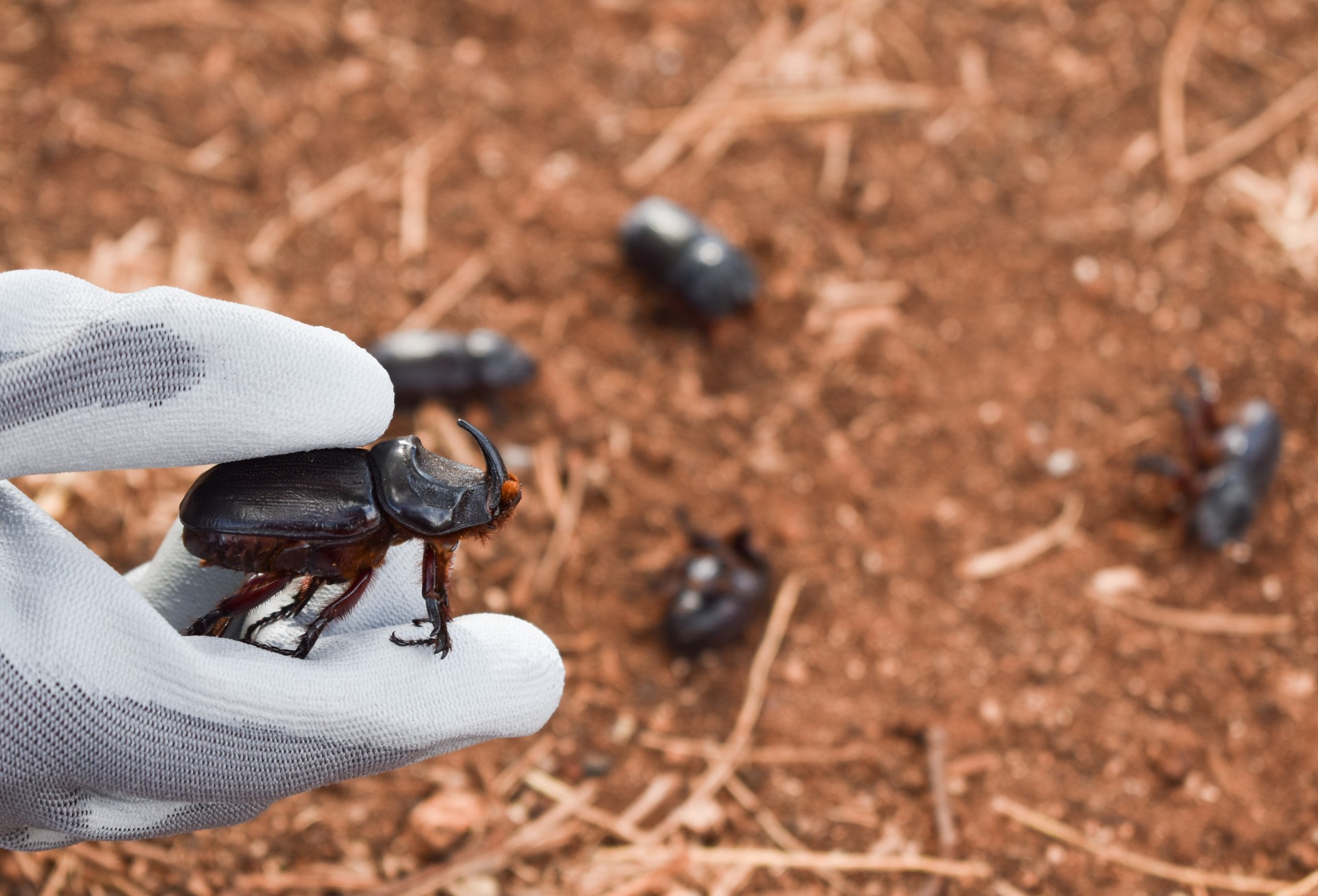 08/04/2024As Coconut Rhinoceros Beetle (Oryctes rhinoceros; CRB) populations rise across Oʻahu, the risk for accidental transport of CRB has increased. Historically, human-vectored spread has been the main contributor to the geographic spread of CRB. With increased inter-island movement of commodities, the risk of transporting CRB off Oʻahu to neighboring islands has become more imminent, and increased diligence is needed. The commitment to prevent the spread of CRB will be a community-wide effort. Implementing best management practices is crucial for the protection of Hawaiiʻs ecosystems, industries, and communities. In addition to the adoption of best practices, HDOA has also established a new rule to regulate the movement of high-risk material off Oʻahu. Read more here
08/04/2024As Coconut Rhinoceros Beetle (Oryctes rhinoceros; CRB) populations rise across Oʻahu, the risk for accidental transport of CRB has increased. Historically, human-vectored spread has been the main contributor to the geographic spread of CRB. With increased inter-island movement of commodities, the risk of transporting CRB off Oʻahu to neighboring islands has become more imminent, and increased diligence is needed. The commitment to prevent the spread of CRB will be a community-wide effort. Implementing best management practices is crucial for the protection of Hawaiiʻs ecosystems, industries, and communities. In addition to the adoption of best practices, HDOA has also established a new rule to regulate the movement of high-risk material off Oʻahu. Read more here -
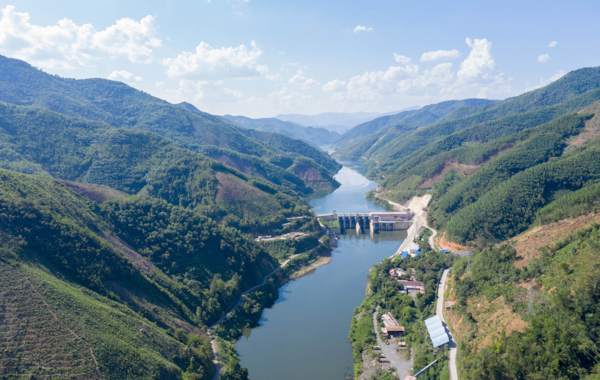 03/04/2024A World Wildlife Fund report has revealed that 19% of the Mekong River’s fish are threatened with extinction. Named Mekong’s Forgotten Fishes, the WWF joint report found that there are at least 1,148 fish species in the Mekong River, making it the world’s third most diverse river after the Congo and Amazon River systems, but that up to 1 in 5 species are already threatened with extinction. World’s largest inland fishery The Mighty Mekong River is a record breaker, being home to the largest giant freshwater stingray (Urogymnus polylepis), the Mekong giant catfish (Pangasianodon gigas) and the giant barb (Catlocarpio siamensis). Every year it hosts one of the world’s largest freshwater fish migrations with an estimated 5 billion fish migrating, but those fish are caught and eaten by at least 40 million people, accounting for at least 15% of the entire global inland fish catch. The fishery has been valued at $11 billion, but the WWF report has found it just isn’t sustainable. Read more here
03/04/2024A World Wildlife Fund report has revealed that 19% of the Mekong River’s fish are threatened with extinction. Named Mekong’s Forgotten Fishes, the WWF joint report found that there are at least 1,148 fish species in the Mekong River, making it the world’s third most diverse river after the Congo and Amazon River systems, but that up to 1 in 5 species are already threatened with extinction. World’s largest inland fishery The Mighty Mekong River is a record breaker, being home to the largest giant freshwater stingray (Urogymnus polylepis), the Mekong giant catfish (Pangasianodon gigas) and the giant barb (Catlocarpio siamensis). Every year it hosts one of the world’s largest freshwater fish migrations with an estimated 5 billion fish migrating, but those fish are caught and eaten by at least 40 million people, accounting for at least 15% of the entire global inland fish catch. The fishery has been valued at $11 billion, but the WWF report has found it just isn’t sustainable. Read more here -
 03/04/2024Roots of Resilience tells a story of the importance of environmental biosecurity, and what is at risk of being lost due to the threats posed by Myrtle rust. The film gives voice to First Nations’ perspectives, connections and concerns around forests and forest health. First Nations people have lived in harmony with this country for thousands of years. This video describes our need to share knowledge and walk together to protect what we love. It highlights the importance of forests to people, culture and ecosystems both here and abroad. The film was produced in collaboration with the Australian Department of Agriculture, Fisheries and Forestry’s Environmental Biosecurity Office through the Environmental Biosecurity Project Fund, the Queensland and NSW governments, Aboriginal communities and partners in Aotearoa, New Zealand. It was filmed and produced by ThunderBox films across various locations including Coffs Harbour, Bunya Mountains and Cairns. To the view the film click here
03/04/2024Roots of Resilience tells a story of the importance of environmental biosecurity, and what is at risk of being lost due to the threats posed by Myrtle rust. The film gives voice to First Nations’ perspectives, connections and concerns around forests and forest health. First Nations people have lived in harmony with this country for thousands of years. This video describes our need to share knowledge and walk together to protect what we love. It highlights the importance of forests to people, culture and ecosystems both here and abroad. The film was produced in collaboration with the Australian Department of Agriculture, Fisheries and Forestry’s Environmental Biosecurity Office through the Environmental Biosecurity Project Fund, the Queensland and NSW governments, Aboriginal communities and partners in Aotearoa, New Zealand. It was filmed and produced by ThunderBox films across various locations including Coffs Harbour, Bunya Mountains and Cairns. To the view the film click here -
 03/04/2024Every weekend, thousands of citizen scientists head into the great outdoors. If they see an unusual animal, plant or fungi, they take a photo and upload it. This simple act by bushwalkers with smartphones is, in aggregate, increasingly valuable to researchers. Half of all records uploaded to Australia’s largest open-data aggregator, the Atlas of Living Australia, now come from citizen scientists – and this number is likely to keep growing. Citizen science isn’t just useful in gauging how native species are going. Curious eyes spot invasive species too. The first sighting of the invasive buff-tailed bumble bee (Bombus terrestris) in Victoria was reported by a citizen scientist last year. The first discovery of a virus which turns woodlice (slaters) iridescent purple came from a citizen scientist. To date, reports from citizen scientists strongly favour native species. But as we grapple with damaging new invasive species, we need much more data. Read more here
03/04/2024Every weekend, thousands of citizen scientists head into the great outdoors. If they see an unusual animal, plant or fungi, they take a photo and upload it. This simple act by bushwalkers with smartphones is, in aggregate, increasingly valuable to researchers. Half of all records uploaded to Australia’s largest open-data aggregator, the Atlas of Living Australia, now come from citizen scientists – and this number is likely to keep growing. Citizen science isn’t just useful in gauging how native species are going. Curious eyes spot invasive species too. The first sighting of the invasive buff-tailed bumble bee (Bombus terrestris) in Victoria was reported by a citizen scientist last year. The first discovery of a virus which turns woodlice (slaters) iridescent purple came from a citizen scientist. To date, reports from citizen scientists strongly favour native species. But as we grapple with damaging new invasive species, we need much more data. Read more here -
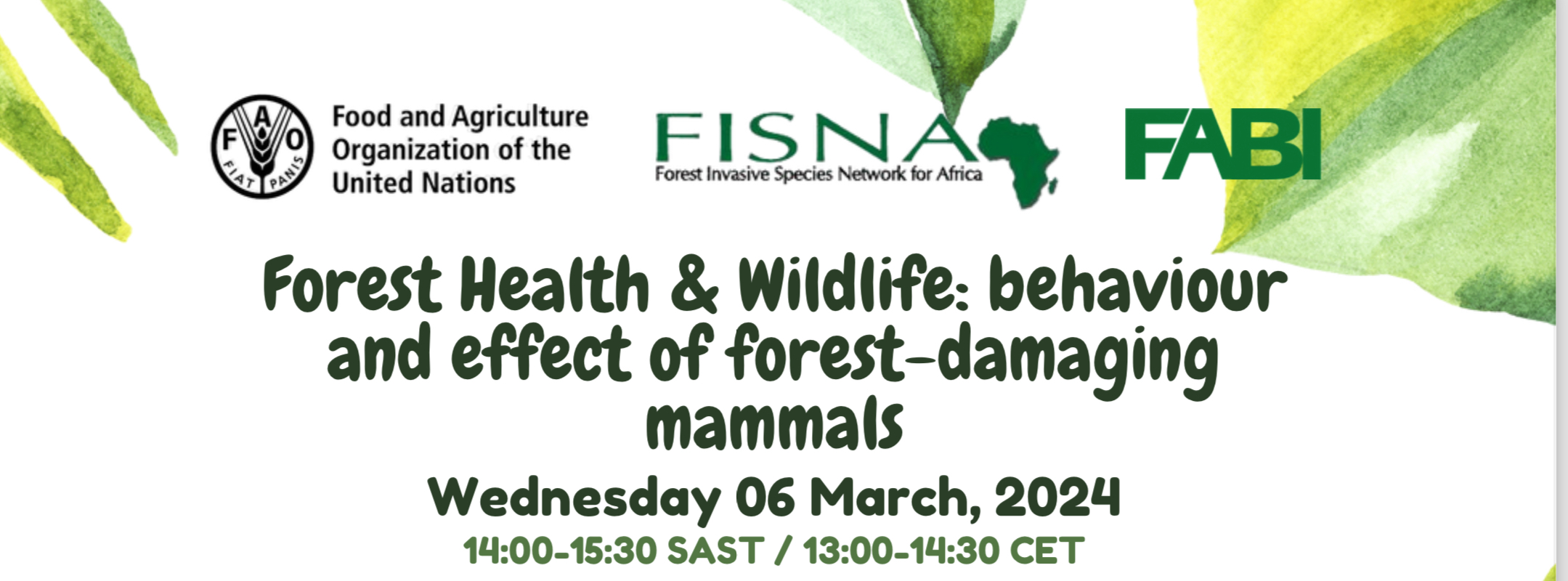 01/03/2024You are cordially invited to a webinar organized by the Forest Invasive Species Network in Africa (FISNA), entitled “Forest Health and Wildlife: Behavior and Effects of Forest Damaging Mammals“. At this event, you will have the unique opportunity to learn about the experiences of colleagues in both Africa and Latin America, who will share their knowledge on mammals that negatively affect forests, addressing key aspects such as the behavior and effects of their actions on forest ecosystems. 🗓 Date: Wednesday, 06 March 🕒 Time: 14:00 – 15:30 SAST / 13:00 – 14:30 CET/12 📍Platform: Zoom 🔗 Register Here: [https://fao.zoom.us/webinar/register/WN_KXIkdYenTEqS2zNq2Bt5mQ] 🌐 This webinar will take place in English & French For more information on speakers and topics, see the flyer here! see the flyer here! Spread the word! Invite your colleagues to join in and gain insights into the delicate balance of our ecosystems. Don’t miss out—secure your spot now!
01/03/2024You are cordially invited to a webinar organized by the Forest Invasive Species Network in Africa (FISNA), entitled “Forest Health and Wildlife: Behavior and Effects of Forest Damaging Mammals“. At this event, you will have the unique opportunity to learn about the experiences of colleagues in both Africa and Latin America, who will share their knowledge on mammals that negatively affect forests, addressing key aspects such as the behavior and effects of their actions on forest ecosystems. 🗓 Date: Wednesday, 06 March 🕒 Time: 14:00 – 15:30 SAST / 13:00 – 14:30 CET/12 📍Platform: Zoom 🔗 Register Here: [https://fao.zoom.us/webinar/register/WN_KXIkdYenTEqS2zNq2Bt5mQ] 🌐 This webinar will take place in English & French For more information on speakers and topics, see the flyer here! see the flyer here! Spread the word! Invite your colleagues to join in and gain insights into the delicate balance of our ecosystems. Don’t miss out—secure your spot now! -
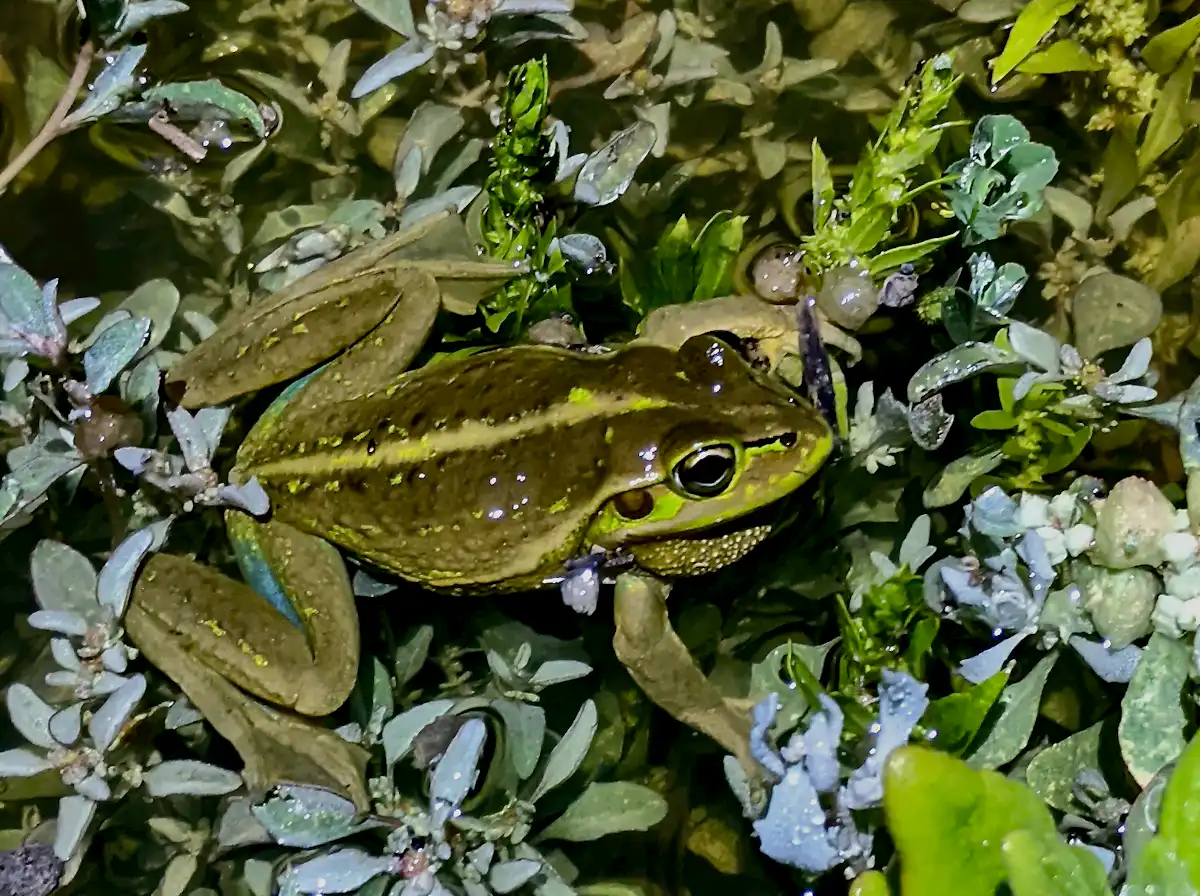 26/02/2024Australia is home to about one in 12 of the world’s species of animals, birds, plants and insects – between 600,000 and 700,000 species. More than 80% of Australian plants and mammals and just under 50% of our birds are found nowhere else. But habitat destruction, climate change, and invasive species are wreaking havoc on Earth’s rich biodiversity, and Australia is no exception. In 2023, the federal government added another 144 plants, animals and ecological communities to the threatened species list – including iconic species such as the pink cockatoo, spiny crayfish and earless dragons. More and more species stand on the edge of oblivion. That’s just the ones we know enough about to list formally as threatened. Many more are in trouble, especially in the oceans. Change is the new constant. As the world heats up and ecosystems warp, new combinations of species can emerge without an evolutionary connection, creating novel communities. Read more here
26/02/2024Australia is home to about one in 12 of the world’s species of animals, birds, plants and insects – between 600,000 and 700,000 species. More than 80% of Australian plants and mammals and just under 50% of our birds are found nowhere else. But habitat destruction, climate change, and invasive species are wreaking havoc on Earth’s rich biodiversity, and Australia is no exception. In 2023, the federal government added another 144 plants, animals and ecological communities to the threatened species list – including iconic species such as the pink cockatoo, spiny crayfish and earless dragons. More and more species stand on the edge of oblivion. That’s just the ones we know enough about to list formally as threatened. Many more are in trouble, especially in the oceans. Change is the new constant. As the world heats up and ecosystems warp, new combinations of species can emerge without an evolutionary connection, creating novel communities. Read more here -
 21/12/2023Early identification and delineation of harmful insects and diseases are important so that prompt action can be taken to mitigate their impacts. Over the last two decades, pinewood nematode (PWN), a destructive disease of pine forests, has caused significant mortality to many forests in northeast Asia and southern Europe prompting a global quarantine alert, which is affecting international trade. Pinewood nematode is vectored by cerambycid beetles (Monochamus spp.), which are the causal agents for spreading pine wilt disease (PWD). As more research is conducted and experience gained by PWN affected countries, valuable tools are being developed to help survey, identify, and manage PWN. With this in mind the Asia-Pacific Forest Invasive Species Network (APFISN), along with the Nanjing Forestry University, The International Society of Zoological Sciences, Chinese Academy of Sciences, and the Food and Agricultural Organization of the United Nations held a workshop on the identification, biology, and management of pine wilt disease (PWD) in Nanjing, China from October 23-27, 2023. Additional support was provided by the United States Forest Service, Chinese Forest and Grasslands Administration, and the University of the Sunshine Coast. The purpose of the workshop was to provide participants with hands on knowledge to identify PWD symptoms in the field, isolate and identify pinewood nematode (causal agent for PWD) morphologically using a microscope, and detect and identify pinewood nematode through molecular techniques. Additionally, participants learned about the general biology, ecology, and management of PWD; including PWN and vector lifecycles, known distribution, and control measures for PWD. Participants also attended the IUFRO Symposium on Pine Wilt Disease “The Prevention, Theory, Technology and Management of Pine Wilt Disease”, where they were able to interact with international colleagues active in the research and management of PWD. Following are photos of participants in action, gaining skills to identify and detect PWN and the disease it causes. Learning About Pine Wilt Disease in the Field and Classroom Searching for Pinewood Nematode Under a Microscope Isolating Pinewood Nematode From Wood Samples Pinewood Nematode Found, Now Lets Extract some DNA Attending the 2023 IUFRO Symposium on Pine Wilt Disease Discussing What We Learned We Made It!!!
21/12/2023Early identification and delineation of harmful insects and diseases are important so that prompt action can be taken to mitigate their impacts. Over the last two decades, pinewood nematode (PWN), a destructive disease of pine forests, has caused significant mortality to many forests in northeast Asia and southern Europe prompting a global quarantine alert, which is affecting international trade. Pinewood nematode is vectored by cerambycid beetles (Monochamus spp.), which are the causal agents for spreading pine wilt disease (PWD). As more research is conducted and experience gained by PWN affected countries, valuable tools are being developed to help survey, identify, and manage PWN. With this in mind the Asia-Pacific Forest Invasive Species Network (APFISN), along with the Nanjing Forestry University, The International Society of Zoological Sciences, Chinese Academy of Sciences, and the Food and Agricultural Organization of the United Nations held a workshop on the identification, biology, and management of pine wilt disease (PWD) in Nanjing, China from October 23-27, 2023. Additional support was provided by the United States Forest Service, Chinese Forest and Grasslands Administration, and the University of the Sunshine Coast. The purpose of the workshop was to provide participants with hands on knowledge to identify PWD symptoms in the field, isolate and identify pinewood nematode (causal agent for PWD) morphologically using a microscope, and detect and identify pinewood nematode through molecular techniques. Additionally, participants learned about the general biology, ecology, and management of PWD; including PWN and vector lifecycles, known distribution, and control measures for PWD. Participants also attended the IUFRO Symposium on Pine Wilt Disease “The Prevention, Theory, Technology and Management of Pine Wilt Disease”, where they were able to interact with international colleagues active in the research and management of PWD. Following are photos of participants in action, gaining skills to identify and detect PWN and the disease it causes. Learning About Pine Wilt Disease in the Field and Classroom Searching for Pinewood Nematode Under a Microscope Isolating Pinewood Nematode From Wood Samples Pinewood Nematode Found, Now Lets Extract some DNA Attending the 2023 IUFRO Symposium on Pine Wilt Disease Discussing What We Learned We Made It!!! -
 20/12/2023By Dr. Jithu U. Krishnan (Ph.D., FIISc), Forest Health Division, Kerala Forest Research Institute, Government of Kerala It was a tremendous honour for me to participate in a workshop organised by the APFISN Working Group, with a strong emphasis on capacity building for invasive management in the forests of the Asia-Pacific region, namely the APFISN and the International Society of Zoological Sciences. I want to highlight the exceptional execution of the program by Nanjing Forestry University, which surpassed any previous experiences I’ve had. Additionally, I express my gratitude for the generous financial support and operational efficiency provided by the program sponsors, who are leaders in fostering a global scientific mind-set. Attending my first international workshop was a truly enriching experience, and I am thankful for the opportunity. I was able to make significant academic contributions and benefited greatly from the diverse perspectives of fellow participants representing nine different countries. These individuals are actively engaged in their respective nations’ forest and forestry research, making the workshop a valuable platform for collaboration and knowledge exchange. On the initial day of the six-day training workshop focused on ‘Identifying, Detecting, and Managing Pine Wood Nematode,’ Prof. Jian-Ren Ye and Prof. Jiang-Hua Sun effectively conveyed the gravity of the issues associated with the Pine Wood Nematode (PWN). As someone hailing from the Western Ghats of India, my eagerness to explore China’s subtropical pine plantations, particularly in Jurong, Jiangsu province, was palpable. However, these plantations differed significantly from the forest and plantation concepts in my home country. During the field sessions, Prof. Li-Hua Zhu provided insights into detecting PWN infestations in the field. We were organized into groups of three, to independently identify potentially infested trees. Witnessing the cutting down of an infested tree allowed us to observe the larval stage of the PWN vector, the Monochamus alternatus, for the first time. Our group collected wood samples for the laboratory work scheduled for the following days. Field visit to Jurong, Jiangsu Province At the conclusion of the initial day, companionship among all participants flourished, transforming us into a dynamic and engaged group, thanks to the warm and inclusive approach of Dr. Shiroma Sathyapala and Dr. Gary Man. On the same day, we engaged in cutting infested wood, with my lackluster kitchen skills causing a bit of a stir. Our visit to the Forest Health department’s laboratory at the College of Forestry and Grassland paved the way for the upcoming laboratory work. Dr. Shiroma and her affection towards nature The anticipation of observing nematodes, which brought us together in China, heightened on the second day. By this time, I had forged connections with some Chinese friends, notably Zun, a postgraduate student, who actively guided us around the university and occasionally provided instructions for local shopping. Returning to the workbench on day two, we delved into the use of a compound microscope, with Prof. Zhu and Prof. Jia-Jin Tan elucidating the process of nematode extraction from wood and its identification. Sketching three different PWN species and morphological identification were also part of the day’s activities. Shiroma, as a diligent student and organizer, ensured comprehensive knowledge transfer, fostering active discussions that illuminated the intricate yet fascinating life story of PWN infestation. Lab works with Prof. Zhu Prior to this workshop, my experience as a junior scientist in India exposed me to dealing with pest attacks on bulk-imported pine woods from the US, Africa, and China. While PWN infestation is currently confined to the sub-tropics, the risk of its spread in the context of climate change or pest adaptation cannot be overlooked. Quarantine practices in India, often compromised, need reinforcement in practice. The lecture on ‘Implementation of phytosanitary measures to reduce the spread of Pine Wood Disease’ provided valuable insights into effective plant quarantine checkpoints. Mr. Zun demonstrating tree injection In the subsequent days of the workshop, our confidence grew in identifying infestation symptoms, extracting and identifying nematodes through both morphological and molecular methods, and exploring various control techniques. The tree-injection method demonstrated by Prof. Zhu and her students expanded my knowledge base. Both automatic and manual curative injection treatments were adeptly showcased on a pine tree within the NFU campus. Inside the NFU Library On October 26th, we actively participated in the IUFRO Pine Wilt Disease International Symposium. The sales exhibitions during the workshop presented opportunities to explore various pest and disease management devices and formulations, many of which are innovative and could be adopted in our country. A visit to the Insect Collection and Insectarium of Zhongshan Scenic Area, Nanjing, left me inspired to enhance the insect collection in my institution, KFRI. Insect collection and Insectarium of Zhongshan Scenic Area, Nanjing As I reflect on the conference, I carry home several action plans for the coming year, including developing a robust understanding of existing quarantine policies and recommendations in India, examining whether longhorn beetles in my state carry any phytopathogenic nematode, monitoring the invasion of any Monochamus species in nearby softwood-importing mills, and exploring the possibilities of stakeholder meetings to improve current quarantine practices. Butterfly specimens in its habitat display I would like to express my heartfelt thanks to the organizers, hosts, sponsors, and supporting partners who played a crucial role in bringing the APFISN training workshop to fruition! My gratitude knows no bounds for all the speakers who generously shared their experiences and knowledge with us. To my fellow participants, I look forward to future collaborations as we continue working together.
20/12/2023By Dr. Jithu U. Krishnan (Ph.D., FIISc), Forest Health Division, Kerala Forest Research Institute, Government of Kerala It was a tremendous honour for me to participate in a workshop organised by the APFISN Working Group, with a strong emphasis on capacity building for invasive management in the forests of the Asia-Pacific region, namely the APFISN and the International Society of Zoological Sciences. I want to highlight the exceptional execution of the program by Nanjing Forestry University, which surpassed any previous experiences I’ve had. Additionally, I express my gratitude for the generous financial support and operational efficiency provided by the program sponsors, who are leaders in fostering a global scientific mind-set. Attending my first international workshop was a truly enriching experience, and I am thankful for the opportunity. I was able to make significant academic contributions and benefited greatly from the diverse perspectives of fellow participants representing nine different countries. These individuals are actively engaged in their respective nations’ forest and forestry research, making the workshop a valuable platform for collaboration and knowledge exchange. On the initial day of the six-day training workshop focused on ‘Identifying, Detecting, and Managing Pine Wood Nematode,’ Prof. Jian-Ren Ye and Prof. Jiang-Hua Sun effectively conveyed the gravity of the issues associated with the Pine Wood Nematode (PWN). As someone hailing from the Western Ghats of India, my eagerness to explore China’s subtropical pine plantations, particularly in Jurong, Jiangsu province, was palpable. However, these plantations differed significantly from the forest and plantation concepts in my home country. During the field sessions, Prof. Li-Hua Zhu provided insights into detecting PWN infestations in the field. We were organized into groups of three, to independently identify potentially infested trees. Witnessing the cutting down of an infested tree allowed us to observe the larval stage of the PWN vector, the Monochamus alternatus, for the first time. Our group collected wood samples for the laboratory work scheduled for the following days. Field visit to Jurong, Jiangsu Province At the conclusion of the initial day, companionship among all participants flourished, transforming us into a dynamic and engaged group, thanks to the warm and inclusive approach of Dr. Shiroma Sathyapala and Dr. Gary Man. On the same day, we engaged in cutting infested wood, with my lackluster kitchen skills causing a bit of a stir. Our visit to the Forest Health department’s laboratory at the College of Forestry and Grassland paved the way for the upcoming laboratory work. Dr. Shiroma and her affection towards nature The anticipation of observing nematodes, which brought us together in China, heightened on the second day. By this time, I had forged connections with some Chinese friends, notably Zun, a postgraduate student, who actively guided us around the university and occasionally provided instructions for local shopping. Returning to the workbench on day two, we delved into the use of a compound microscope, with Prof. Zhu and Prof. Jia-Jin Tan elucidating the process of nematode extraction from wood and its identification. Sketching three different PWN species and morphological identification were also part of the day’s activities. Shiroma, as a diligent student and organizer, ensured comprehensive knowledge transfer, fostering active discussions that illuminated the intricate yet fascinating life story of PWN infestation. Lab works with Prof. Zhu Prior to this workshop, my experience as a junior scientist in India exposed me to dealing with pest attacks on bulk-imported pine woods from the US, Africa, and China. While PWN infestation is currently confined to the sub-tropics, the risk of its spread in the context of climate change or pest adaptation cannot be overlooked. Quarantine practices in India, often compromised, need reinforcement in practice. The lecture on ‘Implementation of phytosanitary measures to reduce the spread of Pine Wood Disease’ provided valuable insights into effective plant quarantine checkpoints. Mr. Zun demonstrating tree injection In the subsequent days of the workshop, our confidence grew in identifying infestation symptoms, extracting and identifying nematodes through both morphological and molecular methods, and exploring various control techniques. The tree-injection method demonstrated by Prof. Zhu and her students expanded my knowledge base. Both automatic and manual curative injection treatments were adeptly showcased on a pine tree within the NFU campus. Inside the NFU Library On October 26th, we actively participated in the IUFRO Pine Wilt Disease International Symposium. The sales exhibitions during the workshop presented opportunities to explore various pest and disease management devices and formulations, many of which are innovative and could be adopted in our country. A visit to the Insect Collection and Insectarium of Zhongshan Scenic Area, Nanjing, left me inspired to enhance the insect collection in my institution, KFRI. Insect collection and Insectarium of Zhongshan Scenic Area, Nanjing As I reflect on the conference, I carry home several action plans for the coming year, including developing a robust understanding of existing quarantine policies and recommendations in India, examining whether longhorn beetles in my state carry any phytopathogenic nematode, monitoring the invasion of any Monochamus species in nearby softwood-importing mills, and exploring the possibilities of stakeholder meetings to improve current quarantine practices. Butterfly specimens in its habitat display I would like to express my heartfelt thanks to the organizers, hosts, sponsors, and supporting partners who played a crucial role in bringing the APFISN training workshop to fruition! My gratitude knows no bounds for all the speakers who generously shared their experiences and knowledge with us. To my fellow participants, I look forward to future collaborations as we continue working together. -
 Myrtle rust is devastating Australian forests. A new high-tech spray holds out hope for native treesMyrtle rust is devastating Australian forests. A new high-tech spray holds out hope for native trees16/12/2023Around a decade ago, an invasive fungal disease called myrtle rust reached Australia and began to spread like a plague through certain plants. The disease affects plants of the Myrtaceae family, which includes eucalypts, paperbarks and lilly pillies, and makes up 10% of Australian plant biodiversity/ In only a few years, myrtle rust has changed ecosystems by destroying trees and their canopies, wiped out whole species in certain areas, and taken an economic toll on industries that grow trees such as lemon-scented myrtle and tea tree. The disease is a slow-moving ecological wrecking ball: surveys suggest it may drive at least 16 species of rainforest tree to extinction in the wild within a generation, with another 20 species at risk. We have used RNA technology similar to that in COVID vaccines to create a highly targeted treatment for myrtle rust: a spray that can restore even severely infected trees to health in around six weeks. Read more here
Myrtle rust is devastating Australian forests. A new high-tech spray holds out hope for native treesMyrtle rust is devastating Australian forests. A new high-tech spray holds out hope for native trees16/12/2023Around a decade ago, an invasive fungal disease called myrtle rust reached Australia and began to spread like a plague through certain plants. The disease affects plants of the Myrtaceae family, which includes eucalypts, paperbarks and lilly pillies, and makes up 10% of Australian plant biodiversity/ In only a few years, myrtle rust has changed ecosystems by destroying trees and their canopies, wiped out whole species in certain areas, and taken an economic toll on industries that grow trees such as lemon-scented myrtle and tea tree. The disease is a slow-moving ecological wrecking ball: surveys suggest it may drive at least 16 species of rainforest tree to extinction in the wild within a generation, with another 20 species at risk. We have used RNA technology similar to that in COVID vaccines to create a highly targeted treatment for myrtle rust: a spray that can restore even severely infected trees to health in around six weeks. Read more here -
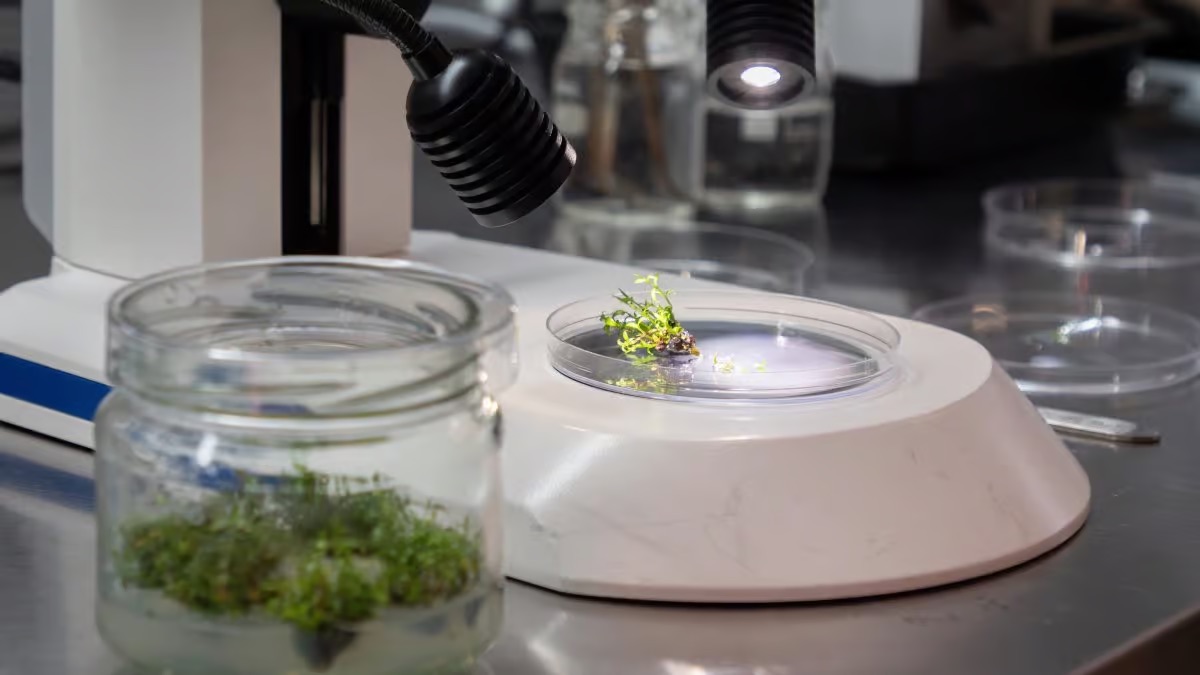 10/11/2023Researchers are hurrying to cryogenically preserve critically endangered plants at risk due to myrtle rust. Some of the species from the Myrtaceae family are at risk of going extinct in the wild within generations. “Myrtle rust affects the ability of the worst impacted species to reproduce and some of these species are no longer producing seed in the wild,” said University of Queensland plant molecular physiologist Dr Alice Hayward. “On top of this, seeds from affected rainforest species often cannot be stored in a seed bank as they don’t survive the standard drying or freezing processes.” Scientists outlined their approach in paper Plants. “Many species have been cultivated for their timber, oils, or fruits and are economically valuable both within their country of origin and in plantations around the world,” the researchers write. “On-going impacts of land clearing, a changing climate, and myrtle rust on this family mean there is a growing need to conserve species and cultivars.” Read more here
10/11/2023Researchers are hurrying to cryogenically preserve critically endangered plants at risk due to myrtle rust. Some of the species from the Myrtaceae family are at risk of going extinct in the wild within generations. “Myrtle rust affects the ability of the worst impacted species to reproduce and some of these species are no longer producing seed in the wild,” said University of Queensland plant molecular physiologist Dr Alice Hayward. “On top of this, seeds from affected rainforest species often cannot be stored in a seed bank as they don’t survive the standard drying or freezing processes.” Scientists outlined their approach in paper Plants. “Many species have been cultivated for their timber, oils, or fruits and are economically valuable both within their country of origin and in plantations around the world,” the researchers write. “On-going impacts of land clearing, a changing climate, and myrtle rust on this family mean there is a growing need to conserve species and cultivars.” Read more here -
 10/11/2023The world no longer has the gastric-brooding frog, the pig-footed bandicoot or the blue-tailed skink in the wild. But these Australian species didn’t disappear 100 years ago – the losses are much more recent. To raise awareness of what has so recently been lost, biologist Tim Low has co-authored a report that lists, like a eulogy, the 23 native animals lost since the 1960s. Australia is missing more mammals than any other continent, but the list goes on, including frogs, lizards, fish, insects and plants. Titled Gone: Australian Animals Extinct Since the 1960s, the report cites the work of 10 biologists who in 2019 found that since colonisation, of the 100 extinct species studied, 36 were killed off by land clearing. And while climate change, fire, pollution and other ecological hazards also played a role, nothing matched the exterminating force of invasive species and diseases – which claimed 45 of the 100 extinct species Read more here
10/11/2023The world no longer has the gastric-brooding frog, the pig-footed bandicoot or the blue-tailed skink in the wild. But these Australian species didn’t disappear 100 years ago – the losses are much more recent. To raise awareness of what has so recently been lost, biologist Tim Low has co-authored a report that lists, like a eulogy, the 23 native animals lost since the 1960s. Australia is missing more mammals than any other continent, but the list goes on, including frogs, lizards, fish, insects and plants. Titled Gone: Australian Animals Extinct Since the 1960s, the report cites the work of 10 biologists who in 2019 found that since colonisation, of the 100 extinct species studied, 36 were killed off by land clearing. And while climate change, fire, pollution and other ecological hazards also played a role, nothing matched the exterminating force of invasive species and diseases – which claimed 45 of the 100 extinct species Read more here -
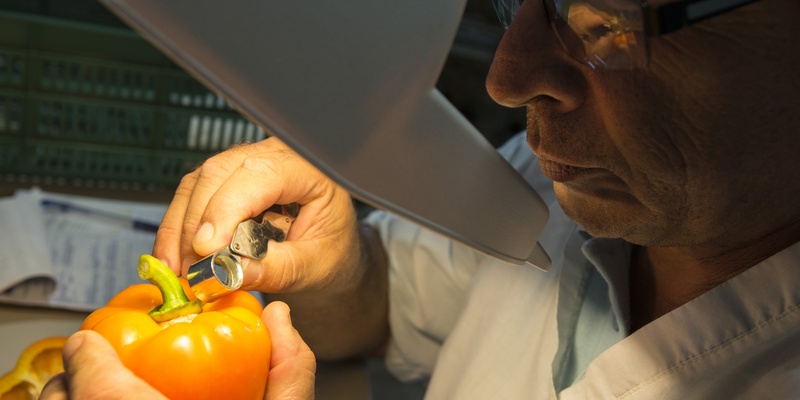 26/09/2023The International Plant Protection Convention (IPPC) Secretariat, in conjunction with regional plant protection organizations (RPPOs), has commenced the 2023 annual IPPC regional workshops, to engage contracting parties on the strategic work of the secretariat, particularly to strengthen countries’ phytosanitary capacity. Held under the theme: “Plant health and environmental protection”, the 2023 regional workshops will provide a platform for stakeholders to exchange ideas, information and experiences at the regional level, while also strengthening collaboration for plant health. Read more here
26/09/2023The International Plant Protection Convention (IPPC) Secretariat, in conjunction with regional plant protection organizations (RPPOs), has commenced the 2023 annual IPPC regional workshops, to engage contracting parties on the strategic work of the secretariat, particularly to strengthen countries’ phytosanitary capacity. Held under the theme: “Plant health and environmental protection”, the 2023 regional workshops will provide a platform for stakeholders to exchange ideas, information and experiences at the regional level, while also strengthening collaboration for plant health. Read more here -
 16/09/2023Invasive alien species are spreading around the world at “unprecedented and increasing rates”, according to a landmark new report from the Intergovernmental Platform on Biodiversity and Ecosystem Services (IPBES). It warns that, using conservative estimates, biological invasions cost the world US$423bn per year – a number that has risen fourfold since the 1970s. And under a “business-as-usual” scenario, the total number of alien species is projected to increase by more than a third by 2050. Read more here
16/09/2023Invasive alien species are spreading around the world at “unprecedented and increasing rates”, according to a landmark new report from the Intergovernmental Platform on Biodiversity and Ecosystem Services (IPBES). It warns that, using conservative estimates, biological invasions cost the world US$423bn per year – a number that has risen fourfold since the 1970s. And under a “business-as-usual” scenario, the total number of alien species is projected to increase by more than a third by 2050. Read more here -
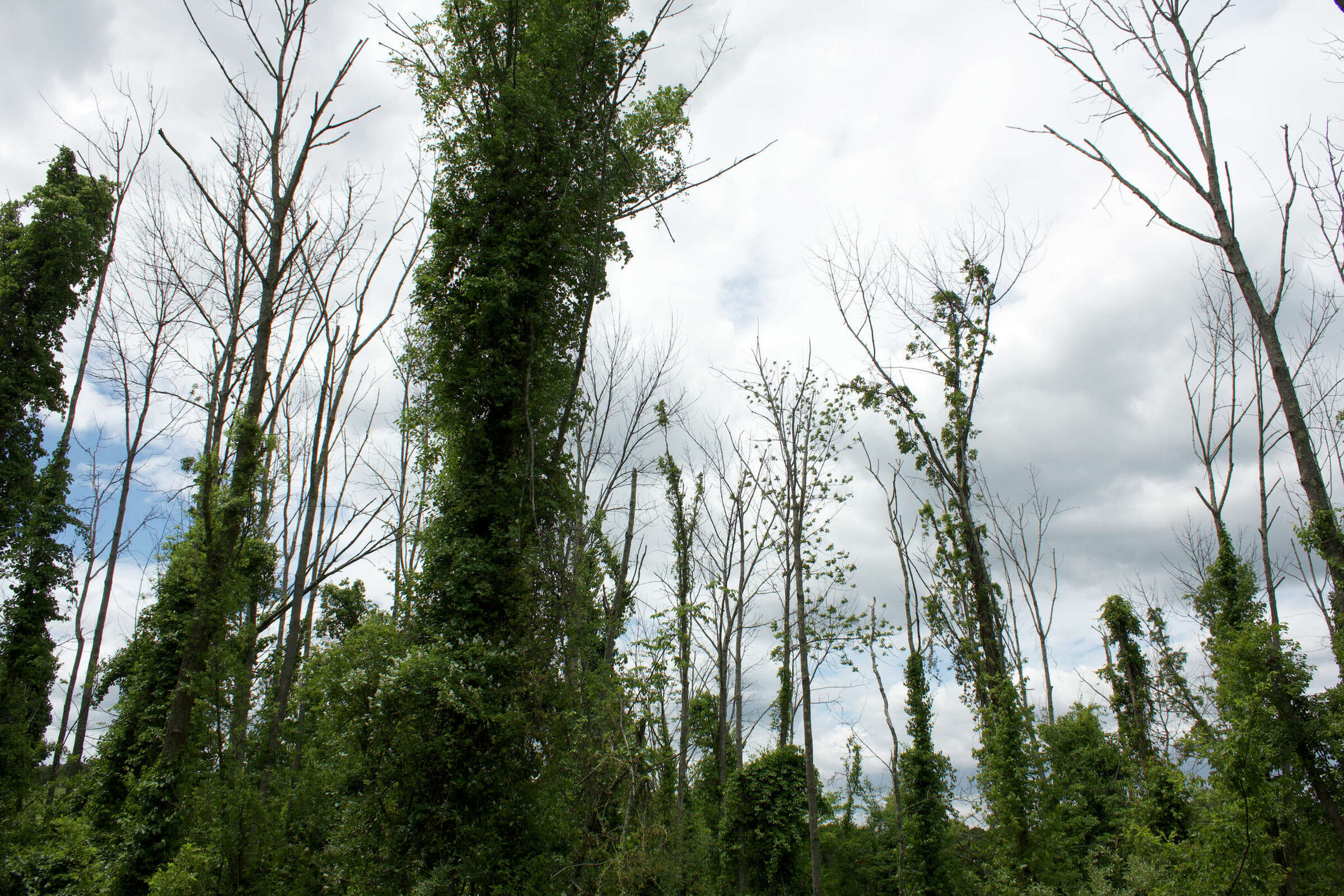 15/06/2023In a region of Ulster County stretching from Kingston up to Saugerties and over to Phoenicia, adult ash trees have reached 99 percent mortality as of last year. The evidence is plain to see: patches of bare, gray poles in an otherwise green forest. The culprit is the emerald ash borer, an insect native to East Asia that was first detected in New York state in 2009. Over the next decade, it spread rapidly across the state, decimating ash populations in its wake. The earliest detections of the emerald ash borer in the Hudson Valley were between 2010-2012 in places like Shokan and Kingston, with its spread blanketing the surrounding region in subsequent years. As a result, many municipalities in the region are positioned to experience the delayed economic impact of that infestation in the form of felled trees and preemptive tree removal. Read more here
15/06/2023In a region of Ulster County stretching from Kingston up to Saugerties and over to Phoenicia, adult ash trees have reached 99 percent mortality as of last year. The evidence is plain to see: patches of bare, gray poles in an otherwise green forest. The culprit is the emerald ash borer, an insect native to East Asia that was first detected in New York state in 2009. Over the next decade, it spread rapidly across the state, decimating ash populations in its wake. The earliest detections of the emerald ash borer in the Hudson Valley were between 2010-2012 in places like Shokan and Kingston, with its spread blanketing the surrounding region in subsequent years. As a result, many municipalities in the region are positioned to experience the delayed economic impact of that infestation in the form of felled trees and preemptive tree removal. Read more here -

-
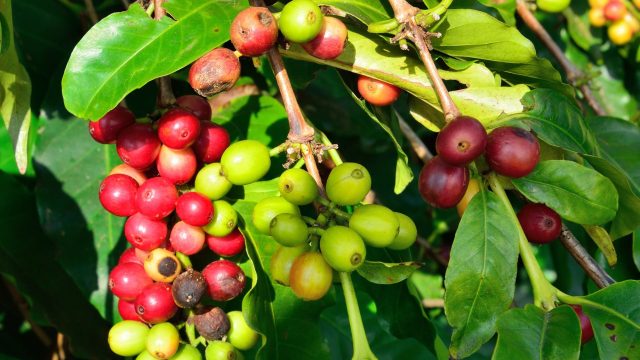 07/06/2023Government agencies in Hawaii are making preparations to release a small parasitoid in an attempt to control infestations of coffee berry borer (CBB) in the state, according to a release published by the University of Hawaii. “This biological control agent has the potential to make significant positive economic impacts in the Hawaiʻi coffee industry, and offers an environmentally safe way to manage CBB,” says Mark Wright, PhD, professor at UH. “The Hawaiʻi coffee industry is economically and culturally significant, and we hope that this work will improve the lives of many people associated with the industry.” The planned release comes at a time of increasing interest in nontoxic biological pest management as a means of reducing the harmful effects of industrially produced pesticides. Read more here
07/06/2023Government agencies in Hawaii are making preparations to release a small parasitoid in an attempt to control infestations of coffee berry borer (CBB) in the state, according to a release published by the University of Hawaii. “This biological control agent has the potential to make significant positive economic impacts in the Hawaiʻi coffee industry, and offers an environmentally safe way to manage CBB,” says Mark Wright, PhD, professor at UH. “The Hawaiʻi coffee industry is economically and culturally significant, and we hope that this work will improve the lives of many people associated with the industry.” The planned release comes at a time of increasing interest in nontoxic biological pest management as a means of reducing the harmful effects of industrially produced pesticides. Read more here -
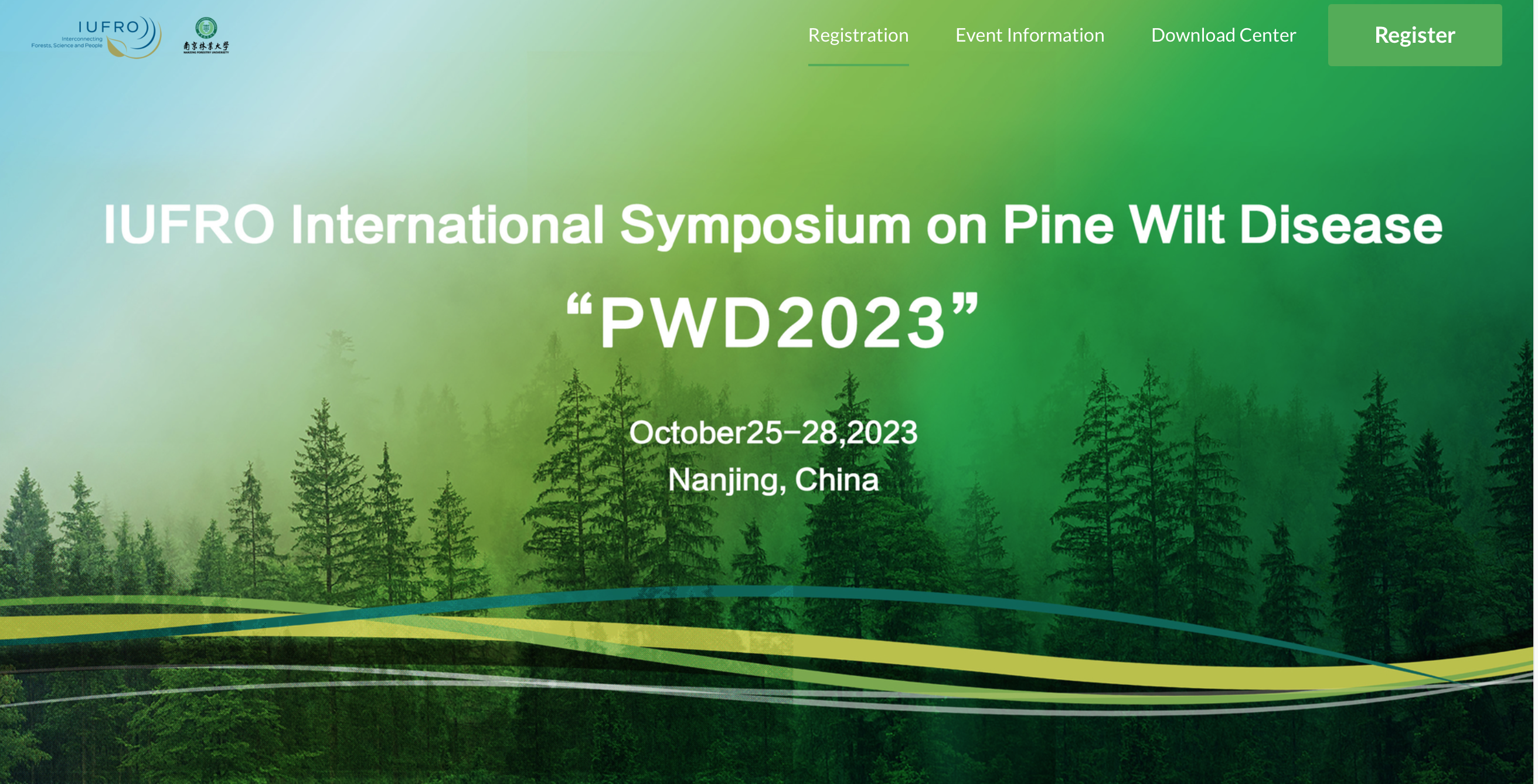 30/05/2023Second Announcement and Call for Abstracts IUFRO International Symposium on Pine Wilt Disease “PWD2023” October 25-28, 2023 Nanjing, China The Pine Wilt Disease Working Party (7.02.10), a section of IUFRO is dedicated to the research and technology development of Pine Wilt Disease (PWD) worldwide. The Working Party holds an International Pine Wilt Disease Conference regularly in countries around the world. Past events have taken place in Portugal (2006), China (2009), Germany (2013), Korea (2016) and France (2021). The next International PWD Symposium will be held in Nanjing, China, a historic and cultural city located in the lower reaches of the Yangtze River, from October 25-28, 2023. The main theme of PWD 2023 is “The Prevention, Theory, Technology and Management of Pine Wilt Disease”. This symposium aims to present the latest advances on the spread and pathogenicity of PWD, multi-species interactions, monitoring and control methods, and technology development for PWD management. See here for more details
30/05/2023Second Announcement and Call for Abstracts IUFRO International Symposium on Pine Wilt Disease “PWD2023” October 25-28, 2023 Nanjing, China The Pine Wilt Disease Working Party (7.02.10), a section of IUFRO is dedicated to the research and technology development of Pine Wilt Disease (PWD) worldwide. The Working Party holds an International Pine Wilt Disease Conference regularly in countries around the world. Past events have taken place in Portugal (2006), China (2009), Germany (2013), Korea (2016) and France (2021). The next International PWD Symposium will be held in Nanjing, China, a historic and cultural city located in the lower reaches of the Yangtze River, from October 25-28, 2023. The main theme of PWD 2023 is “The Prevention, Theory, Technology and Management of Pine Wilt Disease”. This symposium aims to present the latest advances on the spread and pathogenicity of PWD, multi-species interactions, monitoring and control methods, and technology development for PWD management. See here for more details -
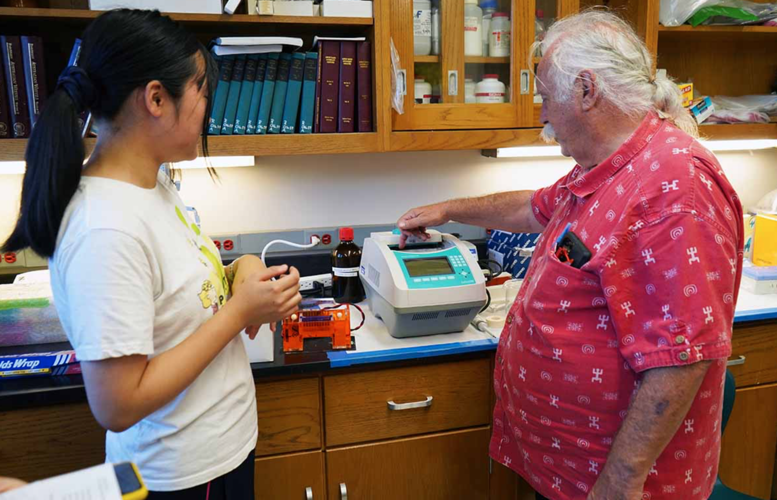 29/05/2023It has been 16 years since the coconut rhinoceros beetle, or CRB, was first discovered in Guam. A team of scientists and students from the University of Guam, Tokyo University of Agriculture and Technology and Palau Community College have been investigating a virus to control the local rhinoceros beetle population, UOG announced in a press release. The virus was initially introduced for the purpose of managing rhino beetles in Palau, and it is being explored for its possible use in controlling the beetles in Guam, UOG said in the release. The CRB was discovered in Guam in 2007, UOG said, but has been found in Palau since World War II. Read more here
29/05/2023It has been 16 years since the coconut rhinoceros beetle, or CRB, was first discovered in Guam. A team of scientists and students from the University of Guam, Tokyo University of Agriculture and Technology and Palau Community College have been investigating a virus to control the local rhinoceros beetle population, UOG announced in a press release. The virus was initially introduced for the purpose of managing rhino beetles in Palau, and it is being explored for its possible use in controlling the beetles in Guam, UOG said in the release. The CRB was discovered in Guam in 2007, UOG said, but has been found in Palau since World War II. Read more here -
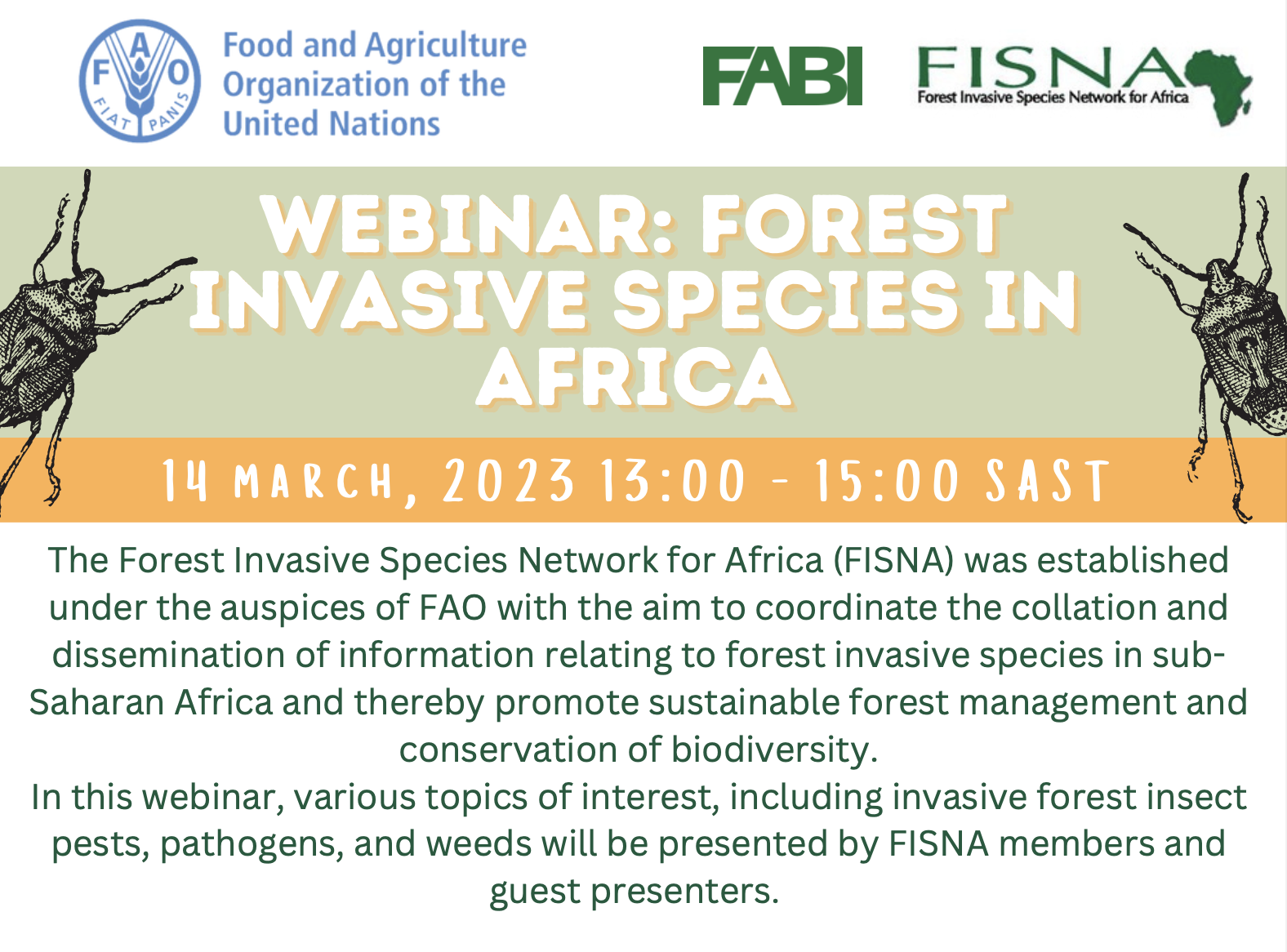 13/03/2023When: 14 March 2023 Time: 13:00 – 15:00 South African Standard Time (SAST) Download the Agenda here Join Zoom Meeting: https://zoom.us/j/92565987143?pwd=ZXhrcFROZ0JMcUlUbzJLQmZqVnhqUT09 Meeting ID: 925 6598 7143 Passcode: 371127
13/03/2023When: 14 March 2023 Time: 13:00 – 15:00 South African Standard Time (SAST) Download the Agenda here Join Zoom Meeting: https://zoom.us/j/92565987143?pwd=ZXhrcFROZ0JMcUlUbzJLQmZqVnhqUT09 Meeting ID: 925 6598 7143 Passcode: 371127 -
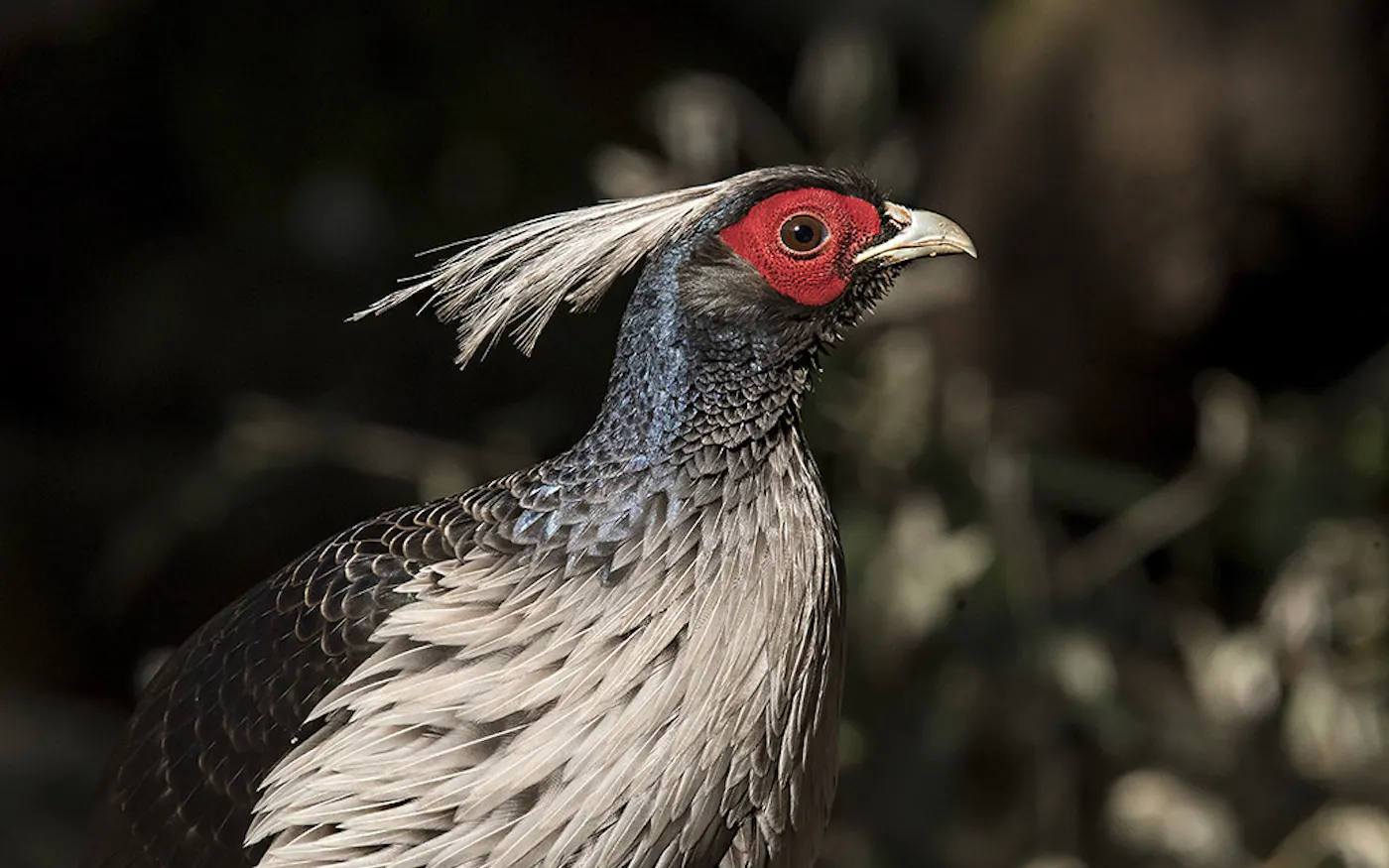 11/02/2023When Pramod Bhattarai assumed his office as chief conservation officer at Nepal’s Langtang National Park in November 2021, invasive species were not on his agenda. The growth of non-native plants had been a concern when he was stationed in Banke National Park in Nepal’s southern lowlands, where they were crowding out the native vegetation that feeds the park’s protected animals. But having never heard reports of invasive species in Langtang, in the Nepali Himalayas, he was confident that the high altitude park was not troubled by the problem. This assumption was shattered when Bhattarai found parts of the park invaded by non-native trees and bushes. “Thanks to climate change, the vegetation, in general, is shifting upwards, and it is bringing invasive alien species such as banmara to compete with native grasses,” Bhattarai tells The Third Pole. “As a result, musk deer and Himalayan tahr [a large wild goat] in the park might soon face difficulties in finding food.” Read more here
11/02/2023When Pramod Bhattarai assumed his office as chief conservation officer at Nepal’s Langtang National Park in November 2021, invasive species were not on his agenda. The growth of non-native plants had been a concern when he was stationed in Banke National Park in Nepal’s southern lowlands, where they were crowding out the native vegetation that feeds the park’s protected animals. But having never heard reports of invasive species in Langtang, in the Nepali Himalayas, he was confident that the high altitude park was not troubled by the problem. This assumption was shattered when Bhattarai found parts of the park invaded by non-native trees and bushes. “Thanks to climate change, the vegetation, in general, is shifting upwards, and it is bringing invasive alien species such as banmara to compete with native grasses,” Bhattarai tells The Third Pole. “As a result, musk deer and Himalayan tahr [a large wild goat] in the park might soon face difficulties in finding food.” Read more here -
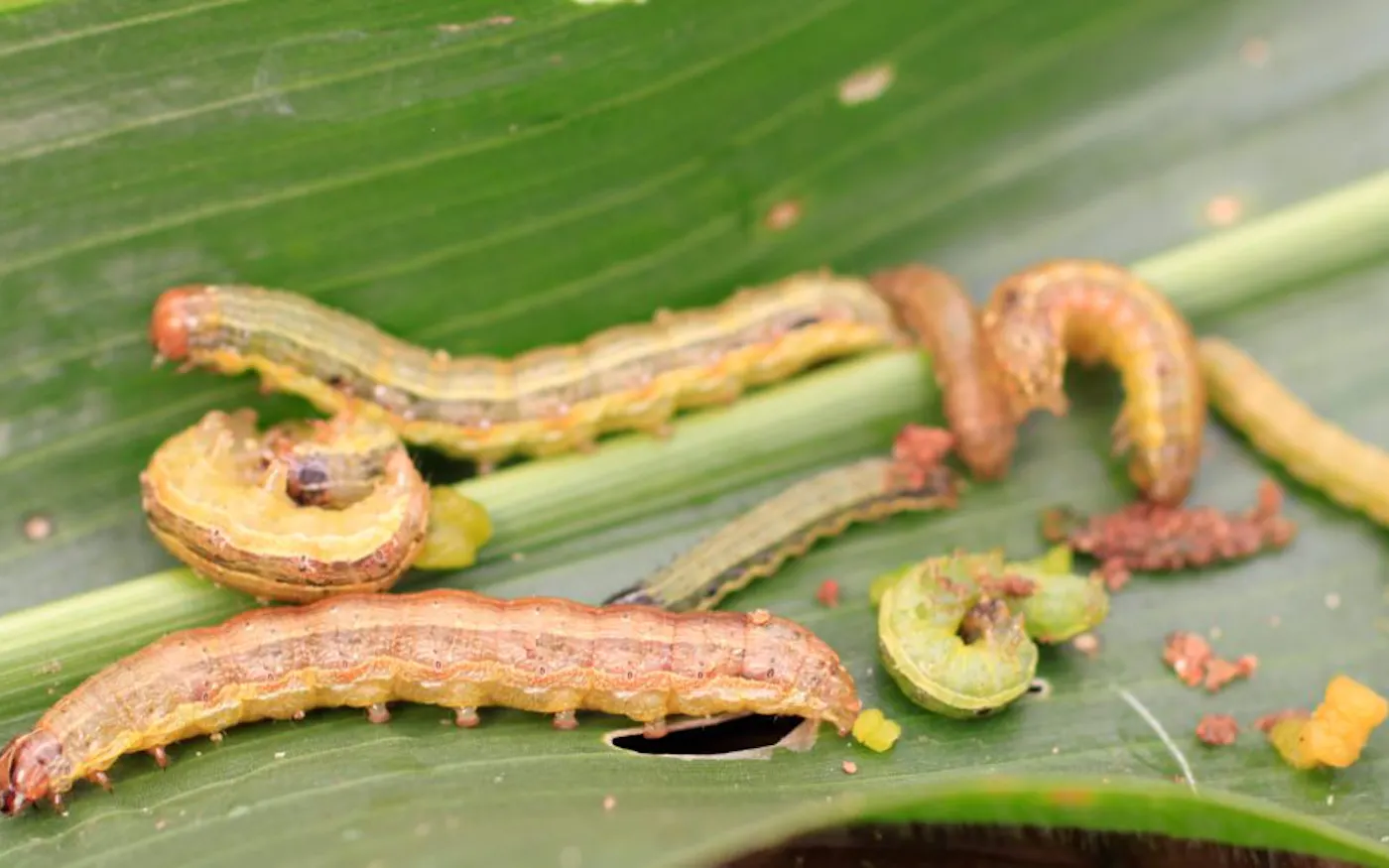 11/02/2023The cost of damage caused by invasive species around the world, including to agriculture, fisheries, and forestry, is at least 10 times that of preventing or controlling them, an international study suggests. The research, published in Science of the Total Environment earlier this month, highlights the huge economic burden of invasive species and says their prevention could save trillions of US dollars. Read more here
11/02/2023The cost of damage caused by invasive species around the world, including to agriculture, fisheries, and forestry, is at least 10 times that of preventing or controlling them, an international study suggests. The research, published in Science of the Total Environment earlier this month, highlights the huge economic burden of invasive species and says their prevention could save trillions of US dollars. Read more here -
 05/12/2022The webinar will cover various presentations on forest invasive species, including insect pests, pathogens, and weeds. Click here for a pdf of the program and login details
05/12/2022The webinar will cover various presentations on forest invasive species, including insect pests, pathogens, and weeds. Click here for a pdf of the program and login details -
 09/11/2022Weeds are amongst the most important invasive species in the Asia-Pacific region. In a recent survey by the Asia-Pacific Forest Invasive Species Network (APFISN) of its members, weeds were ranked as the most impactful forest invasive species in the region, especially across countries in the Pacific, Southeast Asia and South Asia. One of the most effective and sustainable management methods for invasive weeds is biological control, using natural enemies of a weed from its native range to control it in the invaded range. This webinar will introduce the concept of weed biocontrol generally, the process of host-specificity testing, biocontrol control successes, opportunities, and emerging invasive weed issues in the South and Southeast Asian regions. The webinar targets participants in SE Asia and South Asia and will run over consecutive days for two hours each day. Webinars targeting other regions (e.g. the Pacific) will be held in 2023. Time will be available to ask questions and for discussion on each day. We look forward to seeing you online on the 24th and 25th of November 2022! Time: UTC 05.00. Other indicative times: Mumbai 10:30/Karachi 10:00/Bangkok 12:00/Brisbane 15:00 The webinars are free and you can register for each day at the links below: 24th November 2022 – Click here 25th November 2022 – Click here For a flyer with agenda, click here Places are limited to 300 participants, so register early! See you then!
09/11/2022Weeds are amongst the most important invasive species in the Asia-Pacific region. In a recent survey by the Asia-Pacific Forest Invasive Species Network (APFISN) of its members, weeds were ranked as the most impactful forest invasive species in the region, especially across countries in the Pacific, Southeast Asia and South Asia. One of the most effective and sustainable management methods for invasive weeds is biological control, using natural enemies of a weed from its native range to control it in the invaded range. This webinar will introduce the concept of weed biocontrol generally, the process of host-specificity testing, biocontrol control successes, opportunities, and emerging invasive weed issues in the South and Southeast Asian regions. The webinar targets participants in SE Asia and South Asia and will run over consecutive days for two hours each day. Webinars targeting other regions (e.g. the Pacific) will be held in 2023. Time will be available to ask questions and for discussion on each day. We look forward to seeing you online on the 24th and 25th of November 2022! Time: UTC 05.00. Other indicative times: Mumbai 10:30/Karachi 10:00/Bangkok 12:00/Brisbane 15:00 The webinars are free and you can register for each day at the links below: 24th November 2022 – Click here 25th November 2022 – Click here For a flyer with agenda, click here Places are limited to 300 participants, so register early! See you then! -
 25/10/2022For invasive species leaving their home, they leave not only their predators but also the species that helped them thrive. Arriving to a new range or location, invasive species lose not only their enemies but also their friends—those relationships that benefit colonization. Read more here
25/10/2022For invasive species leaving their home, they leave not only their predators but also the species that helped them thrive. Arriving to a new range or location, invasive species lose not only their enemies but also their friends—those relationships that benefit colonization. Read more here -
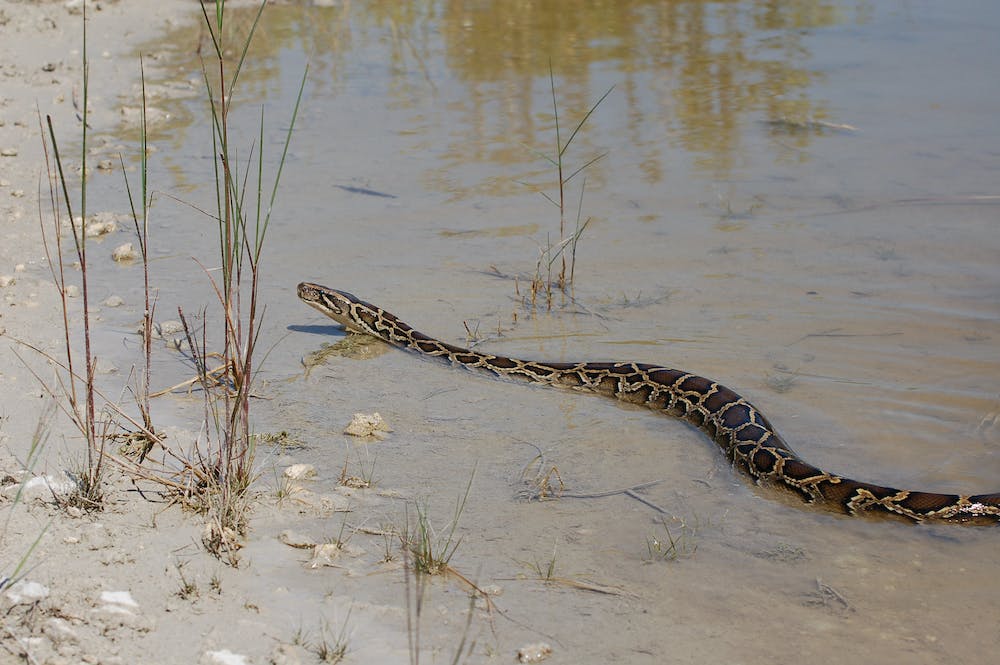 25/10/2022Economic growth and globalization have connected the world’s most distant places. Rapid trade and transport have boosted economic growth globally, but not without consequences: many species have been introduced to new regions, far from where they evolved. Alien species are those introduced by humans to regions outside their natural range. Invasive alien species are a growing concern for both the environment and economy. In recent decades, alien herpetofauna — amphibians and reptiles — have increasingly gained attention on social media, with more information being circulated about the impacts these species have on native flora and fauna. And yet, the number of invasive reptiles and amphibians is increasing, facilitated by the persistently high globalization of human activities. Read more here
25/10/2022Economic growth and globalization have connected the world’s most distant places. Rapid trade and transport have boosted economic growth globally, but not without consequences: many species have been introduced to new regions, far from where they evolved. Alien species are those introduced by humans to regions outside their natural range. Invasive alien species are a growing concern for both the environment and economy. In recent decades, alien herpetofauna — amphibians and reptiles — have increasingly gained attention on social media, with more information being circulated about the impacts these species have on native flora and fauna. And yet, the number of invasive reptiles and amphibians is increasing, facilitated by the persistently high globalization of human activities. Read more here -
 22/08/2022The 19th meeting of the International Forestry Quarantine Research Group (IFQRG) will be held as a virtual symposium on four consecutive Fridays starting September 2, 2022 (skipping Sept 23 because of a conflict with the first International Plant Health Conference). Each day there will be four to six ~15 minute presentations. A five-minute question period will follow each presentation. Each day will close with a discussion session on the day’s topics for approximately one hour. The symposium will include the following topics: Molecular tools – detection, diagnostics and enhancing international collaboration Pest moving on forest products & the risks associated with forest pest establishment in novel environments – incursion versus establishment Phytosanitary treatments Surveillance tools for forest pests – development of new lures and new technology Development of guidance for ISPMs related to forestry The Symposium will be hosted on the Zoom platform by coordinator Kelli Hoover, Penn State University, USA. See here for more information (second announcement) To register, please email IFQRG Secretary Meghan Noseworthy: meghan.noseworthy@nrcan-rncan.gc.ca
22/08/2022The 19th meeting of the International Forestry Quarantine Research Group (IFQRG) will be held as a virtual symposium on four consecutive Fridays starting September 2, 2022 (skipping Sept 23 because of a conflict with the first International Plant Health Conference). Each day there will be four to six ~15 minute presentations. A five-minute question period will follow each presentation. Each day will close with a discussion session on the day’s topics for approximately one hour. The symposium will include the following topics: Molecular tools – detection, diagnostics and enhancing international collaboration Pest moving on forest products & the risks associated with forest pest establishment in novel environments – incursion versus establishment Phytosanitary treatments Surveillance tools for forest pests – development of new lures and new technology Development of guidance for ISPMs related to forestry The Symposium will be hosted on the Zoom platform by coordinator Kelli Hoover, Penn State University, USA. See here for more information (second announcement) To register, please email IFQRG Secretary Meghan Noseworthy: meghan.noseworthy@nrcan-rncan.gc.ca -
 30/05/20221. Developing a Biosecurity Directional Framework – A NZ Experience. Peter Thomson, Ministry for Primary Industries, New Zealand 2. Shared responsibility in Australian Biosecurity – An overview. Russel Warman, University of Tasmania, Australia 3. An Industry Perspective on Biosecurity – Patricia Machado, Ibá, Brazil 4. Perspectives on Biosecurity in Ghana’s Forests – Paul Bosu, CSIR, Ghana 5. IPPC and Biosecurity – Camilo Beltran Montoya, IPPC 6. Roadmap for a global framework on Forest Biosecurity – Shiroma Sathyapala, Food and Agriculture Organisation of the United Nations The video of the Side Event can also be accessed here
30/05/20221. Developing a Biosecurity Directional Framework – A NZ Experience. Peter Thomson, Ministry for Primary Industries, New Zealand 2. Shared responsibility in Australian Biosecurity – An overview. Russel Warman, University of Tasmania, Australia 3. An Industry Perspective on Biosecurity – Patricia Machado, Ibá, Brazil 4. Perspectives on Biosecurity in Ghana’s Forests – Paul Bosu, CSIR, Ghana 5. IPPC and Biosecurity – Camilo Beltran Montoya, IPPC 6. Roadmap for a global framework on Forest Biosecurity – Shiroma Sathyapala, Food and Agriculture Organisation of the United Nations The video of the Side Event can also be accessed here -
 23/05/2022Forest biosecurity as a shared responsibility – towards a global framework XV World Forestry Congress Side event – Held on 5 May 2022 Global travel and trade have facilitated the movement of invasive species around the world and protecting forests from these threats is paramount. It is a global issue that requires national, regional, and global cooperation and action. FAO, together with partners, aims to develop and implement a framework targeting policy makers and regulators to develop national strategies to increase awareness and engage all stakeholders in forest biosecurity. At the XIV World Forest Congress side-event, speakers from around the globe shared their perspectives on the current situation of forest biosecurity and the need for a global framework followed by a panel discussion on the global framework’s development. Click here to view a recording of the Side Event !
23/05/2022Forest biosecurity as a shared responsibility – towards a global framework XV World Forestry Congress Side event – Held on 5 May 2022 Global travel and trade have facilitated the movement of invasive species around the world and protecting forests from these threats is paramount. It is a global issue that requires national, regional, and global cooperation and action. FAO, together with partners, aims to develop and implement a framework targeting policy makers and regulators to develop national strategies to increase awareness and engage all stakeholders in forest biosecurity. At the XIV World Forest Congress side-event, speakers from around the globe shared their perspectives on the current situation of forest biosecurity and the need for a global framework followed by a panel discussion on the global framework’s development. Click here to view a recording of the Side Event ! -
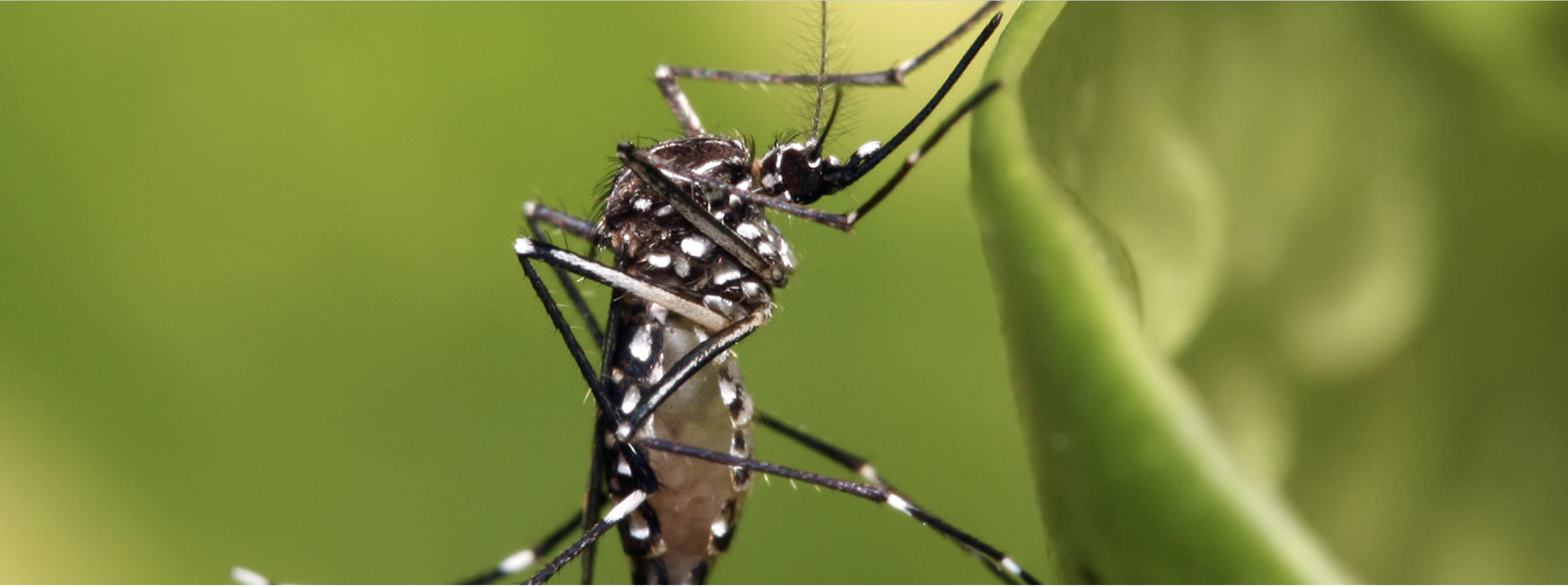 04/05/2022As many as 10 invasive alien species (IAS), out of 330 that are known to be invasive in India, have cost the economy $127.3 billion (Rs. 8.3 trillion) in the last 60 years, according to a recent analysis that points to glaring knowledge gaps in costs incurred by these species to the Indian economy. As many as 330 species are declared invasive out of more than 2,000 alien species in India and the costs of $127.3 billion as documented in the study comes from only 10 of these 330 species, making India the second topmost invasion-cost bearing country after the United States. These costs are likely to be a “gross underrepresentation” of the actual costs based on the authors’ global analysis of 112 countries. “The negative economic impacts are documented and available only for 3% of the known invasive species and unavailable/masked/underrepresented for the rest 97% of invasive species in India. That’s a huge knowledge gap,” evolutionary biologist and study lead author Alok Bang told Mongabay-India. For comparison, the annual budget of India’s environment ministry is currently $0.4 billion. Read more here
04/05/2022As many as 10 invasive alien species (IAS), out of 330 that are known to be invasive in India, have cost the economy $127.3 billion (Rs. 8.3 trillion) in the last 60 years, according to a recent analysis that points to glaring knowledge gaps in costs incurred by these species to the Indian economy. As many as 330 species are declared invasive out of more than 2,000 alien species in India and the costs of $127.3 billion as documented in the study comes from only 10 of these 330 species, making India the second topmost invasion-cost bearing country after the United States. These costs are likely to be a “gross underrepresentation” of the actual costs based on the authors’ global analysis of 112 countries. “The negative economic impacts are documented and available only for 3% of the known invasive species and unavailable/masked/underrepresented for the rest 97% of invasive species in India. That’s a huge knowledge gap,” evolutionary biologist and study lead author Alok Bang told Mongabay-India. For comparison, the annual budget of India’s environment ministry is currently $0.4 billion. Read more here -
 07/04/2022In partnership with FAO, the USDA Forest Service, AFoCO and the regional Forest Invasive Species networks, APFISN is a co-organiser of a Side Event at the upcoming World Forestry Congress to be held in Seoul, Republic of Korea from 1-6 May 2022. The theme of the Side Event is “Forest Biosecurity as a Shared Responsibility – Towards A Global Framework”. The Side Event will take place from 10.00 to 11.30 am (Korea Standard Time) on Thursday 5 May. To register to join the Side Event online please click here. More details can be downloaded in the official flyer here The Congress is being held as a hybrid event and the Side Event will also be held in person and virtually. Early-bird registration for the Congress is available until 15 April. See here for more details Covid-19 Travel advice for the Congress is available here We look forward to seeing you in Seoul soon!
07/04/2022In partnership with FAO, the USDA Forest Service, AFoCO and the regional Forest Invasive Species networks, APFISN is a co-organiser of a Side Event at the upcoming World Forestry Congress to be held in Seoul, Republic of Korea from 1-6 May 2022. The theme of the Side Event is “Forest Biosecurity as a Shared Responsibility – Towards A Global Framework”. The Side Event will take place from 10.00 to 11.30 am (Korea Standard Time) on Thursday 5 May. To register to join the Side Event online please click here. More details can be downloaded in the official flyer here The Congress is being held as a hybrid event and the Side Event will also be held in person and virtually. Early-bird registration for the Congress is available until 15 April. See here for more details Covid-19 Travel advice for the Congress is available here We look forward to seeing you in Seoul soon! -
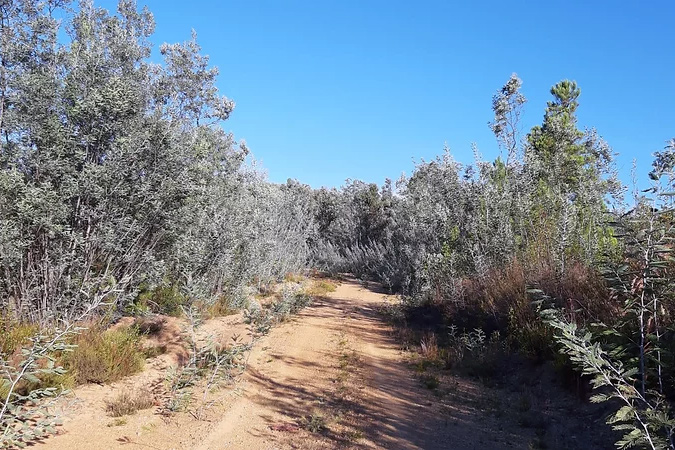 06/04/2022In recent decades, Portugal has been negatively affected by a growing invasion of exotic forest species adapted to fire-prone regimes, changing native ecosystems and contributing to the loss of biodiversity. Many forest ecosystems worldwide are under threat after the invasion of exotic invasive plant species and Portugal is no exception. One of the most aggressive invaders in Portugal are the species of the genus Acacia, negatively affecting the ecosystem functioning, as well as changing the wildfire regime. Moreover, invasive alien species are one of the main causes of biodiversity loss. Over the centuries, these plants have been introduced for a variety of purposes, such as timber production, landscape restoration or ornamental use. According to the most recent forestry inventory, around 20 thousand hectares of Portuguese areas is currently occupied by acacias. The management of these invaded ecosystems is becoming an increasingly complex problem. Based on recent research, it has been recognised that the eradication of invasive species alone is a utopic activity, insufficient to restore affected ecosystems. In this way, strategies and control methods applied in these territories, as well as the duration of their application, are increasingly seen as vital to the solution of this problem. However, implementing effective control strategies is also a challenge. Read more here
06/04/2022In recent decades, Portugal has been negatively affected by a growing invasion of exotic forest species adapted to fire-prone regimes, changing native ecosystems and contributing to the loss of biodiversity. Many forest ecosystems worldwide are under threat after the invasion of exotic invasive plant species and Portugal is no exception. One of the most aggressive invaders in Portugal are the species of the genus Acacia, negatively affecting the ecosystem functioning, as well as changing the wildfire regime. Moreover, invasive alien species are one of the main causes of biodiversity loss. Over the centuries, these plants have been introduced for a variety of purposes, such as timber production, landscape restoration or ornamental use. According to the most recent forestry inventory, around 20 thousand hectares of Portuguese areas is currently occupied by acacias. The management of these invaded ecosystems is becoming an increasingly complex problem. Based on recent research, it has been recognised that the eradication of invasive species alone is a utopic activity, insufficient to restore affected ecosystems. In this way, strategies and control methods applied in these territories, as well as the duration of their application, are increasingly seen as vital to the solution of this problem. However, implementing effective control strategies is also a challenge. Read more here -
 06/04/2022Often considered a gardener’s best friend, earthworms are harming native species in forests where they don’t belong. In the past five years, reports of staggering insect declines have stoked anxiety and debate concerning the fate of the “little things that run the world,” as the late biologist E. O. Wilson once called them. As for the how and why of these declines, the prime culprits are habitat destruction, rampant use of pesticides, and climate change. But new research published March 30 in Biology Letters adds an unexpected suspect, at least for a large swath of North America: the earthworm. The study looked at 60 plots in an aspen and poplar forest in Alberta, Canada, and found that as the numbers of earthworms wriggling in the soil and leaf litter increased, the diversity and abundance of invertebrates aboveground decreased. These results might sound surprising, since earthworms are widely considered to be helpful garden residents. Worms earned their reputation by aerating and mixing soil with their burrows and releasing locked up nutrients in their castings, all of which can help certain plants thrive. But this new study is part of a growing body of research suggesting that at least in the forests of northern North America, earthworms may not be the slimy angels of the underworld we tend to think they are. Read more here
06/04/2022Often considered a gardener’s best friend, earthworms are harming native species in forests where they don’t belong. In the past five years, reports of staggering insect declines have stoked anxiety and debate concerning the fate of the “little things that run the world,” as the late biologist E. O. Wilson once called them. As for the how and why of these declines, the prime culprits are habitat destruction, rampant use of pesticides, and climate change. But new research published March 30 in Biology Letters adds an unexpected suspect, at least for a large swath of North America: the earthworm. The study looked at 60 plots in an aspen and poplar forest in Alberta, Canada, and found that as the numbers of earthworms wriggling in the soil and leaf litter increased, the diversity and abundance of invertebrates aboveground decreased. These results might sound surprising, since earthworms are widely considered to be helpful garden residents. Worms earned their reputation by aerating and mixing soil with their burrows and releasing locked up nutrients in their castings, all of which can help certain plants thrive. But this new study is part of a growing body of research suggesting that at least in the forests of northern North America, earthworms may not be the slimy angels of the underworld we tend to think they are. Read more here -
 06/04/2022Invasive alien forest insects will kill 2.1-2.5 per cent of all street trees (1.4 million) in the United States in 30 years (2020-2050). This loss would cost $30 million annually to manage, a recent study has said. Most of this damage (95 per cent) would be caused in 23 per cent of America’s urban areas, the study added. Ninety per cent of all mortality would be due to the emerald ash borer (Agrilus planipennis). The insect is expected to kill almost all the ash trees in 6,000 US urban settings, the study said. The emerald ash borer will impact an area of 902,500 square kilometres, mostly in the southern and central US. These areas would witness the destruction of 98.8 per cent of all ash trees. The researchers, led by Emma J Hudgins from McGill University, Canada, termed Milwaukee, Chicago and New York City as the ‘mortality hotspot cities’. Maple and oak trees would face the threat of Asian wood borers in the future, costing $4.9 billion over 30 years. The study, the researchers said, was the first spatial forecast of urban tree mortality due to invasive insect pests done in the US and identified dominant insect pests and spatial impact hotspots. Emerald ash borer beetles are invasive insects first discovered in Michigan in 2002 and most likely brought over on packing material from East Asia. Read more here
06/04/2022Invasive alien forest insects will kill 2.1-2.5 per cent of all street trees (1.4 million) in the United States in 30 years (2020-2050). This loss would cost $30 million annually to manage, a recent study has said. Most of this damage (95 per cent) would be caused in 23 per cent of America’s urban areas, the study added. Ninety per cent of all mortality would be due to the emerald ash borer (Agrilus planipennis). The insect is expected to kill almost all the ash trees in 6,000 US urban settings, the study said. The emerald ash borer will impact an area of 902,500 square kilometres, mostly in the southern and central US. These areas would witness the destruction of 98.8 per cent of all ash trees. The researchers, led by Emma J Hudgins from McGill University, Canada, termed Milwaukee, Chicago and New York City as the ‘mortality hotspot cities’. Maple and oak trees would face the threat of Asian wood borers in the future, costing $4.9 billion over 30 years. The study, the researchers said, was the first spatial forecast of urban tree mortality due to invasive insect pests done in the US and identified dominant insect pests and spatial impact hotspots. Emerald ash borer beetles are invasive insects first discovered in Michigan in 2002 and most likely brought over on packing material from East Asia. Read more here -
 04/04/2022A new project calling upon everyone to participate in ‘early warning systems’ for invasive species in the Pacific islands was launched on August 27 2021. iNaturalist is a social network of naturalists, citizen scientists, and biologists built on the concept of mapping and sharing observations of biodiversity across the globe. It is a free tool and can be used by anyone, anywhere. Niue, Republic of the Marshall Islands (RMI), Tonga and Tuvalu are four Pacific islands now using iNaturalist which is available as part of the GEF 6 Regional Invasives Project (GEF6 RIP). To help track priority invasive species that threaten Pacific Island biodiversity, GEF 6 RIP developed the initiative which records findings of biodiversity and invasive species observations by local residents and visitors. “We are excited to launch the iNaturalist projects in Niue, RMI, Tonga, and Tuvalu and get communities involved in the monitoring and management of invasive species and biodiversity more broadly,” said Bradley Myer, Project Manager GEF 6 RIP at SPREP.
04/04/2022A new project calling upon everyone to participate in ‘early warning systems’ for invasive species in the Pacific islands was launched on August 27 2021. iNaturalist is a social network of naturalists, citizen scientists, and biologists built on the concept of mapping and sharing observations of biodiversity across the globe. It is a free tool and can be used by anyone, anywhere. Niue, Republic of the Marshall Islands (RMI), Tonga and Tuvalu are four Pacific islands now using iNaturalist which is available as part of the GEF 6 Regional Invasives Project (GEF6 RIP). To help track priority invasive species that threaten Pacific Island biodiversity, GEF 6 RIP developed the initiative which records findings of biodiversity and invasive species observations by local residents and visitors. “We are excited to launch the iNaturalist projects in Niue, RMI, Tonga, and Tuvalu and get communities involved in the monitoring and management of invasive species and biodiversity more broadly,” said Bradley Myer, Project Manager GEF 6 RIP at SPREP. -
 28/02/2022LDD moth caterpillar. Lake Simcoe Region Conservation Authority Invasive Species Awareness Week is a social media campaign to raise awareness about invasive species and the protection of Canada’s natural species. It coincides with, and was inspired by the American National Invasive Species Awareness Week, which runs from Feb. 28 to March 4. For more information, and how to get involved, please see the press release included below Invasive Species Awareness Week (ISAW) is a collaborative social media campaign focused on raising awareness about invasive species and how to protect Canada’s natural spaces. ISAW is inspired by the ‘National Invasive Species Awareness Week’ in the United States, with Canada sharing the same dates as the U.S. campaign. For many years, the Biodiversity Education and Awareness Network, Forests Ontario, Invading Species Awareness Program, Invasive Species Centre, and the Ontario Invasive Plant Council have partnered to develop ISAW campaign resource materials for Ontario and Canada that have been used by dozens of organizations across the country. Invasive Species Awareness Week takes place Feb. 28 – March 4, 2022, using the hashtag #InvSpWk. Read more here
28/02/2022LDD moth caterpillar. Lake Simcoe Region Conservation Authority Invasive Species Awareness Week is a social media campaign to raise awareness about invasive species and the protection of Canada’s natural species. It coincides with, and was inspired by the American National Invasive Species Awareness Week, which runs from Feb. 28 to March 4. For more information, and how to get involved, please see the press release included below Invasive Species Awareness Week (ISAW) is a collaborative social media campaign focused on raising awareness about invasive species and how to protect Canada’s natural spaces. ISAW is inspired by the ‘National Invasive Species Awareness Week’ in the United States, with Canada sharing the same dates as the U.S. campaign. For many years, the Biodiversity Education and Awareness Network, Forests Ontario, Invading Species Awareness Program, Invasive Species Centre, and the Ontario Invasive Plant Council have partnered to develop ISAW campaign resource materials for Ontario and Canada that have been used by dozens of organizations across the country. Invasive Species Awareness Week takes place Feb. 28 – March 4, 2022, using the hashtag #InvSpWk. Read more here -
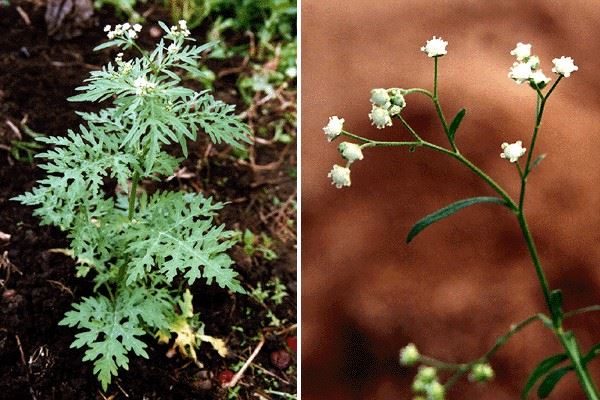 28/02/2022Parthenium weed ©S.D. Sawant CABI’s invasive species compendium has detailed coverage of invasive species threatening livelihoods and the environment worldwide. Changes to Compendia distribution data: the distribution tables, maps and references in datasheets have been restructured to handle the data better for updating and align with a geographic standard. Click here to find out more
28/02/2022Parthenium weed ©S.D. Sawant CABI’s invasive species compendium has detailed coverage of invasive species threatening livelihoods and the environment worldwide. Changes to Compendia distribution data: the distribution tables, maps and references in datasheets have been restructured to handle the data better for updating and align with a geographic standard. Click here to find out more -
 26/08/2021With alien invasive species fast changing the landscape and vegetation of Kerala, scientists at Kearla forest research institute (KFRI) are proposing a concept of ‘invasive-free’ campuses for institutions in the State. Read more here
26/08/2021With alien invasive species fast changing the landscape and vegetation of Kerala, scientists at Kearla forest research institute (KFRI) are proposing a concept of ‘invasive-free’ campuses for institutions in the State. Read more here -
 Call For Experts - To assist the Working Group developing a Manual for ISPM 15 Fumigation TreatmentsCall For Experts - To assist the Working Group developing a Manual for ISPM 15 Fumigation Treatments04/08/2021The International Plant Protection Convention (IPPC) Secretariat is soliciting: Nominations for appropriately qualified experts to develop a Manual which will outline specific technical requirements and provide guidance for applying and verifying ISPM 15 fumigation treatments, both methyl bromide (MB) and sulfuryl fluoride (SF). Deadline: Nominations are due 24 September 2021 . Read more here
Call For Experts - To assist the Working Group developing a Manual for ISPM 15 Fumigation TreatmentsCall For Experts - To assist the Working Group developing a Manual for ISPM 15 Fumigation Treatments04/08/2021The International Plant Protection Convention (IPPC) Secretariat is soliciting: Nominations for appropriately qualified experts to develop a Manual which will outline specific technical requirements and provide guidance for applying and verifying ISPM 15 fumigation treatments, both methyl bromide (MB) and sulfuryl fluoride (SF). Deadline: Nominations are due 24 September 2021 . Read more here -
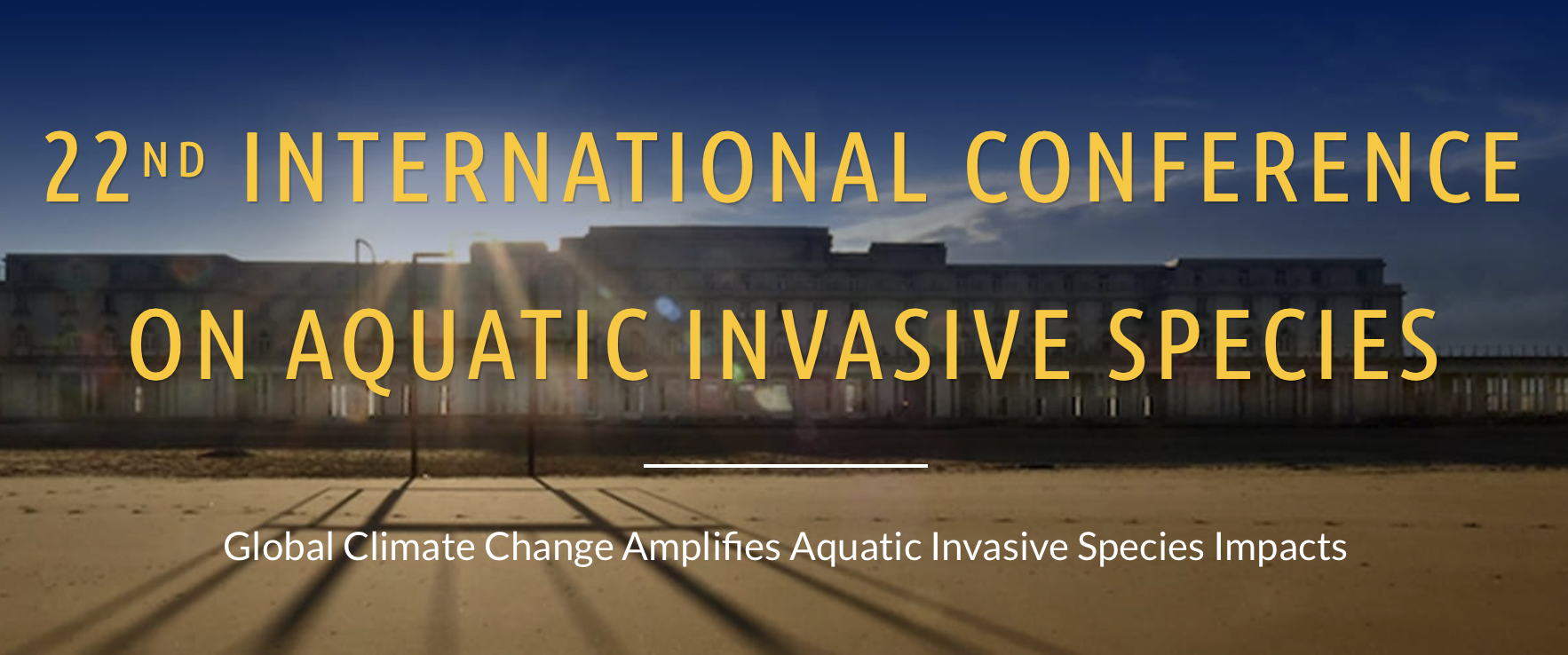 01/07/2021Please join us for the International Conference on Aquatic Invasive Species, ICAIS 2022, to be held April 18-22, 2022 in Oostende, Belgium. The conference is co-hosted by the Netherland’s Office for Risk Assessment & Research (NVWA/BuRO) and Belgium’s Research Institute for Nature and Forest (INBO), with the support of Canada’s Invasive Species Centre, the ICAIS Secretariat. ICAIS 2022 will be a hybrid event with in-person aspects held at the Thermae Palace Hotel, Oostende, Belgium and virtual aspects live online through an integration platform. See you there or virtually online! Get more information here
01/07/2021Please join us for the International Conference on Aquatic Invasive Species, ICAIS 2022, to be held April 18-22, 2022 in Oostende, Belgium. The conference is co-hosted by the Netherland’s Office for Risk Assessment & Research (NVWA/BuRO) and Belgium’s Research Institute for Nature and Forest (INBO), with the support of Canada’s Invasive Species Centre, the ICAIS Secretariat. ICAIS 2022 will be a hybrid event with in-person aspects held at the Thermae Palace Hotel, Oostende, Belgium and virtual aspects live online through an integration platform. See you there or virtually online! Get more information here -
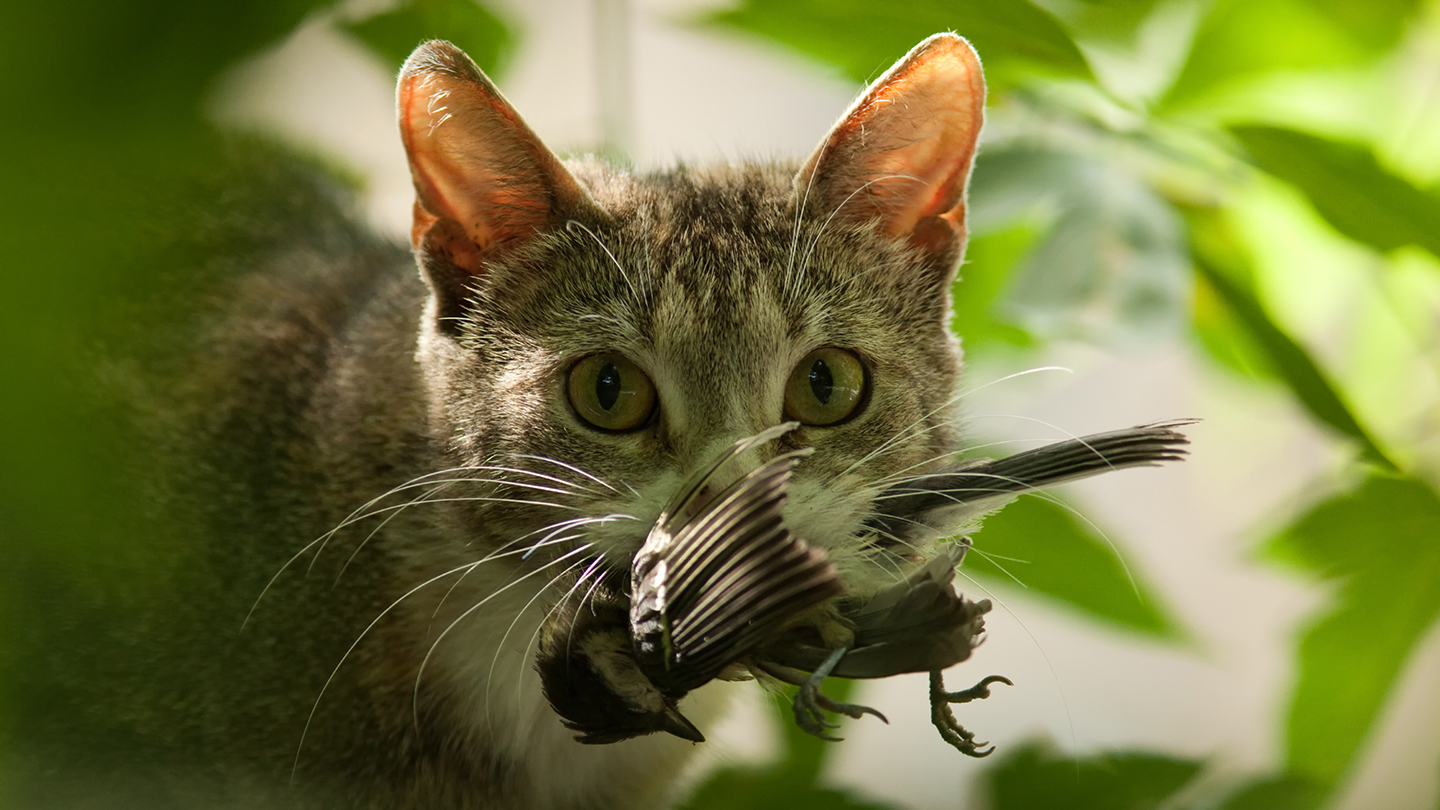 01/07/2021Invasive species can wreak havoc on local ecosystems. Cleaning up that biological wreckage comes at a big price. These invaders, often thrust into new environments unintentionally (or intentionally, to combat pests) by humans, can transmit new diseases, devastate crops and eat away at crucial infrastructure. From 1970 to 2017, such invasions cost the global economy at least $1.28 trillion in damages and in efforts to control them, researchers report March 31 in Nature. As the globe becomes increasingly interconnected and invasive species take over new habitats, that cost grows. Click here to read more
01/07/2021Invasive species can wreak havoc on local ecosystems. Cleaning up that biological wreckage comes at a big price. These invaders, often thrust into new environments unintentionally (or intentionally, to combat pests) by humans, can transmit new diseases, devastate crops and eat away at crucial infrastructure. From 1970 to 2017, such invasions cost the global economy at least $1.28 trillion in damages and in efforts to control them, researchers report March 31 in Nature. As the globe becomes increasingly interconnected and invasive species take over new habitats, that cost grows. Click here to read more -
 01/07/2021A team of scientists from CABI centres in Africa and Europe conducted an in-depth literature review and online survey as part of the first comprehensive study on the annual cost of invasive alien species on Africa’s agricultural sector. The study estimates that annually invasive alien species cost Africa USD 3.66 trillion, 92% of which can be attributed to the labour costs of weeding invasive alien species. Smallholders are largely poor and food insecure and hand weeding is still the only weed control option open to most. This method of weed management is physically demanding and time consuming. The total cost of weeding invasive alien plants, which often comprise more than half of the weeds in arable fields, is huge. The CABI scientists put a monetary value on the weeding labour for the entire African continent. This was based on a review of existing literature, which revealed weeding in crop types can take 50-92 person days per hectare. Click here to read more
01/07/2021A team of scientists from CABI centres in Africa and Europe conducted an in-depth literature review and online survey as part of the first comprehensive study on the annual cost of invasive alien species on Africa’s agricultural sector. The study estimates that annually invasive alien species cost Africa USD 3.66 trillion, 92% of which can be attributed to the labour costs of weeding invasive alien species. Smallholders are largely poor and food insecure and hand weeding is still the only weed control option open to most. This method of weed management is physically demanding and time consuming. The total cost of weeding invasive alien plants, which often comprise more than half of the weeds in arable fields, is huge. The CABI scientists put a monetary value on the weeding labour for the entire African continent. This was based on a review of existing literature, which revealed weeding in crop types can take 50-92 person days per hectare. Click here to read more -
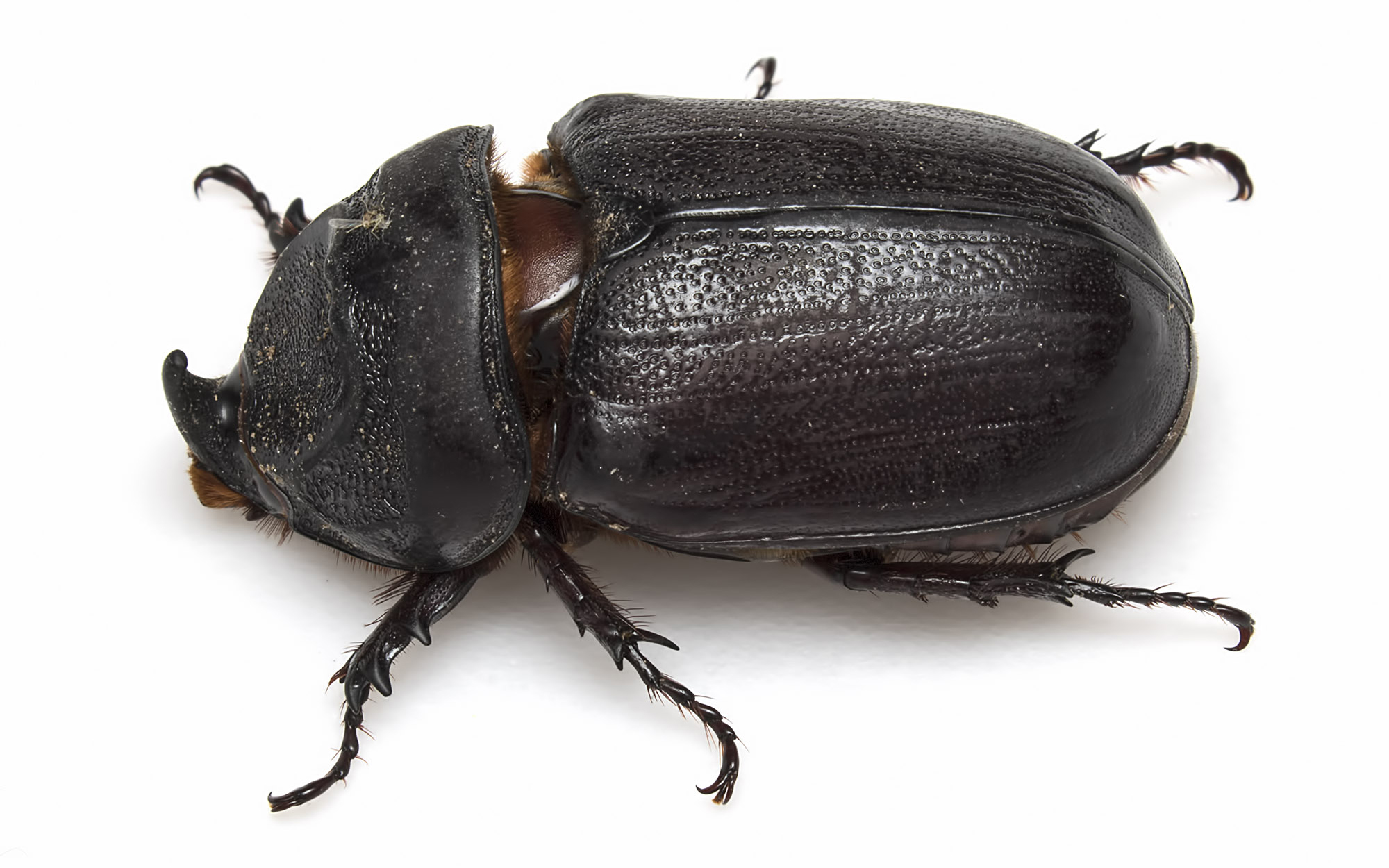 17/06/2021Coconut rhinoceros beetle A destructive pest beetle is edging closer to Australia as biological controls fail, destroying home gardens, plantations and biodiversity as they surge through nearby Pacific islands. University of Queensland researcher Dr Kayvan Etebari has been studying how palm-loving coconut rhinoceros beetles have been accelerating their invasion. “We thought we’d outsmarted them,” Dr Etebari said. “In the 1970s, scientists from Australia and elsewhere found that coconut rhinoceros beetles could be controlled with a beetle virus from Malaysia. “This virus stopped the beetle in its tracks and, for the last 50 years or so, it more-or-less stayed put – that is, until now. “It seems that they are now unshackled from the virus in some places and could be in Australia before we know it.” In the last few years, the pest has spread to many South Pacific islands, including islands in Papua New Guinea, the Solomon Islands and Vanuatu, causing severe agricultural and economic damage. Read more here
17/06/2021Coconut rhinoceros beetle A destructive pest beetle is edging closer to Australia as biological controls fail, destroying home gardens, plantations and biodiversity as they surge through nearby Pacific islands. University of Queensland researcher Dr Kayvan Etebari has been studying how palm-loving coconut rhinoceros beetles have been accelerating their invasion. “We thought we’d outsmarted them,” Dr Etebari said. “In the 1970s, scientists from Australia and elsewhere found that coconut rhinoceros beetles could be controlled with a beetle virus from Malaysia. “This virus stopped the beetle in its tracks and, for the last 50 years or so, it more-or-less stayed put – that is, until now. “It seems that they are now unshackled from the virus in some places and could be in Australia before we know it.” In the last few years, the pest has spread to many South Pacific islands, including islands in Papua New Guinea, the Solomon Islands and Vanuatu, causing severe agricultural and economic damage. Read more here -
 19/05/2021Invasive Alien Species: Observations and Issues from Around the World Invasive alien species are spreading into new ecosystems each year. The impacts caused by these invaders can be swift and devastating. The topic of invasive alien species is large, complex, and globally significant at various scales, exacerbated by the globalization of world economies and increased trade and commerce that has overcome natural barriers to species movement. Invasive alien species threaten global food supplies, water quality and availability, and energy production and delivery. With the added risks associated with global climate change, the global homogenization of plants, animals, and microbes is a major factor in the decline in ecosystem health and ecosystem services worldwide. To counter this trend, there is a critical need to unify governments, cultures, and programs to improve cross-boundary coordination to effectively address the wide range of invasive alien species threats to the environment, economies, and to plant and animal health; particularly human health. This 4-volume work is the first to compile a set of useful material for key topics, to provide a better understanding of the overall global threat of invasive alien species and the diverse array of problems faced around the world, and assemble material that includes potential replicable solutions to overcome these threats. The books also highlight the threat posed by invasive alien species in terms of a global ‘call to action’. Since invasive species know no boundaries, it is our hope that by compiling material from different scientific and social perspectives around the world, and sharing knowledge and examples of a diverse array of associated topics, we can advance global awareness and improve unified national responses to the threat posed by invasive alien species. More information here
19/05/2021Invasive Alien Species: Observations and Issues from Around the World Invasive alien species are spreading into new ecosystems each year. The impacts caused by these invaders can be swift and devastating. The topic of invasive alien species is large, complex, and globally significant at various scales, exacerbated by the globalization of world economies and increased trade and commerce that has overcome natural barriers to species movement. Invasive alien species threaten global food supplies, water quality and availability, and energy production and delivery. With the added risks associated with global climate change, the global homogenization of plants, animals, and microbes is a major factor in the decline in ecosystem health and ecosystem services worldwide. To counter this trend, there is a critical need to unify governments, cultures, and programs to improve cross-boundary coordination to effectively address the wide range of invasive alien species threats to the environment, economies, and to plant and animal health; particularly human health. This 4-volume work is the first to compile a set of useful material for key topics, to provide a better understanding of the overall global threat of invasive alien species and the diverse array of problems faced around the world, and assemble material that includes potential replicable solutions to overcome these threats. The books also highlight the threat posed by invasive alien species in terms of a global ‘call to action’. Since invasive species know no boundaries, it is our hope that by compiling material from different scientific and social perspectives around the world, and sharing knowledge and examples of a diverse array of associated topics, we can advance global awareness and improve unified national responses to the threat posed by invasive alien species. More information here -
 26/02/2021Photo contest: Celebrate a tree that supports your well-being! Healthy trees and forests mean healthy people. Forests provide health benefits for everyone on the planet, from fresh air and nutritious foods and ingredients for medicine to clean water and space for recreation. To celebrate the International Day of Forests on 21 March and this year’s theme, Forest restoration: a path to recovery and well-being, we’re asking you to take photos of the closest tree to your home that makes you feel better. It can be any tree that you feel adds to your wellbeing: perhaps It bears delicious fruit, or it has bark or leaves that can be used in a traditional remedy, or maybe it’s a tree you like to climb or that simply cheers you up with its colourful leaves or blossoms. Read more here
26/02/2021Photo contest: Celebrate a tree that supports your well-being! Healthy trees and forests mean healthy people. Forests provide health benefits for everyone on the planet, from fresh air and nutritious foods and ingredients for medicine to clean water and space for recreation. To celebrate the International Day of Forests on 21 March and this year’s theme, Forest restoration: a path to recovery and well-being, we’re asking you to take photos of the closest tree to your home that makes you feel better. It can be any tree that you feel adds to your wellbeing: perhaps It bears delicious fruit, or it has bark or leaves that can be used in a traditional remedy, or maybe it’s a tree you like to climb or that simply cheers you up with its colourful leaves or blossoms. Read more here -
 10/12/2020The fungal disease has been spreading rapidly across the country since it was first identified in 2017, attacking plants in the myrtle family including pōhutukawa, rātā, mānuka and feijoa. Manaaki Whenua – Landcare Research said dead trees were first observed this spring by Graeme Atkins, a local who has worked for the Department of Conservation for 26 years. Atkins detected infection on several species, although ramarama (Lophomyrtus bullata) and rohutu (Lophomyrtus obcordata) have been hardest hit in the East Cape. Read More
10/12/2020The fungal disease has been spreading rapidly across the country since it was first identified in 2017, attacking plants in the myrtle family including pōhutukawa, rātā, mānuka and feijoa. Manaaki Whenua – Landcare Research said dead trees were first observed this spring by Graeme Atkins, a local who has worked for the Department of Conservation for 26 years. Atkins detected infection on several species, although ramarama (Lophomyrtus bullata) and rohutu (Lophomyrtus obcordata) have been hardest hit in the East Cape. Read More -
 26/11/2020An APFISN DGroup has been created to facilitate communication within the network, allowing the participants to subscribe and share their experiences, questions and activities within a network of experts. As a discussion platform, the APFISN DGroup enables easy interaction across country and regional boundaries and between researchers, practitioners, administrators and others working with or interested in forest pests and their management. To join the Dgroup and contribute to the discussion, please click here!
26/11/2020An APFISN DGroup has been created to facilitate communication within the network, allowing the participants to subscribe and share their experiences, questions and activities within a network of experts. As a discussion platform, the APFISN DGroup enables easy interaction across country and regional boundaries and between researchers, practitioners, administrators and others working with or interested in forest pests and their management. To join the Dgroup and contribute to the discussion, please click here! -
 26/11/2020This special issue of Management of Biological Invasions are the proceedings of the international conference “Detection and control of forest invasive alien species in a dynamic world” held in Ljubljana, Slovenia, September 25th–29th, 2019 organized by the project LIFE ARTEMIS (LIFE15 GIE/SI/000770). Partners in the project LIFE ARTEMIS are Slovenian Forestry Institute, Institute of the Republic of Slovenia for Nature Conservation, Slovenia Forest Service and Zavod Symbiosis. LIFE ARTEMIS is co-funded by the European Commission in the framework of the LIFE financial instrument, Ministry of the Environment and Spatial Planning of the Republic of Slovenia, the City of Ljubljana and the Slovenian Research Agency. All articles are Open Access Read More
26/11/2020This special issue of Management of Biological Invasions are the proceedings of the international conference “Detection and control of forest invasive alien species in a dynamic world” held in Ljubljana, Slovenia, September 25th–29th, 2019 organized by the project LIFE ARTEMIS (LIFE15 GIE/SI/000770). Partners in the project LIFE ARTEMIS are Slovenian Forestry Institute, Institute of the Republic of Slovenia for Nature Conservation, Slovenia Forest Service and Zavod Symbiosis. LIFE ARTEMIS is co-funded by the European Commission in the framework of the LIFE financial instrument, Ministry of the Environment and Spatial Planning of the Republic of Slovenia, the City of Ljubljana and the Slovenian Research Agency. All articles are Open Access Read More -
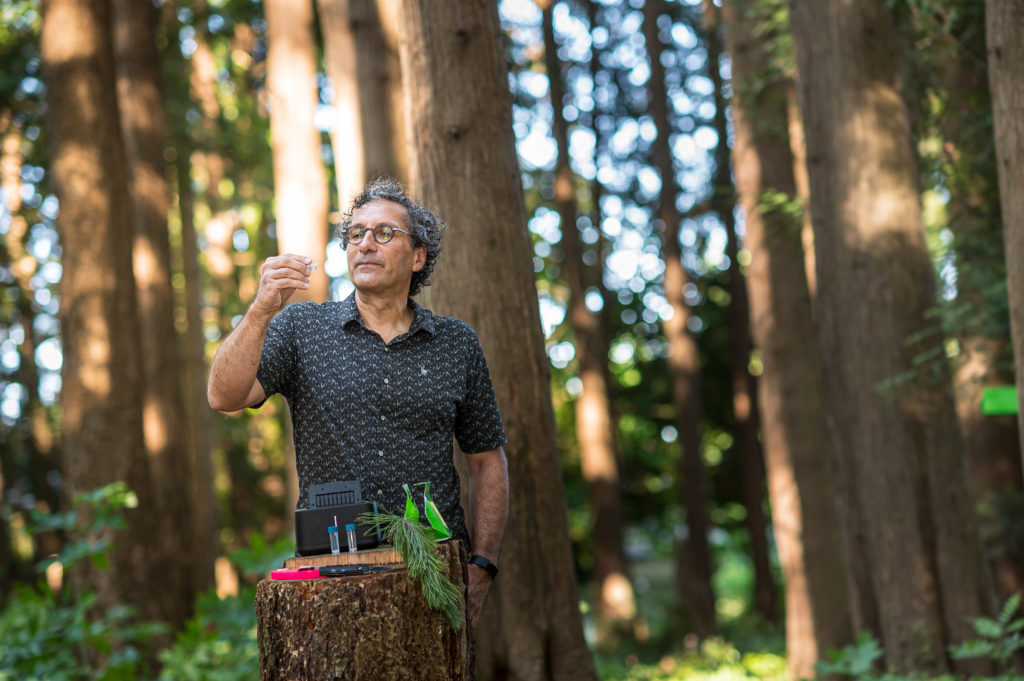 26/11/2020New method tests for harmful species like the Asian gypsy moth and sudden oak death pathogen Asian gypsy moths feed on a wide range of important plants and trees. White pine blister rust can kill young trees in only a couple of years. But it’s not always easy to detect the presence of these destructive species just by looking at spots and bumps on a tree, or on the exterior of a cargo ship. Now a new rapid DNA detection method developed at the University of British Columbia can identify these pests and pathogens in less than two hours, without using complicated processes or chemicals – a substantial time savings compared to the several days it currently takes to send samples to a lab for testing. Read More
26/11/2020New method tests for harmful species like the Asian gypsy moth and sudden oak death pathogen Asian gypsy moths feed on a wide range of important plants and trees. White pine blister rust can kill young trees in only a couple of years. But it’s not always easy to detect the presence of these destructive species just by looking at spots and bumps on a tree, or on the exterior of a cargo ship. Now a new rapid DNA detection method developed at the University of British Columbia can identify these pests and pathogens in less than two hours, without using complicated processes or chemicals – a substantial time savings compared to the several days it currently takes to send samples to a lab for testing. Read More -
 25/11/2020Invasive plants are everywhere – not just in our domestic gardens but on a grander scale on the grasslands of Kenya and Ethiopia as well as the Great Plains in the United States and Canada, including the world-famous Rocky Mountains. However, far from deserving a starring role in the latest Western movie, these ‘band’ of invasive species are a classic case of ‘The Good, The Bad and The Ugly’ that would even leave Clint Eastwood himself drifting off into the sunset in disgust. Read more
25/11/2020Invasive plants are everywhere – not just in our domestic gardens but on a grander scale on the grasslands of Kenya and Ethiopia as well as the Great Plains in the United States and Canada, including the world-famous Rocky Mountains. However, far from deserving a starring role in the latest Western movie, these ‘band’ of invasive species are a classic case of ‘The Good, The Bad and The Ugly’ that would even leave Clint Eastwood himself drifting off into the sunset in disgust. Read more -
 21/09/2020(From Marler et al. 2020 – Burrowing activity of coconut rhinoceros beetle on Guam cycads) Researchers at the Western Pacific Tropical Research Center at the University of Guam have documented what biologists call a “host shift” of the coconut rhinoceros beetle in Guam. The beetle, first documented as an invasive species in Guam in 2007, has been devastating the island’s ubiquitous coconut palms and is now also burrowing into Guam’s endangered native cycad tree, Cycas micronesica. The results were published in June in Volume 13 of the Communicative & Integrative Biology journal. Read more here
21/09/2020(From Marler et al. 2020 – Burrowing activity of coconut rhinoceros beetle on Guam cycads) Researchers at the Western Pacific Tropical Research Center at the University of Guam have documented what biologists call a “host shift” of the coconut rhinoceros beetle in Guam. The beetle, first documented as an invasive species in Guam in 2007, has been devastating the island’s ubiquitous coconut palms and is now also burrowing into Guam’s endangered native cycad tree, Cycas micronesica. The results were published in June in Volume 13 of the Communicative & Integrative Biology journal. Read more here -
 04/09/2020A new plant health laboratory is supporting the Fijian agriculture sector to protect regional food security against the rising threat of pests and diseases. Located within the Pacific Community’s (SPC) Narere campus, the new facility is the first of its kind for the region and was built with financial support from ACIAR. Designed to bolster regional capacity, the plant health laboratory enables SPC scientists to study various pests and diseases requiring a high level of biosecurity containment, such as insects, fungi, viruses, and bacteria. Read more here
04/09/2020A new plant health laboratory is supporting the Fijian agriculture sector to protect regional food security against the rising threat of pests and diseases. Located within the Pacific Community’s (SPC) Narere campus, the new facility is the first of its kind for the region and was built with financial support from ACIAR. Designed to bolster regional capacity, the plant health laboratory enables SPC scientists to study various pests and diseases requiring a high level of biosecurity containment, such as insects, fungi, viruses, and bacteria. Read more here -
 20/08/2020Image By Walthery – Own work, CC BY-SA 4.0, https://commons.wikimedia.org/w/index.php?curid=82863724 In mid-July, Reddit user erako shared a photo of some exotic-looking insects, curious as to what they were. The insects seemed out of place for Mississauga, Ont. — they were bright red, covered with black bands and spangled with white stars. The original poster couldn’t have anticipated the panicked messages and emergency emails that would ripple out across the internet and through multiple Canadian government agencies in response. Read more here
20/08/2020Image By Walthery – Own work, CC BY-SA 4.0, https://commons.wikimedia.org/w/index.php?curid=82863724 In mid-July, Reddit user erako shared a photo of some exotic-looking insects, curious as to what they were. The insects seemed out of place for Mississauga, Ont. — they were bright red, covered with black bands and spangled with white stars. The original poster couldn’t have anticipated the panicked messages and emergency emails that would ripple out across the internet and through multiple Canadian government agencies in response. Read more here -
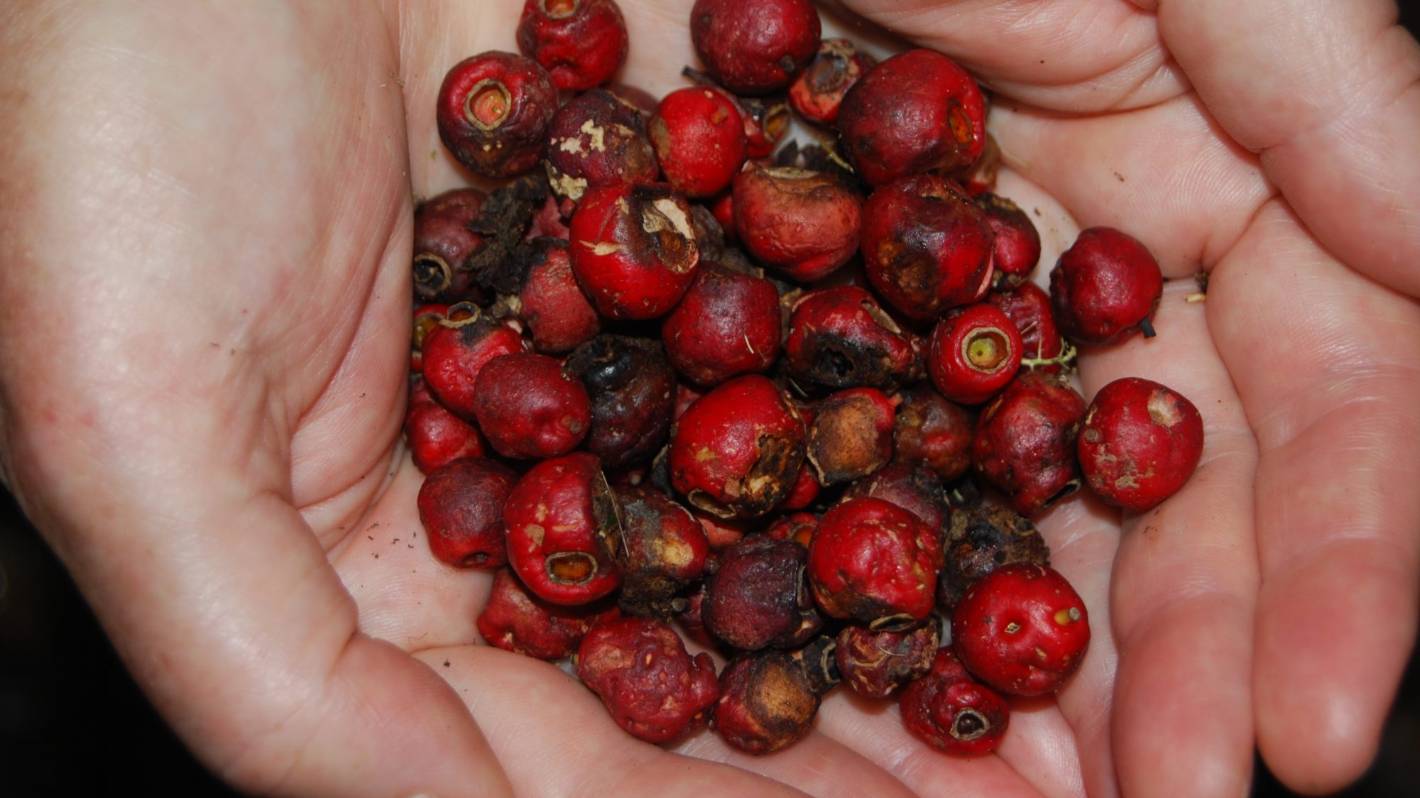 18/08/2020Kiwi scientists are racing to conserve trees and shrubs that may become extinct because of myrtle rust. “A strong message we received from colleagues in Australia is seed bank early,” said Karin Van der Walt of Otari Native Botanic Garden in Wellington. “Don’t wait, they said. Because once the [plants] don’t produce seeds, there’s nothing you can do.” “We are absolutely prioritising getting these species into seed banks,” she said. The exotic fungus, myrtle rust, was detected in Australia in 2010 and in New Zealand in 2017. Read more here
18/08/2020Kiwi scientists are racing to conserve trees and shrubs that may become extinct because of myrtle rust. “A strong message we received from colleagues in Australia is seed bank early,” said Karin Van der Walt of Otari Native Botanic Garden in Wellington. “Don’t wait, they said. Because once the [plants] don’t produce seeds, there’s nothing you can do.” “We are absolutely prioritising getting these species into seed banks,” she said. The exotic fungus, myrtle rust, was detected in Australia in 2010 and in New Zealand in 2017. Read more here -
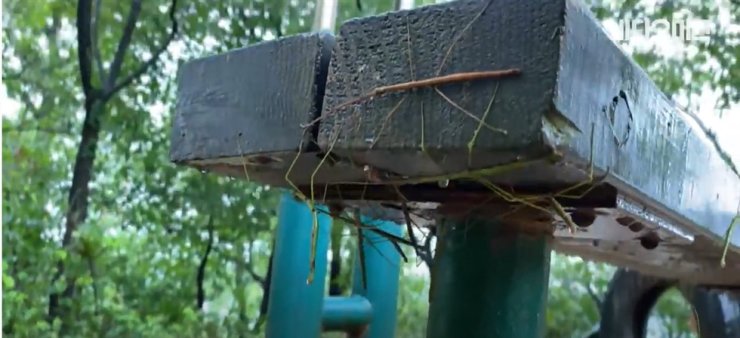 30/07/2020Korea is experiencing an insect population boom, which is in part an effect of climate change, environment experts said Wednesday. A mountain area in Eunpyeong District, western Seoul, has been hit with hordes of stick insects; a species found in abundance in tropical and subtropical climates. The huge number of green and brown insects can be seen over the entire mountain area. While local volunteers and officials from the local government have come together to solve the problem, news of the growing number of insects has concerned many local hikers who are “bug phobic.” Insect researcher Kim Tae-woo from the National Institute of Biological Resources said stick insects were not seen here until the 1990s. In 2014, a similar infestation was reported in Goyang, Gyeonggi Province but this is the first case in Seoul. However, the gypsy moth problem seems bigger. Read more here
30/07/2020Korea is experiencing an insect population boom, which is in part an effect of climate change, environment experts said Wednesday. A mountain area in Eunpyeong District, western Seoul, has been hit with hordes of stick insects; a species found in abundance in tropical and subtropical climates. The huge number of green and brown insects can be seen over the entire mountain area. While local volunteers and officials from the local government have come together to solve the problem, news of the growing number of insects has concerned many local hikers who are “bug phobic.” Insect researcher Kim Tae-woo from the National Institute of Biological Resources said stick insects were not seen here until the 1990s. In 2014, a similar infestation was reported in Goyang, Gyeonggi Province but this is the first case in Seoul. However, the gypsy moth problem seems bigger. Read more here -
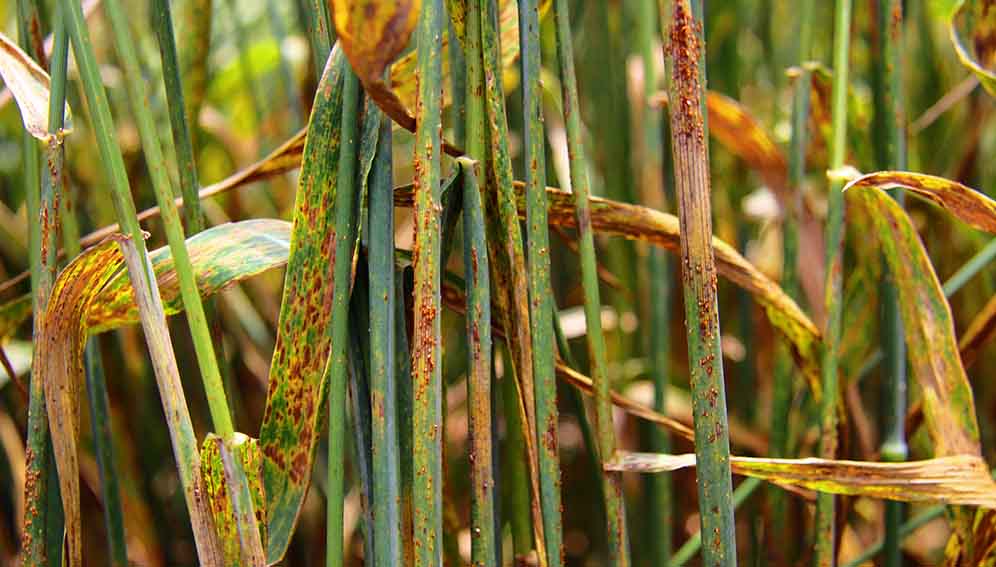 23/07/2020Global trade and monoculture will lead to crop disease pandemics that jeopardise world food systems, experts warn. A healthy wheat crop in Uganda, just weeks from harvest, turns into a tangle of black stems and shrivelled grains. As much as 80 per cent of the harvest is lost, a fate that destroys the farmer’s investment in the fields and damages the livelihood of the family. Soon wheat fields in Kenya, Ethiopia and Egypt experience the same fate. Iran follows, along with India, Pakistan and Lebanon. Then countries in Asia and Europe show signs. The culprit is wheat stem rust. A plant disease that has been known for decades, a virulent new strain, Ug99, emerged in 1999 to ravage wheat production across the globe — and was spread by the wind. Read more here:
23/07/2020Global trade and monoculture will lead to crop disease pandemics that jeopardise world food systems, experts warn. A healthy wheat crop in Uganda, just weeks from harvest, turns into a tangle of black stems and shrivelled grains. As much as 80 per cent of the harvest is lost, a fate that destroys the farmer’s investment in the fields and damages the livelihood of the family. Soon wheat fields in Kenya, Ethiopia and Egypt experience the same fate. Iran follows, along with India, Pakistan and Lebanon. Then countries in Asia and Europe show signs. The culprit is wheat stem rust. A plant disease that has been known for decades, a virulent new strain, Ug99, emerged in 1999 to ravage wheat production across the globe — and was spread by the wind. Read more here: -
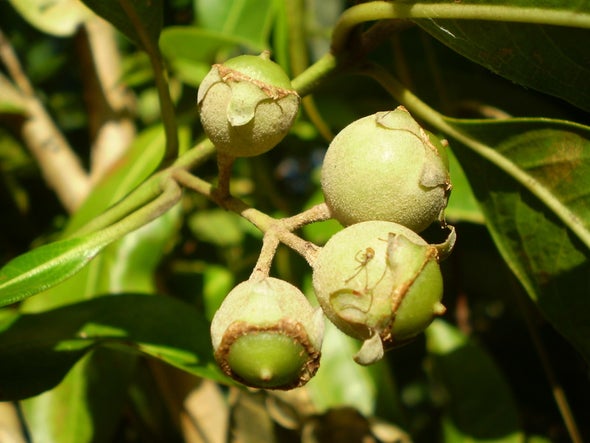 07/07/2020For Australia’s native guava, death came in the form of a fungus. Just 10 years ago, a virulent strain of the fungus Austropuccinia psidii arrived in New South Wales. First observed in Hawaii in 2005, the fungus causes a devastating plant disease called myrtle rust, which has quickly and mysteriously spread around the world—most likely through industrial shipping and other elements of our global economy. Each species that encounters the fungus displays different levels of resistance, but many plants experience deformed leaves, defoliation, stunted growth and even death. The fungus reproduces prodigiously, spewing out trillions of microscopic spores that can easily be carried to new areas by the wind. Read more here
07/07/2020For Australia’s native guava, death came in the form of a fungus. Just 10 years ago, a virulent strain of the fungus Austropuccinia psidii arrived in New South Wales. First observed in Hawaii in 2005, the fungus causes a devastating plant disease called myrtle rust, which has quickly and mysteriously spread around the world—most likely through industrial shipping and other elements of our global economy. Each species that encounters the fungus displays different levels of resistance, but many plants experience deformed leaves, defoliation, stunted growth and even death. The fungus reproduces prodigiously, spewing out trillions of microscopic spores that can easily be carried to new areas by the wind. Read more here -
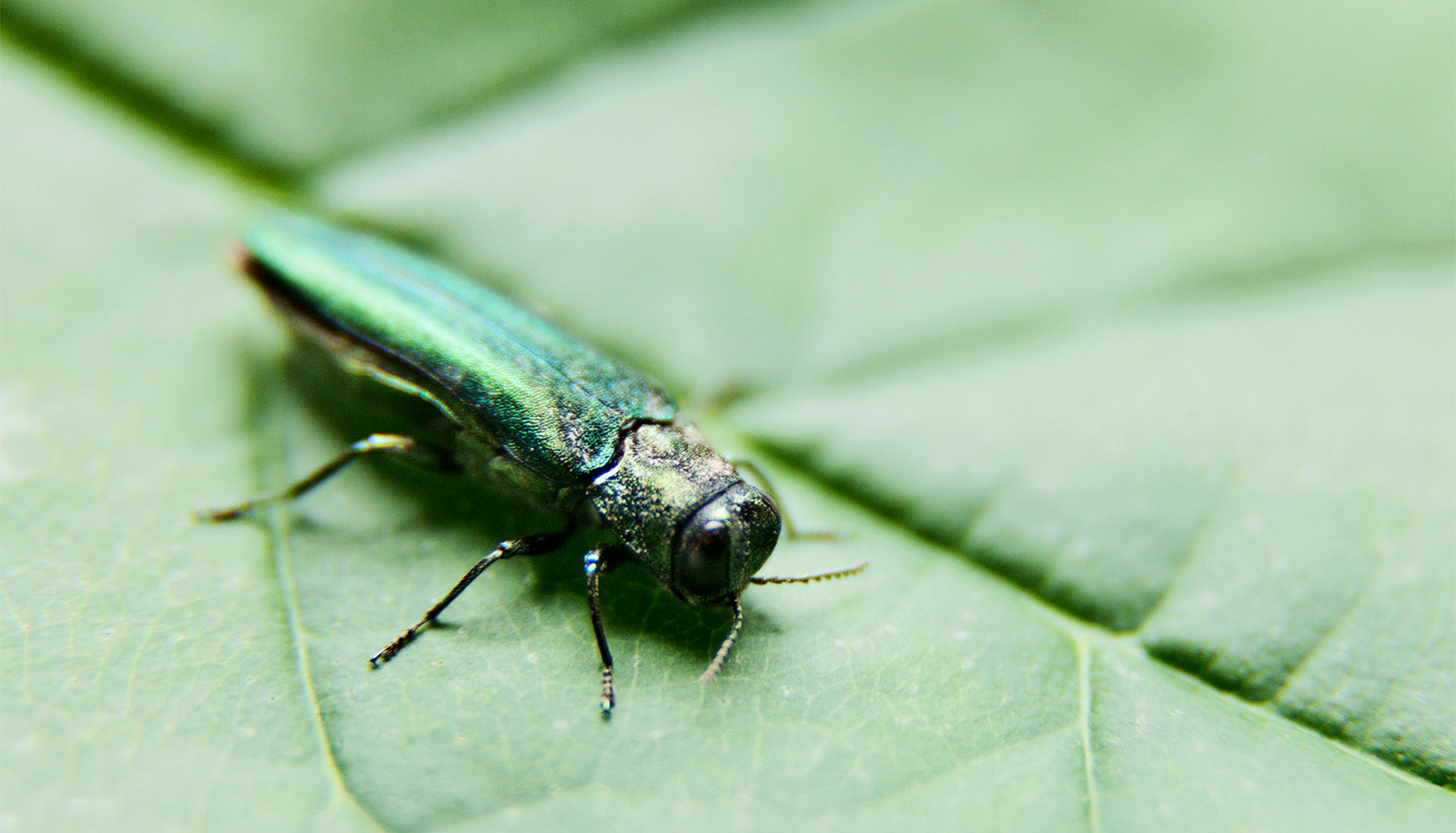 03/07/2020In a new study, scientists from around the world — including a professor at the University of Rhode Island — warn that the threats posed by invasive alien species are increasing. They say that urgent action is required to prevent, detect and control invaders at both local and global levels. Alien species are plants, animals and microbes that are introduced by people, accidentally or intentionally, into areas where they do not naturally occur. Many of them thrive, spreading widely with harmful effects on the environment, economy, or human health. The study, published in the journal Biological Reviews, was carried out by a team of researchers from 13 countries across Africa, Asia, Australasia, Europe, and North and South America. It states that the number of invasive alien species is increasing rapidly, with more than 18,000 currently listed around the world. Read more here
03/07/2020In a new study, scientists from around the world — including a professor at the University of Rhode Island — warn that the threats posed by invasive alien species are increasing. They say that urgent action is required to prevent, detect and control invaders at both local and global levels. Alien species are plants, animals and microbes that are introduced by people, accidentally or intentionally, into areas where they do not naturally occur. Many of them thrive, spreading widely with harmful effects on the environment, economy, or human health. The study, published in the journal Biological Reviews, was carried out by a team of researchers from 13 countries across Africa, Asia, Australasia, Europe, and North and South America. It states that the number of invasive alien species is increasing rapidly, with more than 18,000 currently listed around the world. Read more here -
 03/07/2020News SAVE THE DATE Forest Invasive species – the next global pandemic? Webinar – 29 July 2020, 10:00-11:00 hrs CET Stay tuned for more details!
03/07/2020News SAVE THE DATE Forest Invasive species – the next global pandemic? Webinar – 29 July 2020, 10:00-11:00 hrs CET Stay tuned for more details! -
 25/06/2020Native to China and the Korean Peninsula, the Asian longhorned beetle (ALB), Anoplophora glabripennis, has been introduced to North America and Europe. In both its native range and the territory it has invaded, ALB is responsible for the death or removal of millions of urban, roadside, and forest trees. Here, we present the population genetic structure of ALB in South Korea, using 801 bp of mitochondrial DNA and the most comprehensive sampling to date. ALB populations in South Korea are divided into three distinct geographical subgroups: the northeastern natural forest, and the western and southern urban areas. Historical records suggest that the forest-dwelling subgroup is native, as does the moderate genetic diversity of this population. Meanwhile, the fact that ALB was first observed in the western and southern areas only recently, the extreme genetic bottleneck status of these populations, their distribution in large port cities and adjacent areas, and the difference in observed host plants used by the forest subgroup and the urban subgroups suggest that the urban populations are non-native recent invaders. Approximate Bayesian computation suggests that the western and southern subgroups most likely originated from northeastern and northwestern China, respectively. Therefore, our study demonstrates that ALB invasion has occurred even within the species’ native territory. This finding alters our perception of biological invasion by providing a unique example of a species that has invaded its own native range. Access full paper here
25/06/2020Native to China and the Korean Peninsula, the Asian longhorned beetle (ALB), Anoplophora glabripennis, has been introduced to North America and Europe. In both its native range and the territory it has invaded, ALB is responsible for the death or removal of millions of urban, roadside, and forest trees. Here, we present the population genetic structure of ALB in South Korea, using 801 bp of mitochondrial DNA and the most comprehensive sampling to date. ALB populations in South Korea are divided into three distinct geographical subgroups: the northeastern natural forest, and the western and southern urban areas. Historical records suggest that the forest-dwelling subgroup is native, as does the moderate genetic diversity of this population. Meanwhile, the fact that ALB was first observed in the western and southern areas only recently, the extreme genetic bottleneck status of these populations, their distribution in large port cities and adjacent areas, and the difference in observed host plants used by the forest subgroup and the urban subgroups suggest that the urban populations are non-native recent invaders. Approximate Bayesian computation suggests that the western and southern subgroups most likely originated from northeastern and northwestern China, respectively. Therefore, our study demonstrates that ALB invasion has occurred even within the species’ native territory. This finding alters our perception of biological invasion by providing a unique example of a species that has invaded its own native range. Access full paper here -
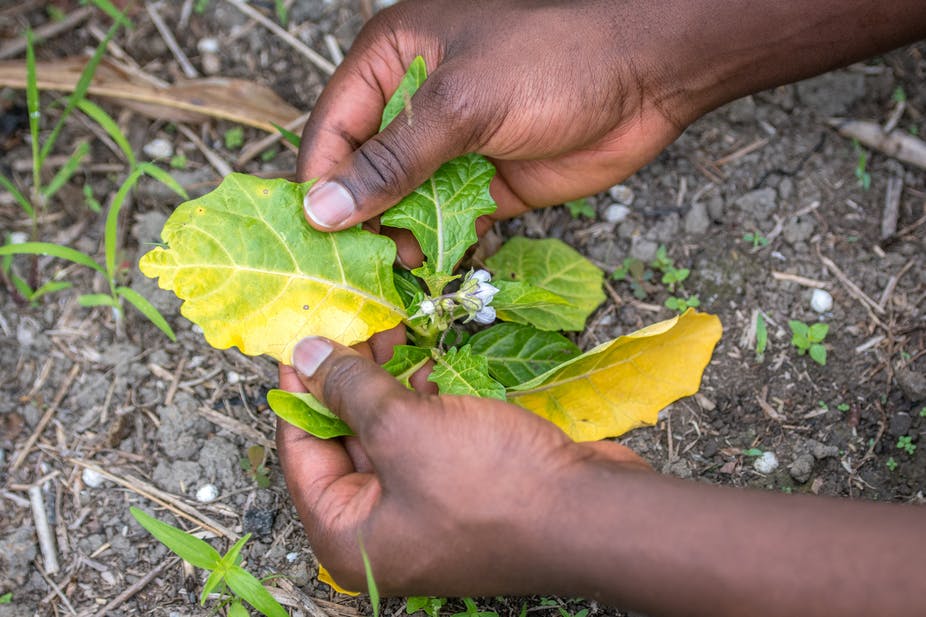 13/06/2020Most of us understand the critical importance of monitoring the spread of diseases. And it is as important for plant diseases as it is for humans. Plant disease epidemics are often hidden from view, unlike human viral disease outbreaks. Yet food and forest production systems, as well as native environments around the world, are just as threatened by emerging epidemics. That is why the UN has made 2020 the International Year of Plant Health. It is estimated that pests and pathogens destroy between 10% and 40% of food production globally. There are ways to deal with this problem, starting with biosecurity and plant health management systems. But this is yet another system that’s been put under tremendous pressure by the emergence of COVID-19. Under restrictions on human movement – necessary to curb the virus’ spread – the field and laboratory work that are crucial for surveillance and management of plant diseases has been severely curtailed. Read more here
13/06/2020Most of us understand the critical importance of monitoring the spread of diseases. And it is as important for plant diseases as it is for humans. Plant disease epidemics are often hidden from view, unlike human viral disease outbreaks. Yet food and forest production systems, as well as native environments around the world, are just as threatened by emerging epidemics. That is why the UN has made 2020 the International Year of Plant Health. It is estimated that pests and pathogens destroy between 10% and 40% of food production globally. There are ways to deal with this problem, starting with biosecurity and plant health management systems. But this is yet another system that’s been put under tremendous pressure by the emergence of COVID-19. Under restrictions on human movement – necessary to curb the virus’ spread – the field and laboratory work that are crucial for surveillance and management of plant diseases has been severely curtailed. Read more here -
 29/05/2020The Australian Department of Agriculture, Water and the Environment conducted a risk analysis for the release of the rust fungus Puccinia spegazzinii for the biological control of the weed Mikania micrantha. The final report recommends that the release of P. spegazzinii should be permitted, subject to standard quarantine conditions associated with the import and release of biological control agents, and determined the overall risk associated with the release of P. spegazzinii to be Negligible.
29/05/2020The Australian Department of Agriculture, Water and the Environment conducted a risk analysis for the release of the rust fungus Puccinia spegazzinii for the biological control of the weed Mikania micrantha. The final report recommends that the release of P. spegazzinii should be permitted, subject to standard quarantine conditions associated with the import and release of biological control agents, and determined the overall risk associated with the release of P. spegazzinii to be Negligible. -
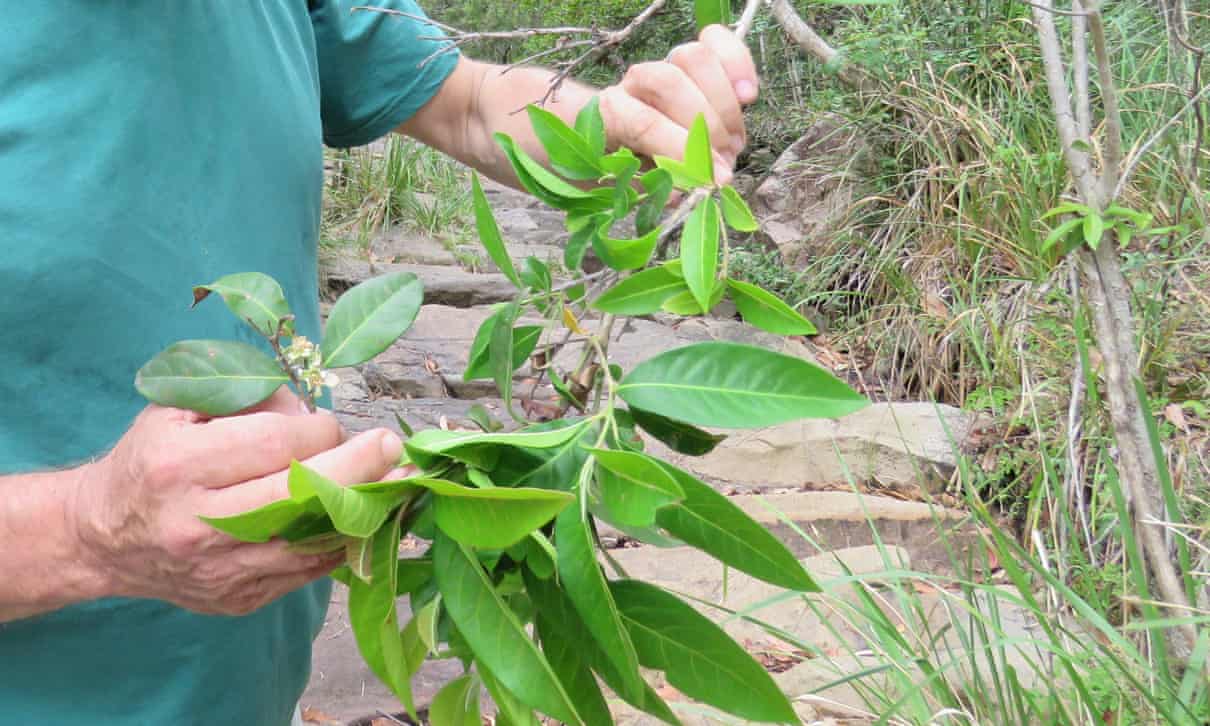 15/05/2020An invasive plant disease may be ready to claim its first victim in the wild with Australia’s native guava now almost extinct, a study has found. Monitoring of 66 populations of native guava in Queensland and New South Wales has found 23% “could not be located” with another 61% reduced only to root suckers below a dead canopy. The fungal plant disease myrtle rust was first detected in Australia in 2010, but already has more than 350 known hosts across the country. Read the full story.
15/05/2020An invasive plant disease may be ready to claim its first victim in the wild with Australia’s native guava now almost extinct, a study has found. Monitoring of 66 populations of native guava in Queensland and New South Wales has found 23% “could not be located” with another 61% reduced only to root suckers below a dead canopy. The fungal plant disease myrtle rust was first detected in Australia in 2010, but already has more than 350 known hosts across the country. Read the full story. -
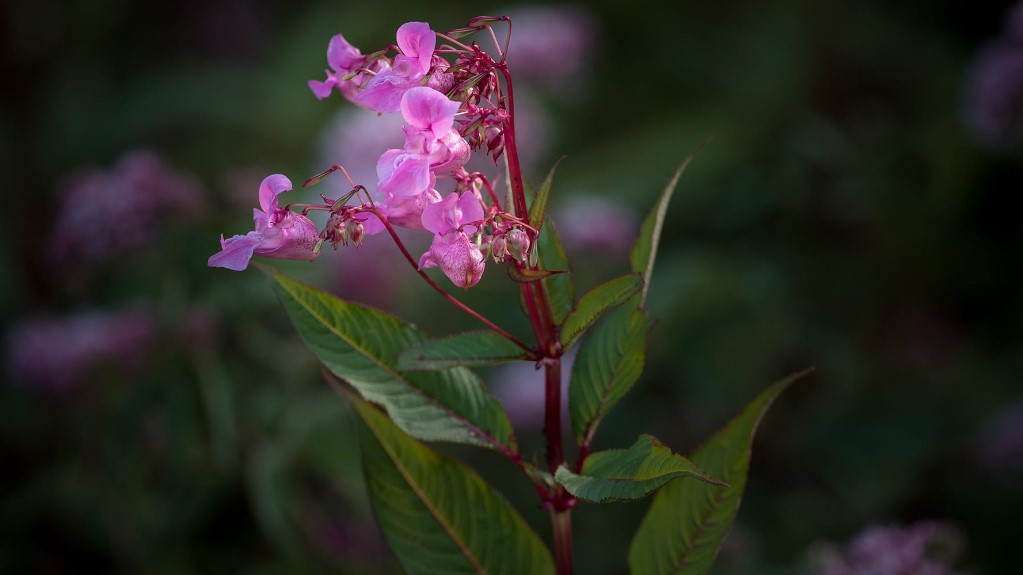 13/05/2020Colonising rail and river banks, wastelands and woodlands, Himalayan balsam was introduced to the British Isles in 1839 by Victorian plant hunters who were keen on its beautiful pink flowers and exploding seed pods. The plant has had plenty of time to establish in the UK and, over the last 50 years, has spread rapidly. But Himalayan balsam is a problematic plant. It competes with native plants for light, nutrients, pollinators and space, excluding other plants and reducing biodiversity. It dies back in the winter, leaving river banks bare and open to erosion. Dead leaves and plant debris from the weed block waterways and lead to flooding.
13/05/2020Colonising rail and river banks, wastelands and woodlands, Himalayan balsam was introduced to the British Isles in 1839 by Victorian plant hunters who were keen on its beautiful pink flowers and exploding seed pods. The plant has had plenty of time to establish in the UK and, over the last 50 years, has spread rapidly. But Himalayan balsam is a problematic plant. It competes with native plants for light, nutrients, pollinators and space, excluding other plants and reducing biodiversity. It dies back in the winter, leaving river banks bare and open to erosion. Dead leaves and plant debris from the weed block waterways and lead to flooding. -
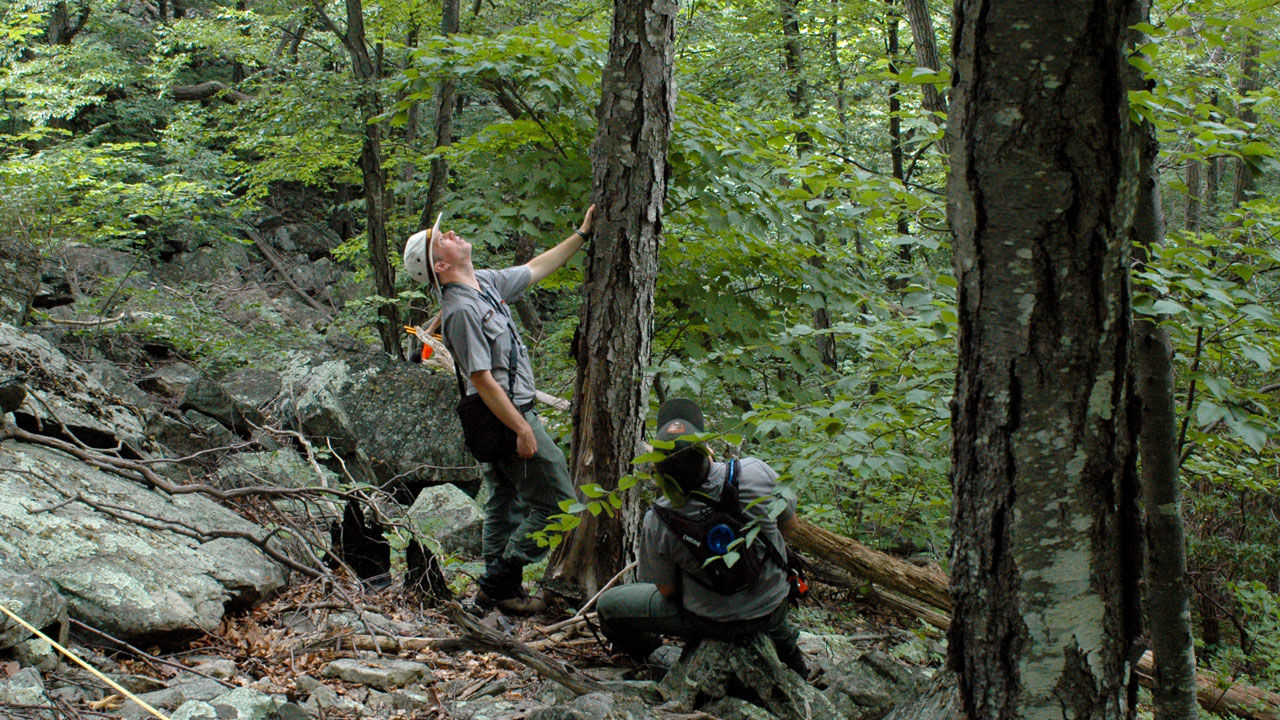 13/05/2020From a deadly fungus that showed its face in 1904 on an American chestnut in the Bronx to a nematode recently found to kill American beeches in Ohio, forests in the United States have faced more than 100 years’ worth of attacks from introduced pests and pathogens. But how much of a chunk are these invaders actually taking out of the woods? A new study suggests the impact is severe, accounting for one-quarter of all tree deaths in eastern U.S. forests over the past 3 decades.
13/05/2020From a deadly fungus that showed its face in 1904 on an American chestnut in the Bronx to a nematode recently found to kill American beeches in Ohio, forests in the United States have faced more than 100 years’ worth of attacks from introduced pests and pathogens. But how much of a chunk are these invaders actually taking out of the woods? A new study suggests the impact is severe, accounting for one-quarter of all tree deaths in eastern U.S. forests over the past 3 decades. -
 30/04/2020The International Plant Protection Convention (IPPC) Secretariat is soliciting: Phytosanitary technical resources and case studies (e.g. manuals, standard operating procedures, advocacy materials, factsheets, infographics, training materials, risk assessments, guidelines, tools) The IPPC Secretariat periodically issues calls for existing phytosanitary technical resources developed by NPPOs, RPPOs and other organizations that may be shared with the IPPC community. The submitted materials are reviewed by the Implementation and Capacity Development Committee (IC) against established criteria. Suitable materials are made available on the IPP as Contributed Resources (https://www.ippc.int/en/core-activities/capacity-development/guides-and-training-materials/contributed-resource-list/). The aim of this call is to collect additional resources that may be shared among NPPOs and other stakeholders.
30/04/2020The International Plant Protection Convention (IPPC) Secretariat is soliciting: Phytosanitary technical resources and case studies (e.g. manuals, standard operating procedures, advocacy materials, factsheets, infographics, training materials, risk assessments, guidelines, tools) The IPPC Secretariat periodically issues calls for existing phytosanitary technical resources developed by NPPOs, RPPOs and other organizations that may be shared with the IPPC community. The submitted materials are reviewed by the Implementation and Capacity Development Committee (IC) against established criteria. Suitable materials are made available on the IPP as Contributed Resources (https://www.ippc.int/en/core-activities/capacity-development/guides-and-training-materials/contributed-resource-list/). The aim of this call is to collect additional resources that may be shared among NPPOs and other stakeholders. -
 29/04/2020CABI is providing two weeks free access to its Crop Pest Diagnosis online course to encourage knowledge expansion on healthy plants – supporting students and plant health specialists during the coronavirus COVID-19 pandemic. Registrants can benefit from the course, which is designed to support extension workers and plant doctors directly, as well as teachers and trainers in agricultural education institutions and the workplace, online or using an app. Around 40% of crops worldwide are lost to pests – putting the livelihoods of millions of smallholder farmers and global food security at risk – but CABI is helping to mitigate these challenges through its expertise in plant health and Integrated Pest Management (IPM) using, where possible, more sustainable biological controls. The Crop Pest Diagnosis course features 15 hours of training across five modules, over 400 knowledge checks and 1,000 images for symptom recognition. The course supports field-based diagnosis using the Diagnostic Field Guide and covers pathogens, pests and nutrient deficiencies. It complements Crop Pest Management of which both interactive courses sit within the CABI Academy.
29/04/2020CABI is providing two weeks free access to its Crop Pest Diagnosis online course to encourage knowledge expansion on healthy plants – supporting students and plant health specialists during the coronavirus COVID-19 pandemic. Registrants can benefit from the course, which is designed to support extension workers and plant doctors directly, as well as teachers and trainers in agricultural education institutions and the workplace, online or using an app. Around 40% of crops worldwide are lost to pests – putting the livelihoods of millions of smallholder farmers and global food security at risk – but CABI is helping to mitigate these challenges through its expertise in plant health and Integrated Pest Management (IPM) using, where possible, more sustainable biological controls. The Crop Pest Diagnosis course features 15 hours of training across five modules, over 400 knowledge checks and 1,000 images for symptom recognition. The course supports field-based diagnosis using the Diagnostic Field Guide and covers pathogens, pests and nutrient deficiencies. It complements Crop Pest Management of which both interactive courses sit within the CABI Academy. -
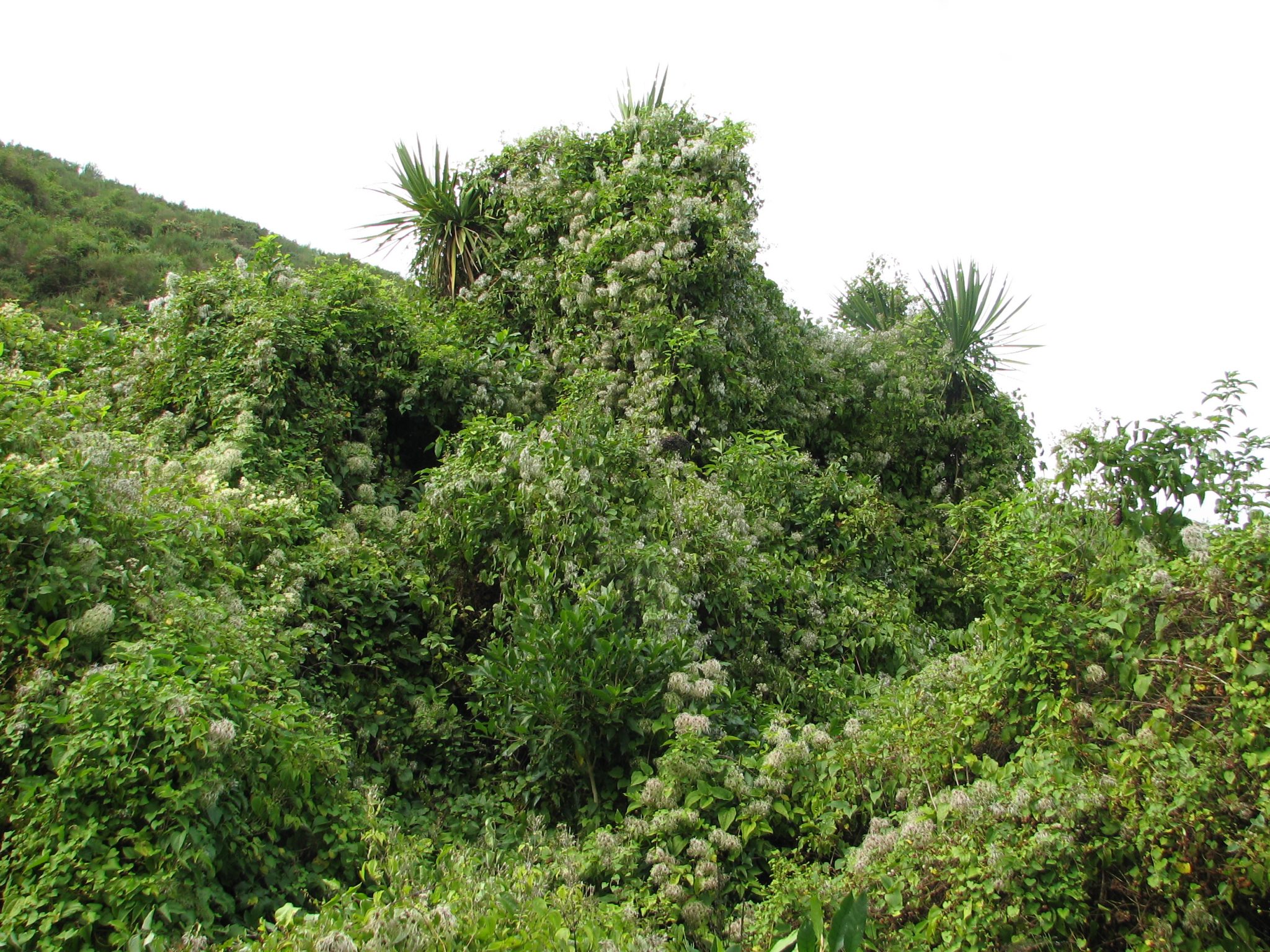 28/04/2020The number of non-native plant species established outside of cultivation in the New Zealand archipelago is higher than for any other islands worldwide. Faced with this scale of plant invasions, there has been considerable investment in the scientific and operational aspects of prevention, eradication and control. As a result, New Zealand is ideally placed to illustrate the many challenges that plant invasions present worldwide as well as the possible solutions. New Zealand has been at the forefront of biosecurity policy developments to tackle plant invasions being one of the first countries to: (a) implement national legislation to address the management of non-native plants; (b) establish a national permitted list (white-list) for plant imports; and (c) introduce bans on the sale, distribution, or propagation of non-native plant species. However, these preventative measure are only effective where there are also adequate border inspection regimes, compliance monitoring of the horticulture industry, and surveillance of internet trade. Open access article in Biological Invasions
28/04/2020The number of non-native plant species established outside of cultivation in the New Zealand archipelago is higher than for any other islands worldwide. Faced with this scale of plant invasions, there has been considerable investment in the scientific and operational aspects of prevention, eradication and control. As a result, New Zealand is ideally placed to illustrate the many challenges that plant invasions present worldwide as well as the possible solutions. New Zealand has been at the forefront of biosecurity policy developments to tackle plant invasions being one of the first countries to: (a) implement national legislation to address the management of non-native plants; (b) establish a national permitted list (white-list) for plant imports; and (c) introduce bans on the sale, distribution, or propagation of non-native plant species. However, these preventative measure are only effective where there are also adequate border inspection regimes, compliance monitoring of the horticulture industry, and surveillance of internet trade. Open access article in Biological Invasions -
 12/02/2020Insect pests cause billions of dollars in damage each year and they spread numerous dangerous diseases. If professionals attempting to control pest insect species had information about when those species reached the developmental stages at which they are most vulnerable to control measures, management efforts could be more economical, more effective, and less damaging to nontarget species and the environment. To provide such a resource on a nationwide scale, the USA National Phenology Network (USA-NPN) developed its “Pheno Forecast” maps. The program provides daily maps and forecasts for target pest species that forest managers and integrated pest management professionals can use to optimize their pest-control efforts. The program presently focuses on pests of woody species, but plans are in development to expand the program to include other categories of insects. Read more here
12/02/2020Insect pests cause billions of dollars in damage each year and they spread numerous dangerous diseases. If professionals attempting to control pest insect species had information about when those species reached the developmental stages at which they are most vulnerable to control measures, management efforts could be more economical, more effective, and less damaging to nontarget species and the environment. To provide such a resource on a nationwide scale, the USA National Phenology Network (USA-NPN) developed its “Pheno Forecast” maps. The program provides daily maps and forecasts for target pest species that forest managers and integrated pest management professionals can use to optimize their pest-control efforts. The program presently focuses on pests of woody species, but plans are in development to expand the program to include other categories of insects. Read more here -
 07/01/2020In the Pacific, ecosystems hang in a delicate balance. The isolation of Pacific islands lends them a natural protection from invasive species that continental ecosystems don’t have. But when an alien species does alight on these remote shores, they can wreak havoc. Invasive species are the number one cause of extinction of single-country endemic species in the Pacific. 5.8 per cent of the Pacific’s 2,189 single-country endemic species are already extinct. 45 per cent are at immediate risk.
07/01/2020In the Pacific, ecosystems hang in a delicate balance. The isolation of Pacific islands lends them a natural protection from invasive species that continental ecosystems don’t have. But when an alien species does alight on these remote shores, they can wreak havoc. Invasive species are the number one cause of extinction of single-country endemic species in the Pacific. 5.8 per cent of the Pacific’s 2,189 single-country endemic species are already extinct. 45 per cent are at immediate risk. -
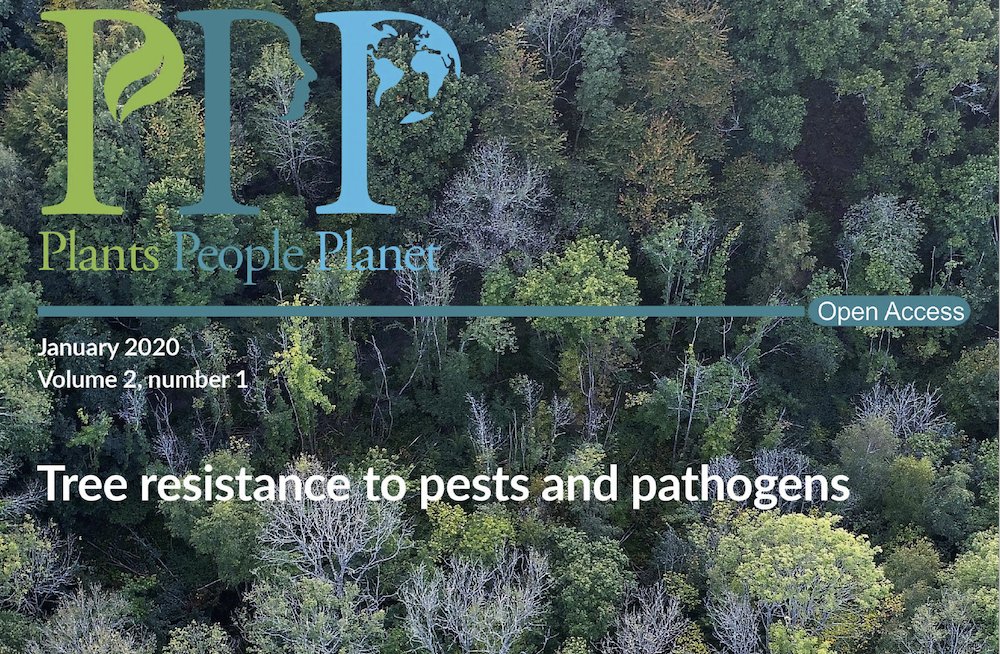 07/01/2020Plants are threatened in a globalised world because people are transporting pests and pathogens around the planet at unprecedented rates. Natural resistance to pests and pathogens has never been more important. In this special issue of Plants, People, Planet we focus on resistance found in tree populations. This has long been a neglected area of research, but one that is ripe for rapid progress using genomic methods. See this Open Access special issue of Plants, People, Planet as part of the International Year of Plant Health: https://nph.onlinelibrary.wiley.com/toc/25722611/2020/2/1
07/01/2020Plants are threatened in a globalised world because people are transporting pests and pathogens around the planet at unprecedented rates. Natural resistance to pests and pathogens has never been more important. In this special issue of Plants, People, Planet we focus on resistance found in tree populations. This has long been a neglected area of research, but one that is ripe for rapid progress using genomic methods. See this Open Access special issue of Plants, People, Planet as part of the International Year of Plant Health: https://nph.onlinelibrary.wiley.com/toc/25722611/2020/2/1 -
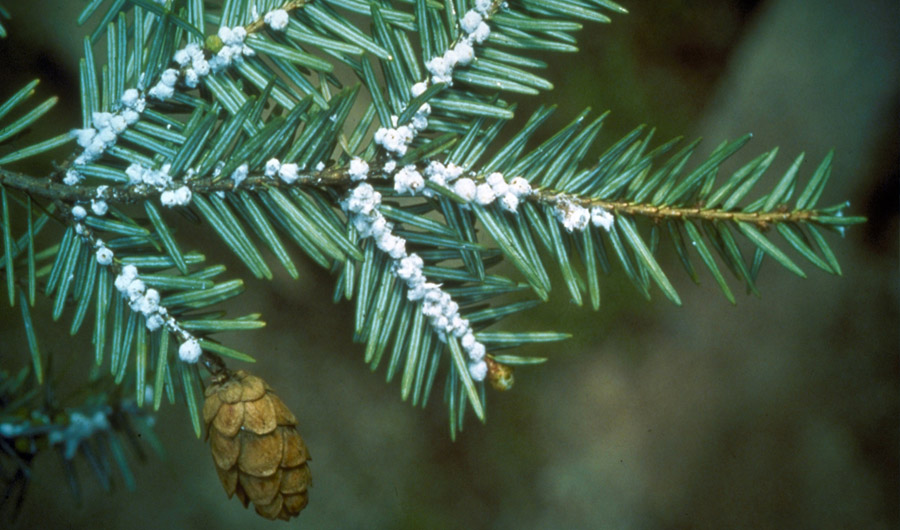 10/11/2019Plagues of forest-destroying insects seem to arrive on our shores almost as regularly as ocean waves. Their names – hemlock woolly adelgid, emerald ash borer, Asian longhorned beetle, spotted lanternfly – only hint at the damage they trigger. The dead trees they leave behind cost billions to remove and add more than 5 million metric tons of carbon annually to the atmosphere, an amount roughly equal to the annual output of 4.4 million cars. Yet for each major tree killer, around half a dozen foreign insects live quietly in our forests, causing few noticeable problems. A new study may help scientists pick out the future tree killers from the crowd, and it has a surprising conclusion: It’s the characteristics of the trees that insects feed on, not the insects themselves, that matter.
10/11/2019Plagues of forest-destroying insects seem to arrive on our shores almost as regularly as ocean waves. Their names – hemlock woolly adelgid, emerald ash borer, Asian longhorned beetle, spotted lanternfly – only hint at the damage they trigger. The dead trees they leave behind cost billions to remove and add more than 5 million metric tons of carbon annually to the atmosphere, an amount roughly equal to the annual output of 4.4 million cars. Yet for each major tree killer, around half a dozen foreign insects live quietly in our forests, causing few noticeable problems. A new study may help scientists pick out the future tree killers from the crowd, and it has a surprising conclusion: It’s the characteristics of the trees that insects feed on, not the insects themselves, that matter. -
 04/11/2019This is a joint meeting of IUFRO units: 7.03.12 – Alien Invasive Species and International Trade 7.03.07 – Population Dynamics of Forest Insects 8.02.04 – Ecology of Alien Invasives The conference will focus on invasions of non-native insects, tree pathogens, plants and other organisms in forest ecosystems. Topics addressed will include the role of trade and travel as pathways for invasions, the ecology and impact of non-native species in forests as well as the management of invasions and biosecurity. The conference will be held on the campus of the Czech University of Life Sciences located in Prague and will include a 1-day field trip in addition to contributed and invited scientific presentations. Registration and submission of abstracts will begin in January. To receive future mailings about the conference enter your contact info at https://iufro.czu.cz/en/r-15091-info-form
04/11/2019This is a joint meeting of IUFRO units: 7.03.12 – Alien Invasive Species and International Trade 7.03.07 – Population Dynamics of Forest Insects 8.02.04 – Ecology of Alien Invasives The conference will focus on invasions of non-native insects, tree pathogens, plants and other organisms in forest ecosystems. Topics addressed will include the role of trade and travel as pathways for invasions, the ecology and impact of non-native species in forests as well as the management of invasions and biosecurity. The conference will be held on the campus of the Czech University of Life Sciences located in Prague and will include a 1-day field trip in addition to contributed and invited scientific presentations. Registration and submission of abstracts will begin in January. To receive future mailings about the conference enter your contact info at https://iufro.czu.cz/en/r-15091-info-form -
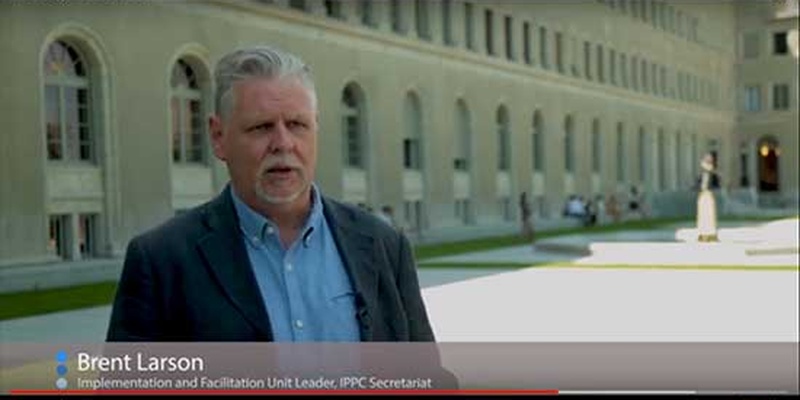 04/11/2019The Standards and Trade Development Facility (STDF)’s working group of global experts met at the World Trade Organization’s headquarters from 15 to 17 October 2019 to continue revising the STDF Strategy (2020-2024). They also reviewed grant applications for STDF funding and discussed how to increase the capacity of developing countries to implement international standards. A new video Investing in Safe Trade highlighting the benefits for developing countries of working with the STDF was launched at the meeting. It is available at: https://www.youtube.com/c/STDFvideos
04/11/2019The Standards and Trade Development Facility (STDF)’s working group of global experts met at the World Trade Organization’s headquarters from 15 to 17 October 2019 to continue revising the STDF Strategy (2020-2024). They also reviewed grant applications for STDF funding and discussed how to increase the capacity of developing countries to implement international standards. A new video Investing in Safe Trade highlighting the benefits for developing countries of working with the STDF was launched at the meeting. It is available at: https://www.youtube.com/c/STDFvideos -
 04/11/2019CABI has launched a new product to help facilitate and improve the biosecurity of plants and plant products being traded around the world that are at risk of invasive pests such as the Colorado beetle – a major threat to potato crops. The Pest Risk Analysis (PRA) Tool is an add-on to the Crop Protection Compendium (CPC) – funded by the UK Department for International Development (DFID) and the Netherlands Directorate-General for International Cooperation (DGIS) through the Action on Invasives programme – which allows National Plant Protection Organizations (NPPOs) to carry out risk assessments on plant commodity imports.
04/11/2019CABI has launched a new product to help facilitate and improve the biosecurity of plants and plant products being traded around the world that are at risk of invasive pests such as the Colorado beetle – a major threat to potato crops. The Pest Risk Analysis (PRA) Tool is an add-on to the Crop Protection Compendium (CPC) – funded by the UK Department for International Development (DFID) and the Netherlands Directorate-General for International Cooperation (DGIS) through the Action on Invasives programme – which allows National Plant Protection Organizations (NPPOs) to carry out risk assessments on plant commodity imports. -
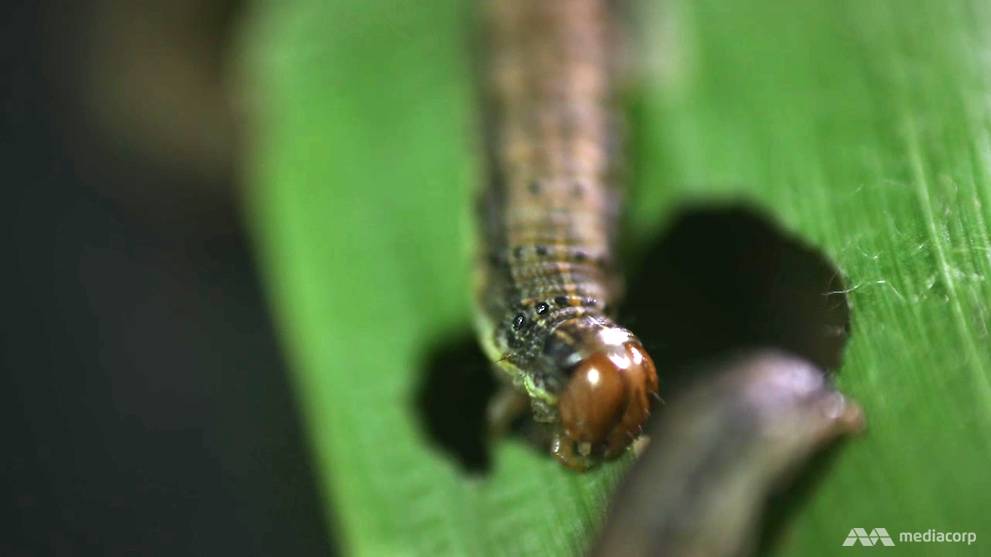 21/10/2019NAKHON RATCHASIMA, Thailand: It is an insect species almost no one in Singapore has heard of, and it grows to no longer than two inches. But the fall armyworm is one hungry caterpillar that has devastated cornfields across Asia in a short time, threatening an agricultural disaster. Corn is found in many things, including animal feed. So a corn shortage could mean higher prices of cereal, toothpaste, chicken and more.
21/10/2019NAKHON RATCHASIMA, Thailand: It is an insect species almost no one in Singapore has heard of, and it grows to no longer than two inches. But the fall armyworm is one hungry caterpillar that has devastated cornfields across Asia in a short time, threatening an agricultural disaster. Corn is found in many things, including animal feed. So a corn shortage could mean higher prices of cereal, toothpaste, chicken and more. -
 02/10/2019Abstract: Management of invasive alien species is increasingly challenging mainly because of the failure of past global efforts to slow down the rate of invasion and increasing globalization of trade and transport. Developing countries like Nepal are further constrained due to the lack of adequate scientific knowledge to inform policy and management. This has resulted in weak policy and management responses, thereby exposing the country to a high threat of further invasions. This paper presents a brief review of the diversity, distribution, and impacts of invasive alien plants (IAPs), current management practices and policy responses, and future prospects for their management in Nepal. At least 183 vascular exotic plant species (4 pteridophytes and 179 flowering plants) are naturalized in Nepal, and among these are 26 invasive angiosperm species, including 4 from the list of 100 of the world’s worst invasive species. The IAPs have invaded agroecosystems and the natural environment including protected areas and Ramsar sites from tropical lowland to temperate mountain zones. Impacts of a few IAPs have been examined, and they range from habitat degradation and species displacement to negative impacts on the livelihood of farming communities. Cultural and physical methods are the common control measures adopted, while a few biological control agents have also arrived fortuitously. As a policy response, the National Biodiversity Strategy and Action Plan 2014 prioritized inventory, impact assessment, identification of dispersal pathways, public education and participation, and biological control programs. Future prospects for the IAPs management in Nepal includes eradication of Myriophyllum aquaticum, prevention of Mikania micranthaand Chromolaena odorata from being spread to western Nepal, inclusion of IAPs management in community forestry programs and conservation management plans of protected areas, invasion risk assessment of species before introduction, government funding for education and research, strengthening biological control programs, and regional collaboration through common management strategies.
02/10/2019Abstract: Management of invasive alien species is increasingly challenging mainly because of the failure of past global efforts to slow down the rate of invasion and increasing globalization of trade and transport. Developing countries like Nepal are further constrained due to the lack of adequate scientific knowledge to inform policy and management. This has resulted in weak policy and management responses, thereby exposing the country to a high threat of further invasions. This paper presents a brief review of the diversity, distribution, and impacts of invasive alien plants (IAPs), current management practices and policy responses, and future prospects for their management in Nepal. At least 183 vascular exotic plant species (4 pteridophytes and 179 flowering plants) are naturalized in Nepal, and among these are 26 invasive angiosperm species, including 4 from the list of 100 of the world’s worst invasive species. The IAPs have invaded agroecosystems and the natural environment including protected areas and Ramsar sites from tropical lowland to temperate mountain zones. Impacts of a few IAPs have been examined, and they range from habitat degradation and species displacement to negative impacts on the livelihood of farming communities. Cultural and physical methods are the common control measures adopted, while a few biological control agents have also arrived fortuitously. As a policy response, the National Biodiversity Strategy and Action Plan 2014 prioritized inventory, impact assessment, identification of dispersal pathways, public education and participation, and biological control programs. Future prospects for the IAPs management in Nepal includes eradication of Myriophyllum aquaticum, prevention of Mikania micranthaand Chromolaena odorata from being spread to western Nepal, inclusion of IAPs management in community forestry programs and conservation management plans of protected areas, invasion risk assessment of species before introduction, government funding for education and research, strengthening biological control programs, and regional collaboration through common management strategies. -
 01/10/2019A new strain of the beetle, CRB-G, is resistant to traditional control methods, and the government said it could cause $US150 million dollars to be lost from the Pacific’s coconut and palm oil industries every year. CRB-G is established in Papua New Guinea and Solomon Islands where it is damaging palm trees. New Zealand is contributing about $US11 million dollars to the fight, some of which will go to science institute AgResearch.
01/10/2019A new strain of the beetle, CRB-G, is resistant to traditional control methods, and the government said it could cause $US150 million dollars to be lost from the Pacific’s coconut and palm oil industries every year. CRB-G is established in Papua New Guinea and Solomon Islands where it is damaging palm trees. New Zealand is contributing about $US11 million dollars to the fight, some of which will go to science institute AgResearch. -
 25/09/2019A new statistical modelling tool will enable land management authorities to predict where invasive weed species are most likely to grow so they can find and eliminate plants before they have time to spread widely. In the study, published in the journal Methods in Ecology and Evolution, the researchers developed the tool that uses information about the features of a weed species and the geography of the area in which it has been reported to predict specific locations where the weed is likely to spread to first. The paper is open access and it and additional information and files are available at: https://doi.org/10.1111/2041-210X.13284 The tools are available here: Geoprocessing: https://jens-g-froese.shinyapps.io/riskmapr_geoprocessing/ Suitability model: https://jens-g-froese.shinyapps.io/riskmapr_suitability/ Susceptibility model: https://jens-g-froese.shinyapps.io/riskmapr_susceptibility/
25/09/2019A new statistical modelling tool will enable land management authorities to predict where invasive weed species are most likely to grow so they can find and eliminate plants before they have time to spread widely. In the study, published in the journal Methods in Ecology and Evolution, the researchers developed the tool that uses information about the features of a weed species and the geography of the area in which it has been reported to predict specific locations where the weed is likely to spread to first. The paper is open access and it and additional information and files are available at: https://doi.org/10.1111/2041-210X.13284 The tools are available here: Geoprocessing: https://jens-g-froese.shinyapps.io/riskmapr_geoprocessing/ Suitability model: https://jens-g-froese.shinyapps.io/riskmapr_suitability/ Susceptibility model: https://jens-g-froese.shinyapps.io/riskmapr_susceptibility/ -
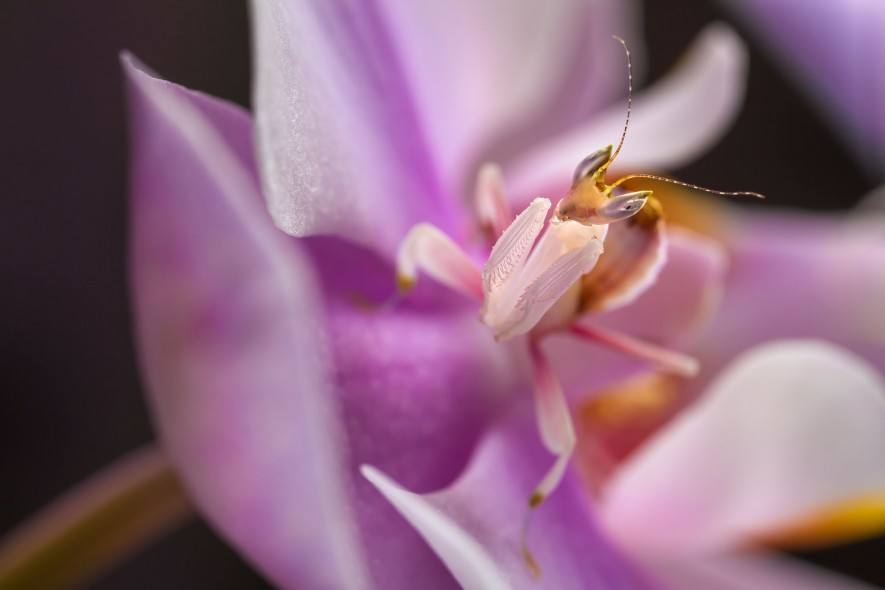 15/09/2019Introducing an animal where it doesn’t naturally belong can be a problem too. If invertebrates smuggled into a new country get loose, they, or the parasites they host, can gobble up or otherwise harm native crops, plants, trees, or animals. “When you don’t know what’s coming in, there’s always that little concern,” says Greg Bartman, a U.S. Department of Agriculture employee who identifies insects found in cargo shipments. He points to the Indian walking stick insect as a cautionary tale: He suspects the exotic pet trade brought them to Southern California, where they’re wreaking havoc on hibiscuses, ivy, rosebushes, and other plants. And giant African millipedes (the same species of arthropods that escaped from a package addressed to Wlodzimie Lapkiewicz)? They sometimes carry a mite that can destroy bulb crops such as onions and garlic.
15/09/2019Introducing an animal where it doesn’t naturally belong can be a problem too. If invertebrates smuggled into a new country get loose, they, or the parasites they host, can gobble up or otherwise harm native crops, plants, trees, or animals. “When you don’t know what’s coming in, there’s always that little concern,” says Greg Bartman, a U.S. Department of Agriculture employee who identifies insects found in cargo shipments. He points to the Indian walking stick insect as a cautionary tale: He suspects the exotic pet trade brought them to Southern California, where they’re wreaking havoc on hibiscuses, ivy, rosebushes, and other plants. And giant African millipedes (the same species of arthropods that escaped from a package addressed to Wlodzimie Lapkiewicz)? They sometimes carry a mite that can destroy bulb crops such as onions and garlic. -
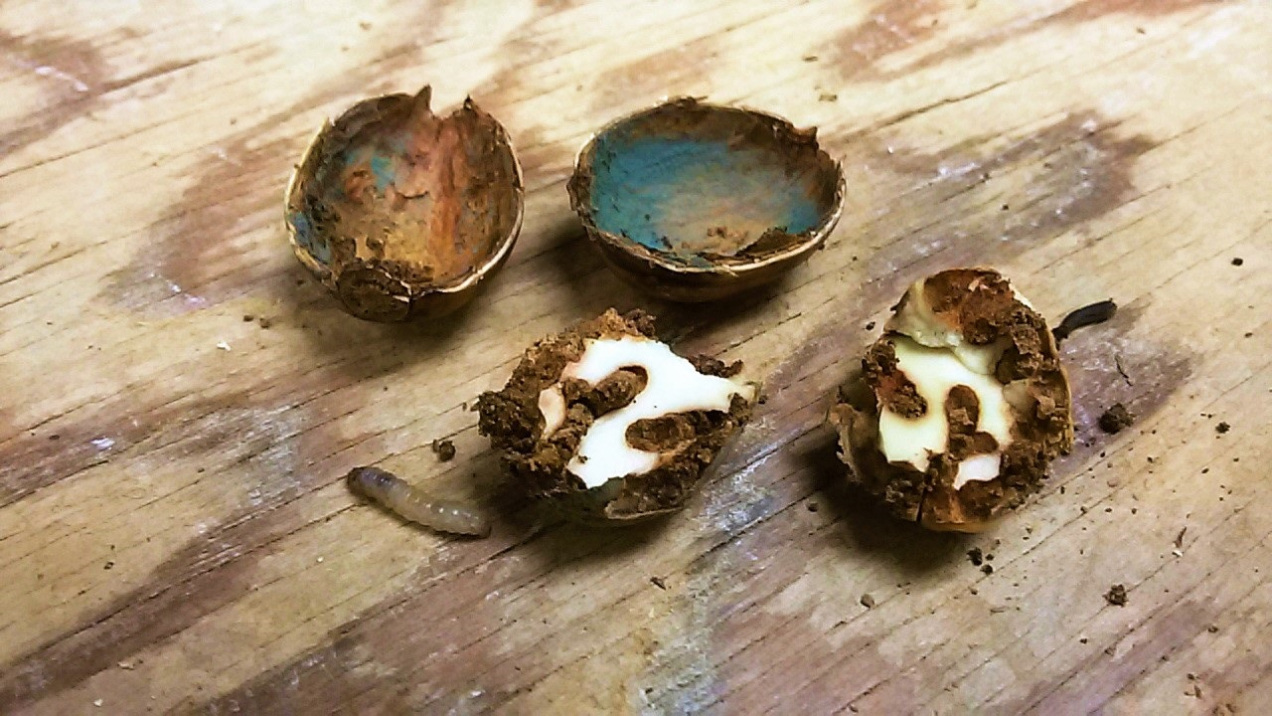 12/09/2019CABI has led an international team of scientists who strongly suggest that the global trade of forest tree seeds is not as safe as previously believed, with insect pests and fungal pathogens posing a great risk to trees and forest ecosystems worldwide. Non-native insect pests and fungal pathogens present one of the major threats to trees and forest ecosystems globally, with the potential to cause significant ecological changes and economic losses.
12/09/2019CABI has led an international team of scientists who strongly suggest that the global trade of forest tree seeds is not as safe as previously believed, with insect pests and fungal pathogens posing a great risk to trees and forest ecosystems worldwide. Non-native insect pests and fungal pathogens present one of the major threats to trees and forest ecosystems globally, with the potential to cause significant ecological changes and economic losses. -
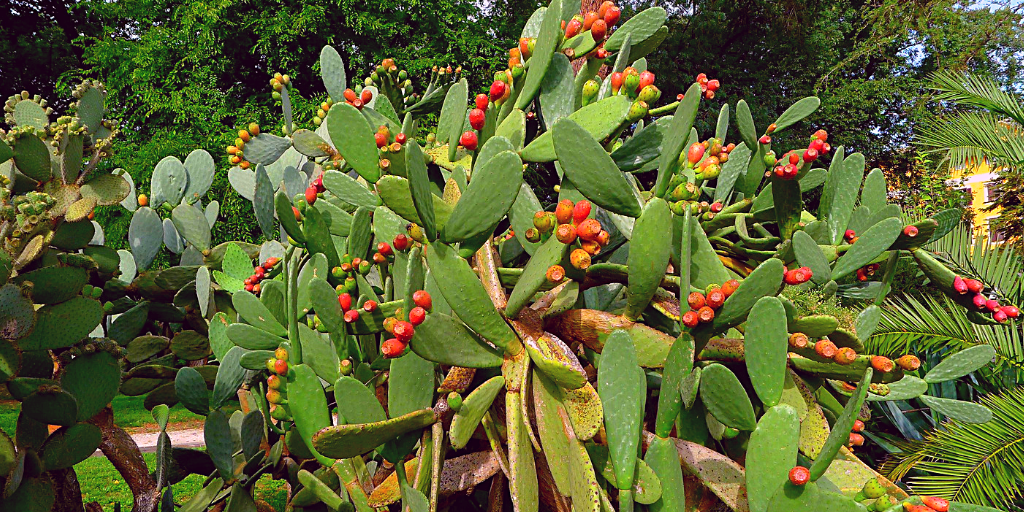 12/09/2019Invasions from alien plants, animals, and pathogens threaten the economies of the world’s poorest nations, according to a new study. One-sixth of the global land surface is highly vulnerable to invasion, including substantial areas in developing countries and biodiversity hotspots, according to the study published in Nature Communications.
12/09/2019Invasions from alien plants, animals, and pathogens threaten the economies of the world’s poorest nations, according to a new study. One-sixth of the global land surface is highly vulnerable to invasion, including substantial areas in developing countries and biodiversity hotspots, according to the study published in Nature Communications. -
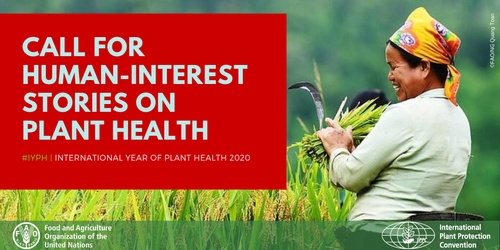 05/09/2019FAO and the IPPC Secretariat are calling for inspiring first-hand stories on plant health to promote the International Year of Plant Health (IYPH) 2020. Deadlines of the Call for human-interest stories on plant health have been extended as follows: • Applicants can send their story proposals by 30 September 2019; • Finalized stories and images must be sent using the specific template by 15 November 2019 (see IYPH – My Story Annex 1). The My Story template and all the instructions for submissions are provided at the link below: http://www.fao.org/3/ca5426en/ca5426en.pdf
05/09/2019FAO and the IPPC Secretariat are calling for inspiring first-hand stories on plant health to promote the International Year of Plant Health (IYPH) 2020. Deadlines of the Call for human-interest stories on plant health have been extended as follows: • Applicants can send their story proposals by 30 September 2019; • Finalized stories and images must be sent using the specific template by 15 November 2019 (see IYPH – My Story Annex 1). The My Story template and all the instructions for submissions are provided at the link below: http://www.fao.org/3/ca5426en/ca5426en.pdf -
 04/09/2019In addition to the ecological impact, the devastation invasive pests wreak on trees reduces carbon storage equivalent to the amount of carbon emitted by 5 million vehicles each year. Invasive insects and pathogens have wreaked havoc on ash, elm, chestnut, and other trees, wiping some almost completely from American forests. The trees the 15 most invasive pests kill each year contain 5.53 teragrams of carbon (TgC), equivalent to about 6 million US tons.
04/09/2019In addition to the ecological impact, the devastation invasive pests wreak on trees reduces carbon storage equivalent to the amount of carbon emitted by 5 million vehicles each year. Invasive insects and pathogens have wreaked havoc on ash, elm, chestnut, and other trees, wiping some almost completely from American forests. The trees the 15 most invasive pests kill each year contain 5.53 teragrams of carbon (TgC), equivalent to about 6 million US tons. -
 04/09/2019Plants are going extinct 350 times faster than ever before … and invasive species are one of the key drivers! Earlier this year a United Nations report predicted that up to one million species and half of all plant life on earth may be extinct by the end of the century. Additionally, a recent study documented that 571 plant species have disappeared over the past 250 years. Now, a new study shows that plants have been lost at a rate that is 350 times greater than the average rate of plant extinctions observed in the fossil record.
04/09/2019Plants are going extinct 350 times faster than ever before … and invasive species are one of the key drivers! Earlier this year a United Nations report predicted that up to one million species and half of all plant life on earth may be extinct by the end of the century. Additionally, a recent study documented that 571 plant species have disappeared over the past 250 years. Now, a new study shows that plants have been lost at a rate that is 350 times greater than the average rate of plant extinctions observed in the fossil record. -
 23/08/2019The IPPC Secretariat is soliciting submissions of any existing relevant technical resources for the revision of the IPPC Guide on Plant Pest Surveillance (2019-047).
23/08/2019The IPPC Secretariat is soliciting submissions of any existing relevant technical resources for the revision of the IPPC Guide on Plant Pest Surveillance (2019-047). -
 23/08/2019As Dutch elm disease spread across Britain in the 1970s, the country fell into mourning. When the sentinel trees that framed our horizons were felled, their loss was a constant topic of sad and angry conversation. Today, just a few years into the equally devastating ash dieback epidemic, and as the first great trees are toppled, most of us appear to have forgotten all about it.
23/08/2019As Dutch elm disease spread across Britain in the 1970s, the country fell into mourning. When the sentinel trees that framed our horizons were felled, their loss was a constant topic of sad and angry conversation. Today, just a few years into the equally devastating ash dieback epidemic, and as the first great trees are toppled, most of us appear to have forgotten all about it. -
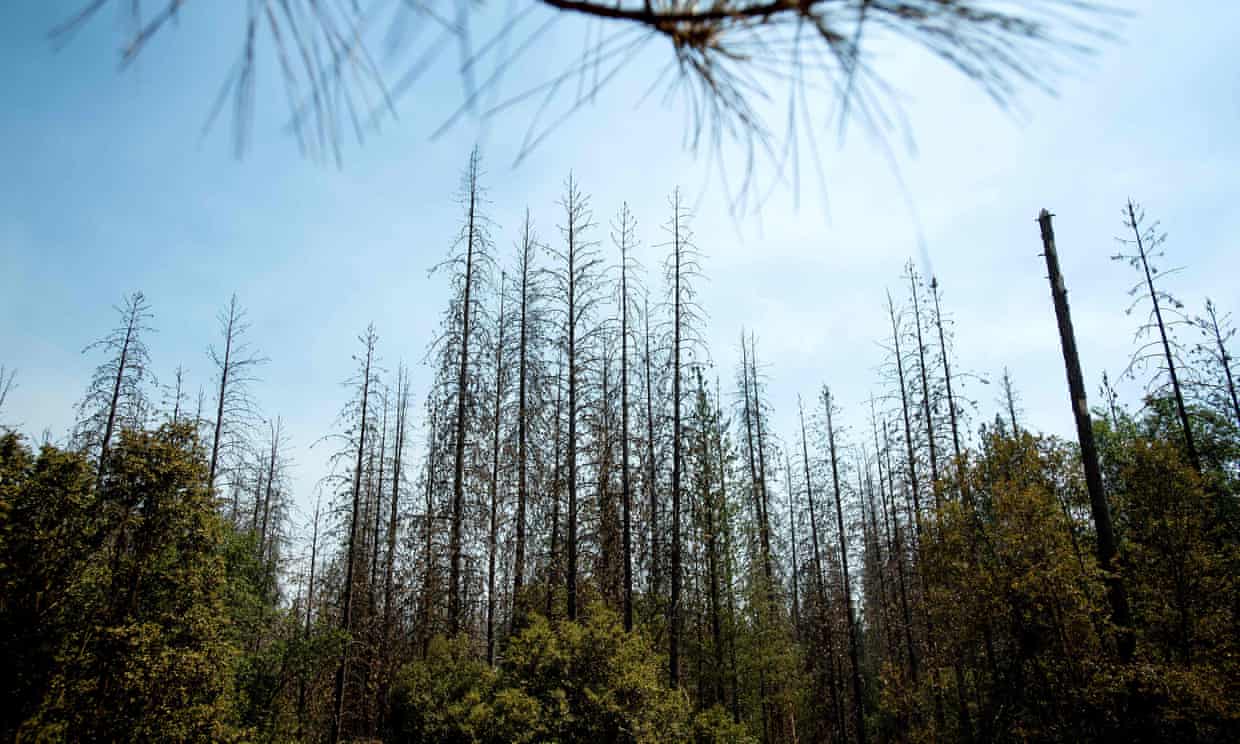 15/08/2019About 40% of all forests across the US are at risk of being ravaged by an army of harmful pests, undermining a crucial resource in addressing the climate crisis, new research has found.
15/08/2019About 40% of all forests across the US are at risk of being ravaged by an army of harmful pests, undermining a crucial resource in addressing the climate crisis, new research has found. -
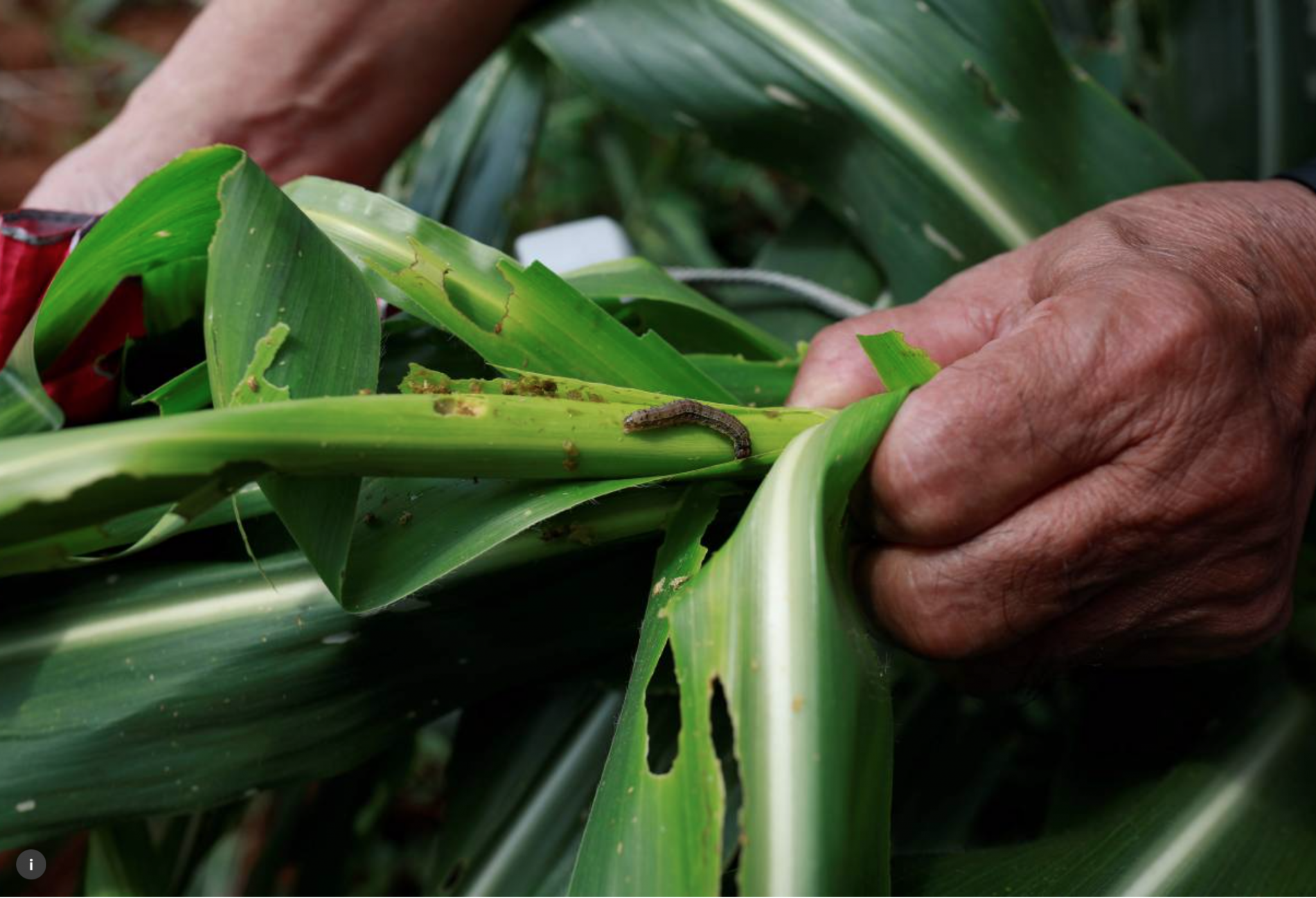 09/08/2019There has been a baffling absence of an international alliance to track and respond to the movement of invasive species. An opinion piece by Buyung Hadi, an Aspen New Voices Fellow, an Indonesian entomologist working on sustainable rice-based crop production. He serves as Cambodian country representative for International Rice Research Institute (IRRI).
09/08/2019There has been a baffling absence of an international alliance to track and respond to the movement of invasive species. An opinion piece by Buyung Hadi, an Aspen New Voices Fellow, an Indonesian entomologist working on sustainable rice-based crop production. He serves as Cambodian country representative for International Rice Research Institute (IRRI). -
 06/08/2019Vessels & break-bulk cargo can introduce exotic pests & diseases into new areas. @DeptAgNews developed a new video explaining how to manage pests & diseases that may be present in imported goods & containers at approved arrangement sites.
06/08/2019Vessels & break-bulk cargo can introduce exotic pests & diseases into new areas. @DeptAgNews developed a new video explaining how to manage pests & diseases that may be present in imported goods & containers at approved arrangement sites. -
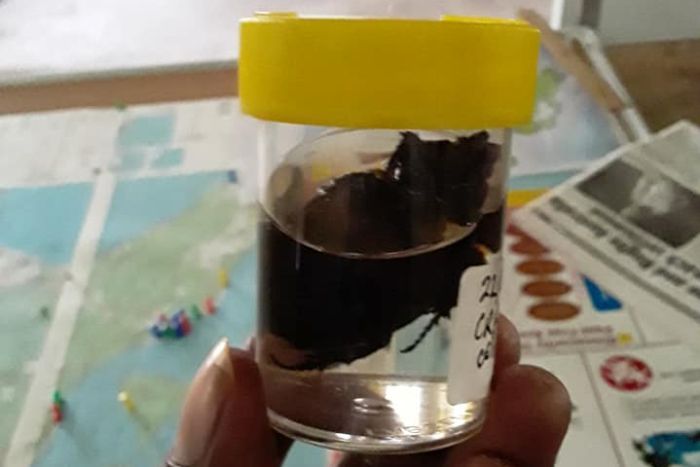 25/07/2019A state of emergency has been declared in Vanuatu not because of a natural disaster or civil unrest, but because of a beetle. The coconut rhinoceros beetle has the potential to devastate the country’s coconut industry, as well as the livelihoods of the tens of thousands of people who depend upon it. The pest was first found on the north-west coast of Efate island in May, not far from the capital Port Vila, and has since been found at sites several kilometres away. Read more…
25/07/2019A state of emergency has been declared in Vanuatu not because of a natural disaster or civil unrest, but because of a beetle. The coconut rhinoceros beetle has the potential to devastate the country’s coconut industry, as well as the livelihoods of the tens of thousands of people who depend upon it. The pest was first found on the north-west coast of Efate island in May, not far from the capital Port Vila, and has since been found at sites several kilometres away. Read more… -
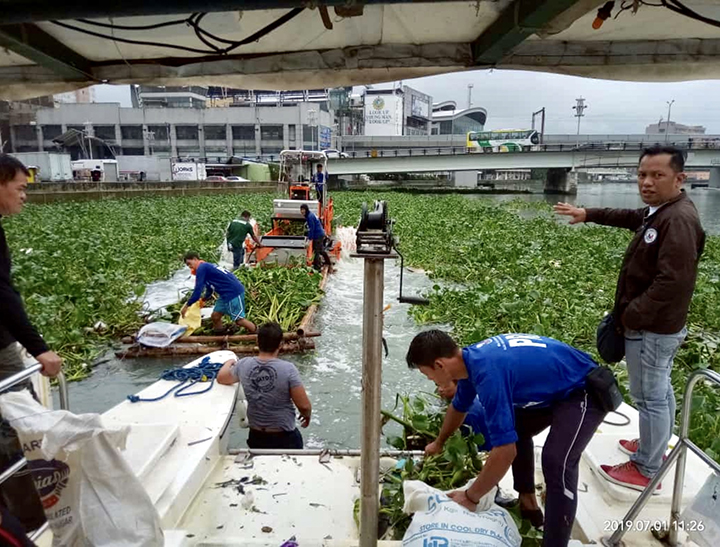 25/07/2019From afar, the sight of the green, leafy, free-floating aquatic plants over vast water bodies add aesthetic value to nature’s serenity. However, at a closer look, the fear of the unknown suddenly kicks in. And it is not for a good reason. What appears to be naturally occurring, the water hyacinth, which is native to tropical and subtropical South America, has broad, thick, glossy, ovate leaves. This pervasive plant can rise above the surface by as much a meter in height. Read more…
25/07/2019From afar, the sight of the green, leafy, free-floating aquatic plants over vast water bodies add aesthetic value to nature’s serenity. However, at a closer look, the fear of the unknown suddenly kicks in. And it is not for a good reason. What appears to be naturally occurring, the water hyacinth, which is native to tropical and subtropical South America, has broad, thick, glossy, ovate leaves. This pervasive plant can rise above the surface by as much a meter in height. Read more… -
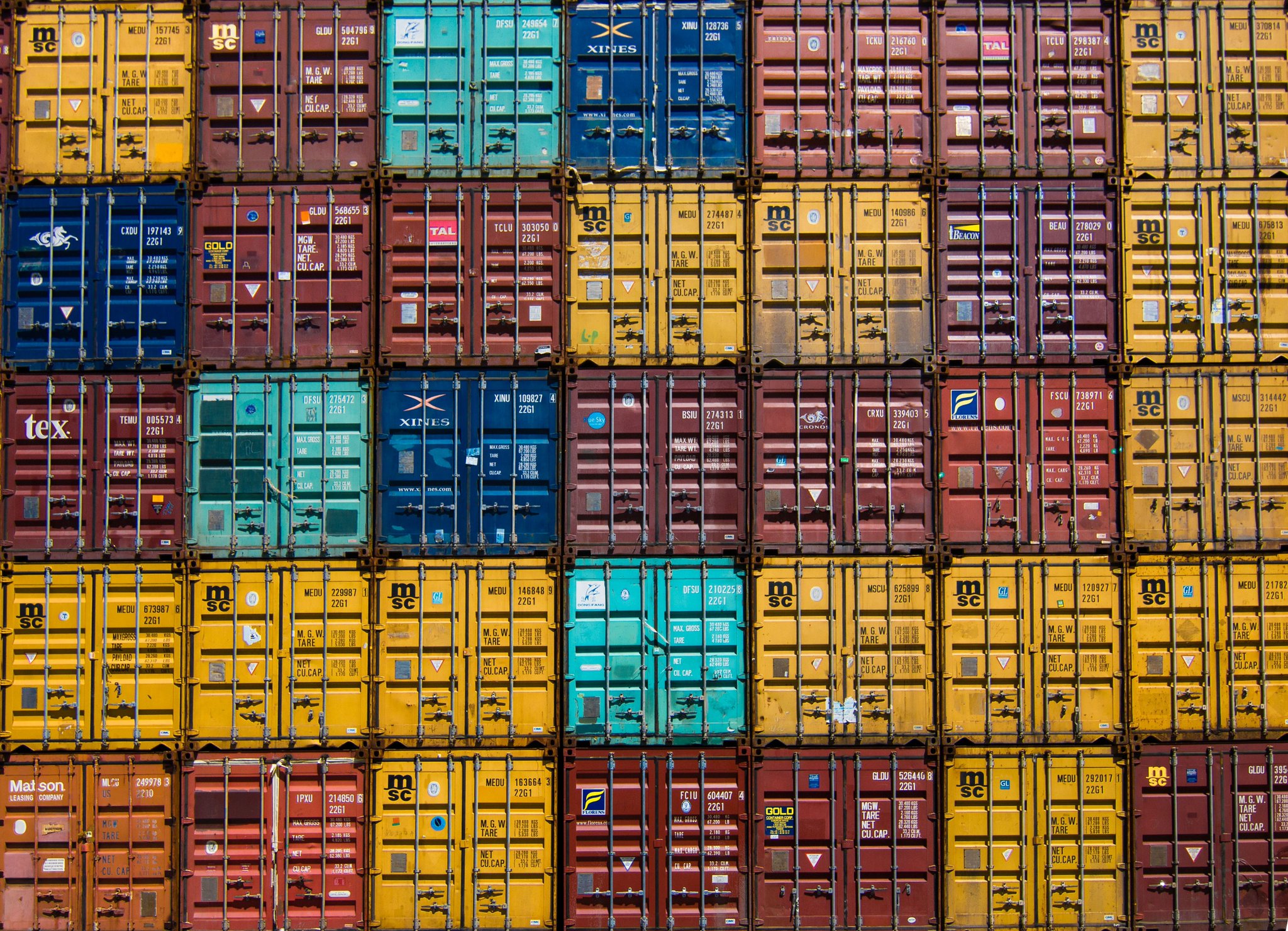 06/05/2019The CPM-14 agreed to include in its work programme the topic for a CPM Recommendation on “Facilitating safe trade by reducing the incidence of contaminating pests associated with traded goods”. This topic was proposed by Australia with support from New Zealand as contained in the CPM paper CPM 2019/37. Experts interested in joining this virtual group to improve the draft text, please send an email to Mr Ian Thompson (Ian.Thompson@agriculture.gov.au) and copy the Secretariat (Adriana.Moreira@fao.org) by 20 May 2019. Experts should provide (by 20 May 2019): Name Position Contact details Short description of skills and/or interest
06/05/2019The CPM-14 agreed to include in its work programme the topic for a CPM Recommendation on “Facilitating safe trade by reducing the incidence of contaminating pests associated with traded goods”. This topic was proposed by Australia with support from New Zealand as contained in the CPM paper CPM 2019/37. Experts interested in joining this virtual group to improve the draft text, please send an email to Mr Ian Thompson (Ian.Thompson@agriculture.gov.au) and copy the Secretariat (Adriana.Moreira@fao.org) by 20 May 2019. Experts should provide (by 20 May 2019): Name Position Contact details Short description of skills and/or interest -
 22/01/2019Whilst prevention is better than a cure, it is not always possible to stop every invasive species from entering an area. In these instances, early detection and rapid response are crucial, as management is much easier while the population of an invasive species remains small. Detection of small populations, however, can be incredibly difficult. With the spread of invasive species becoming an ever increasing problem around the world, it could pay to think outside the box when trying to manage them – could animals help with the fight against invasive species? Researchers and conservationists seem to think so.
22/01/2019Whilst prevention is better than a cure, it is not always possible to stop every invasive species from entering an area. In these instances, early detection and rapid response are crucial, as management is much easier while the population of an invasive species remains small. Detection of small populations, however, can be incredibly difficult. With the spread of invasive species becoming an ever increasing problem around the world, it could pay to think outside the box when trying to manage them – could animals help with the fight against invasive species? Researchers and conservationists seem to think so. -
 18/01/2019Sharp-eyed plant experts tramping in the Tongariro National Park have spotted butterwort – a carnivorous plant that is classed as an invasive weed and poses a danger to native wetland species. The Department of Conservation says it’s likely that someone passionate about the insect-eating specimen has deliberately introduced it. Tongariro’s senior ranger for biodiversity, Alison Beath, is asking people to keep an eye out for other incursions and to report them to DoC. They are likely to be in accessible damp areas – where the plants thrive – next to tracks or roads. The plants were spotted last month on the Taranaki Falls Track.
18/01/2019Sharp-eyed plant experts tramping in the Tongariro National Park have spotted butterwort – a carnivorous plant that is classed as an invasive weed and poses a danger to native wetland species. The Department of Conservation says it’s likely that someone passionate about the insect-eating specimen has deliberately introduced it. Tongariro’s senior ranger for biodiversity, Alison Beath, is asking people to keep an eye out for other incursions and to report them to DoC. They are likely to be in accessible damp areas – where the plants thrive – next to tracks or roads. The plants were spotted last month on the Taranaki Falls Track. -
 17/01/2019R&D Conference on Invasive Alien Species Management and Biosecurity Measures in the Asia Pacific Region Invasive Alien Species (IAS) are one of the major threats to biodiversity worldwide and is viewed as cause of extinction of the endemic or native species in a particular country where they have been introduced. These results to a phenomenon called bioinvasion of natural habitats and puts to risk the existence of our indigenous flora and fauna either through competition for food or space. This brings forth an emerging concept called biosecurity which is globally significant because of the risks they pose to the economy, environment and human health. Numerous international instruments have been developed to address IAS and the most comprehensive is the Convention on Biological Diversity (CBD) which calls on parties to prevent the introduction, control or eradicate those alien species which threaten ecosystems, habitats or species. At present, IAS occurs in different taxonomic groups. Some species have in fact been purposely used for various purposes such as reforestation, food production and biological control of other unwanted organisms and have, to some extent, been part of the country’s natural landscape. There is, however, a dearth of information in terms of the range of distribution and impacts of many of these IAS in natural ecosystems. Threfore, this conference aims to provide a forum for the exchange of research and development information and technologies on the status, control and management of invasive alien species (IAS) in the Asia-Pacific region. Expected Outcomes of the conference: Enhanced R and D partnership and cooperation between and among Asia-Pacific countries including dialogue and development partners particularly in coming up with strategies on sustainable management and/or eradication of invasive alien species; Institutional and capacity developments to be pursued among Asia-Pacific countries including dialogue and development partners in eliminating risks and negative effects of IAS introduction such as threatened human health and safety, environmental loss and substantial economic damage; and Improved/strengthened strategies and policies to address issues on IAS which globally is one of the major drivers of biodiversity loss. Get more information from the conference website here
17/01/2019R&D Conference on Invasive Alien Species Management and Biosecurity Measures in the Asia Pacific Region Invasive Alien Species (IAS) are one of the major threats to biodiversity worldwide and is viewed as cause of extinction of the endemic or native species in a particular country where they have been introduced. These results to a phenomenon called bioinvasion of natural habitats and puts to risk the existence of our indigenous flora and fauna either through competition for food or space. This brings forth an emerging concept called biosecurity which is globally significant because of the risks they pose to the economy, environment and human health. Numerous international instruments have been developed to address IAS and the most comprehensive is the Convention on Biological Diversity (CBD) which calls on parties to prevent the introduction, control or eradicate those alien species which threaten ecosystems, habitats or species. At present, IAS occurs in different taxonomic groups. Some species have in fact been purposely used for various purposes such as reforestation, food production and biological control of other unwanted organisms and have, to some extent, been part of the country’s natural landscape. There is, however, a dearth of information in terms of the range of distribution and impacts of many of these IAS in natural ecosystems. Threfore, this conference aims to provide a forum for the exchange of research and development information and technologies on the status, control and management of invasive alien species (IAS) in the Asia-Pacific region. Expected Outcomes of the conference: Enhanced R and D partnership and cooperation between and among Asia-Pacific countries including dialogue and development partners particularly in coming up with strategies on sustainable management and/or eradication of invasive alien species; Institutional and capacity developments to be pursued among Asia-Pacific countries including dialogue and development partners in eliminating risks and negative effects of IAS introduction such as threatened human health and safety, environmental loss and substantial economic damage; and Improved/strengthened strategies and policies to address issues on IAS which globally is one of the major drivers of biodiversity loss. Get more information from the conference website here -
 17/01/20199th International Workshop on Biological Control and Management of Eupatorieae and other invasive weeds: This workshop is organized under the auspices of the International Organisation for Biological and Integrated Control (IOBC) and CABI Southeast Asia. The first workshop was held in 1988 to facilitate the management and biological control of Chromolaena odorata in resource-poor tropical and subtropical countries. In 2003, the scope of the workshop was expanded to include closely related species such as Mikania micrantha, while retaining an emphasis on the tropics. Malaysia has been selected as the host country for this 9th workshop, the first to be held in Southeast Asia. The tribe Eupatorieae, which includes Chromolaena odorata and Mikania micrantha are widespread in Southeast Asia and have significant economic impacts on agriculture, the environment and livelihoods. The entire region has been shown to be highly climatically suitable for the weeds. Other species of invasive alien plants for which there are good biological control agents available and which could be included in this workshop if the interest exists, include Salvinia molesta and Pistia stratiotes. Download Second announcement flyer and registration form here Workshop website: http://www.iobcinvasiveweeds2019.org
17/01/20199th International Workshop on Biological Control and Management of Eupatorieae and other invasive weeds: This workshop is organized under the auspices of the International Organisation for Biological and Integrated Control (IOBC) and CABI Southeast Asia. The first workshop was held in 1988 to facilitate the management and biological control of Chromolaena odorata in resource-poor tropical and subtropical countries. In 2003, the scope of the workshop was expanded to include closely related species such as Mikania micrantha, while retaining an emphasis on the tropics. Malaysia has been selected as the host country for this 9th workshop, the first to be held in Southeast Asia. The tribe Eupatorieae, which includes Chromolaena odorata and Mikania micrantha are widespread in Southeast Asia and have significant economic impacts on agriculture, the environment and livelihoods. The entire region has been shown to be highly climatically suitable for the weeds. Other species of invasive alien plants for which there are good biological control agents available and which could be included in this workshop if the interest exists, include Salvinia molesta and Pistia stratiotes. Download Second announcement flyer and registration form here Workshop website: http://www.iobcinvasiveweeds2019.org -
 09/01/2019The Pacific Invasive Ant Toolkit is a collection of resources to help prevent and control invasive ants in the Pacific. We call this the PIAT for short. The PIAT is mostly targeted at helping developing and remote Pacific Nations, who often do not have access to pest control locally and depend on outside help. But anyone is welcome to use it. We decided that the PIAT was needed as the resources available to deal with invasive ants were in many different places and sometimes hard to find. So some of the resources you will find here have been specifically developed for PIAT, but others are available in other places. We always provide links to the original sources of information.
09/01/2019The Pacific Invasive Ant Toolkit is a collection of resources to help prevent and control invasive ants in the Pacific. We call this the PIAT for short. The PIAT is mostly targeted at helping developing and remote Pacific Nations, who often do not have access to pest control locally and depend on outside help. But anyone is welcome to use it. We decided that the PIAT was needed as the resources available to deal with invasive ants were in many different places and sometimes hard to find. So some of the resources you will find here have been specifically developed for PIAT, but others are available in other places. We always provide links to the original sources of information. -
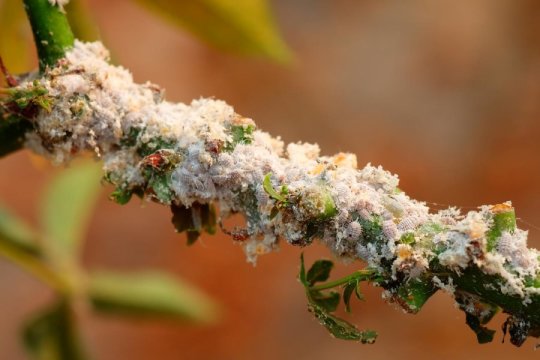 09/01/2019An international team of scientists, involving entomologists, conservation biologists, agro-ecologists and geographers, has just revealed how on-farm biological control can slow the pace of tropical deforestation and avert biodiversity loss on a macro-scale. The case study concerns biological control of the invasive mealybug Phenacoccus manihoti with the introduced host-specific parasitic wasp Anagyrus lopezi in Southeast Asia.
09/01/2019An international team of scientists, involving entomologists, conservation biologists, agro-ecologists and geographers, has just revealed how on-farm biological control can slow the pace of tropical deforestation and avert biodiversity loss on a macro-scale. The case study concerns biological control of the invasive mealybug Phenacoccus manihoti with the introduced host-specific parasitic wasp Anagyrus lopezi in Southeast Asia. -
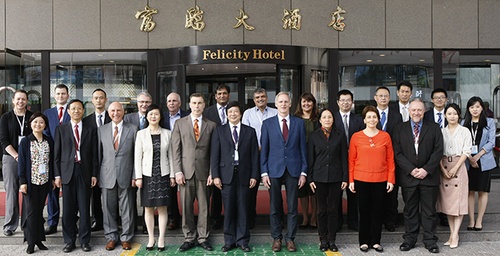 13/12/2018With the huge volume of international trade, sea containers can become vehicles for plant pests and diseases to spread into new areas. The International Plant Protection Convention (IPPC) has therefore set up a special Sea Containers Task Force (SCTF) to deal with this specific issue. The SCTF’s second meeting recently took place from 5 to 9 November 2018 in Shenzhen, China
13/12/2018With the huge volume of international trade, sea containers can become vehicles for plant pests and diseases to spread into new areas. The International Plant Protection Convention (IPPC) has therefore set up a special Sea Containers Task Force (SCTF) to deal with this specific issue. The SCTF’s second meeting recently took place from 5 to 9 November 2018 in Shenzhen, China -
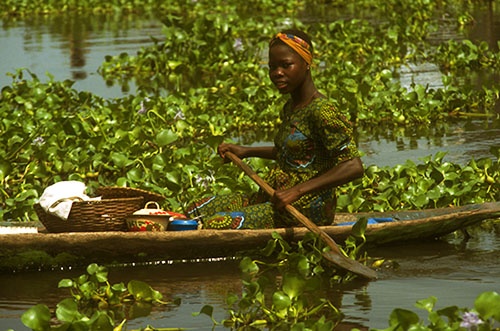 12/12/2018The International Year of Plant Health 2020 and the IPPC’s work in protecting plants from invasive alien species were highlighted during a side event at the 2018 Conference of the Parties to the Convention on Biological Diversity (CBD – COP 14) held in Sharm El Sheikh, Egypt.
12/12/2018The International Year of Plant Health 2020 and the IPPC’s work in protecting plants from invasive alien species were highlighted during a side event at the 2018 Conference of the Parties to the Convention on Biological Diversity (CBD – COP 14) held in Sharm El Sheikh, Egypt. -
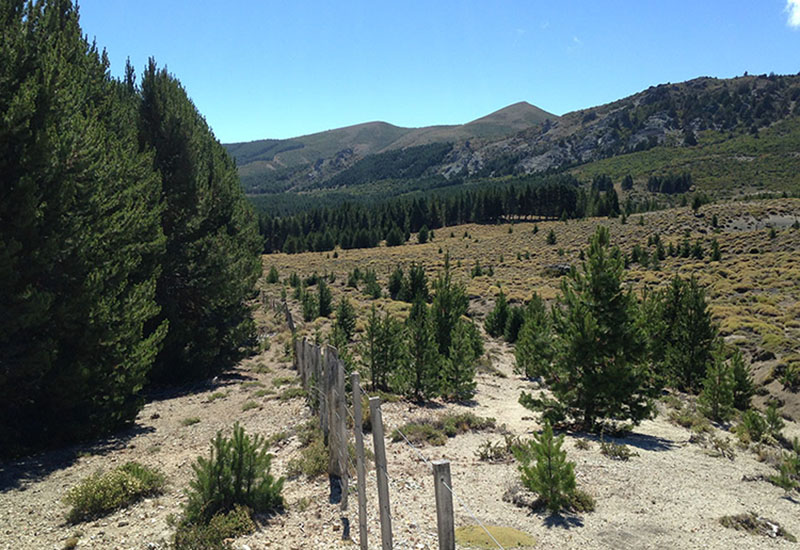 10/12/2018Forests around the world are experiencing invasions of thousands of different non-native species, including nearly every type of plant, animal and other types of organisms. Globalization is the main cause of the biological invasion issue, with increasing trade and travel causing accidental movement of organisms. A variety of methods are available for managing forest invasions, either by preventing the arrival and establishment of new species or by managing established populations. In the future, forests around the world will likely be exposed to increasing numbers of non-native species and effective management requires international cooperation and interdisciplinary integration.
10/12/2018Forests around the world are experiencing invasions of thousands of different non-native species, including nearly every type of plant, animal and other types of organisms. Globalization is the main cause of the biological invasion issue, with increasing trade and travel causing accidental movement of organisms. A variety of methods are available for managing forest invasions, either by preventing the arrival and establishment of new species or by managing established populations. In the future, forests around the world will likely be exposed to increasing numbers of non-native species and effective management requires international cooperation and interdisciplinary integration. -
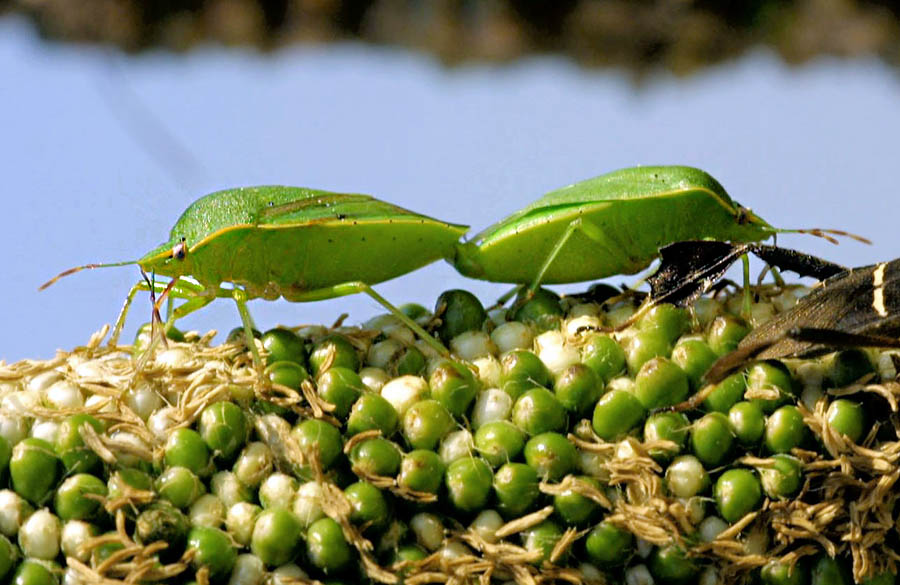 05/12/2018Last week CABI launched the full version of its invasive species Horizon Scanning Tool, a free and open access online resource available via the Invasive Species Compendium that helps users make decisions about invasive species and identify possible risks in countries, provinces and states. Following beta testing, the tool now includes new features and improvements such as an additional country filter based on trade data, enhanced sharing of horizon scans, improved CSV output and the integration of habitat data into the data sheets.
05/12/2018Last week CABI launched the full version of its invasive species Horizon Scanning Tool, a free and open access online resource available via the Invasive Species Compendium that helps users make decisions about invasive species and identify possible risks in countries, provinces and states. Following beta testing, the tool now includes new features and improvements such as an additional country filter based on trade data, enhanced sharing of horizon scans, improved CSV output and the integration of habitat data into the data sheets. -
 04/06/2018While people elsewhere in the state will plant millions of tree saplings marking World Environment Day on Tuesday, a group of greens and farmers in Wayanad are set to uproot over one lakh invasive plants that have been posing a threat to the forest ecosystem in the hill district.
04/06/2018While people elsewhere in the state will plant millions of tree saplings marking World Environment Day on Tuesday, a group of greens and farmers in Wayanad are set to uproot over one lakh invasive plants that have been posing a threat to the forest ecosystem in the hill district. -
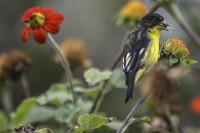 25/03/2018What is the state of biodiversity on Earth? Four scientific reports from the United Nations reveal that the Earth may be in store for a lonelier existence.
25/03/2018What is the state of biodiversity on Earth? Four scientific reports from the United Nations reveal that the Earth may be in store for a lonelier existence. -
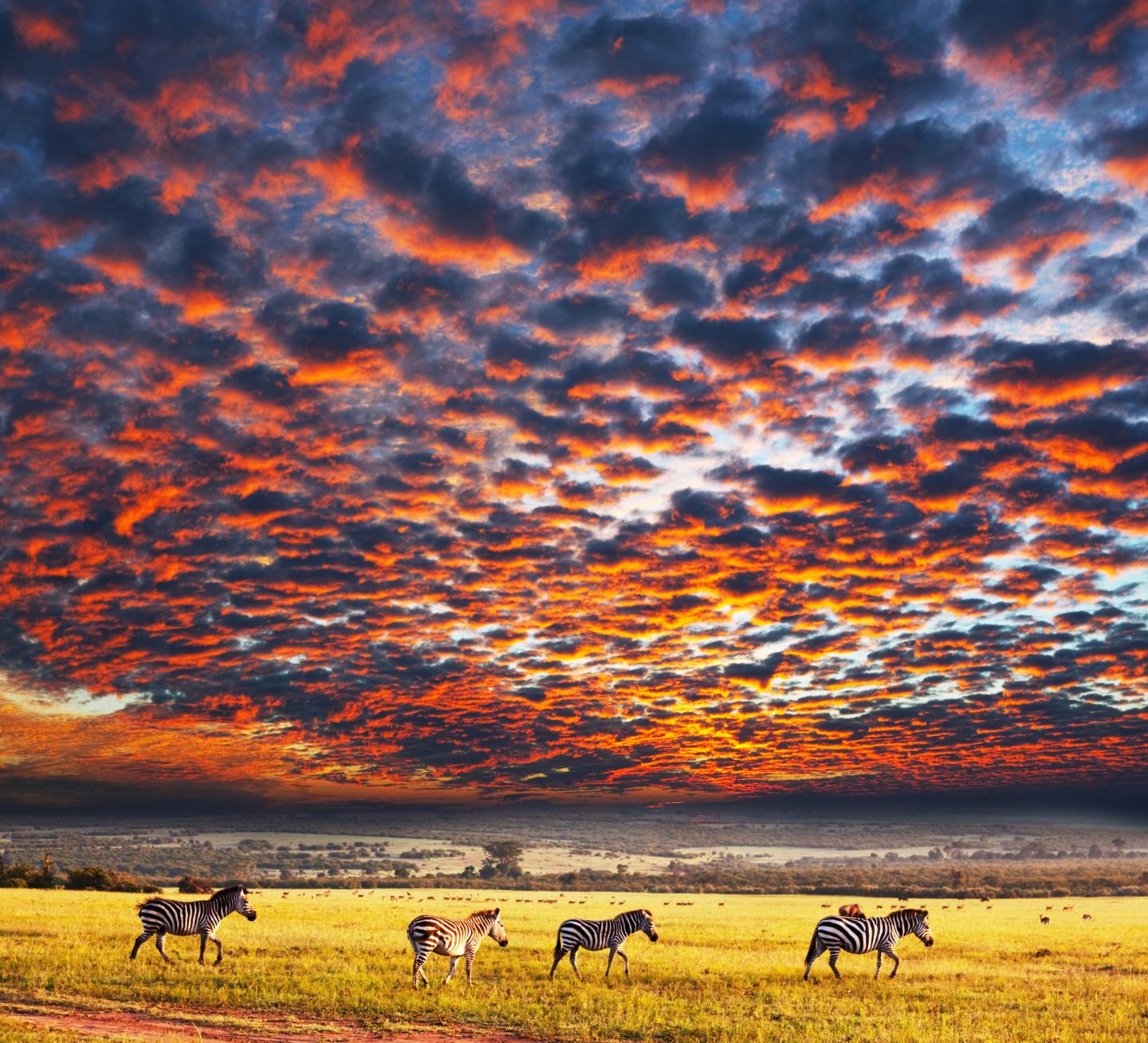 23/03/2018Human well-being at risk. Landmark reports highlight options to protect and restore nature and its vital contributions to people
23/03/2018Human well-being at risk. Landmark reports highlight options to protect and restore nature and its vital contributions to people -
 01/03/2018Expressing concern over the increase in the import of ornamental fishes to the country, which is posing a threat to India’s native fish populations, the National Biodiversity Authority (NBA) has urged the government to come up with quarantine facilities at major seaports and airports.
01/03/2018Expressing concern over the increase in the import of ornamental fishes to the country, which is posing a threat to India’s native fish populations, the National Biodiversity Authority (NBA) has urged the government to come up with quarantine facilities at major seaports and airports. -
 25/10/2017Managing invasive species could benefit 95 per cent of Endangered and Critically Endangered amphibians, birds and mammals that live on islands, according to a study involving researchers from the IUCN Species Survival Commission (SSC) Invasive Species Specialist Group and IUCN Member Island Conservation, published today in the journal Science Advances.
25/10/2017Managing invasive species could benefit 95 per cent of Endangered and Critically Endangered amphibians, birds and mammals that live on islands, according to a study involving researchers from the IUCN Species Survival Commission (SSC) Invasive Species Specialist Group and IUCN Member Island Conservation, published today in the journal Science Advances. -
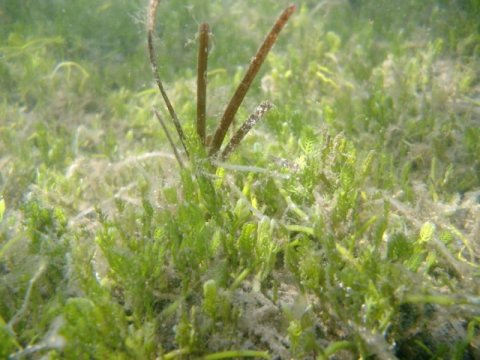 11/10/2017Restoration projects to remove invasive plants can make a positive impact on native plant species. But a new study featured in the journal Invasive Plant Science and Management shows restoration has an additional benefit. Removal of invasive species growing alongside a stream or river can also improve the biodiversity of aquatic organisms.
11/10/2017Restoration projects to remove invasive plants can make a positive impact on native plant species. But a new study featured in the journal Invasive Plant Science and Management shows restoration has an additional benefit. Removal of invasive species growing alongside a stream or river can also improve the biodiversity of aquatic organisms. -
08/10/2017As invasive species are threatening ecological habitats throughout the U.S. and Canada, the role of Indigenous nations as environmental stewards has often been overlooked, according to a Dartmouth-led study published in the current issue of American Indian Quarterly.
-
 03/10/2017A new study published today in the Journal of Applied Ecology, and co-authored by several IUCN scientists, identifies priority invasive alien species that require urgent action across the EU and proposes a systematic, proactive approach to select species for risk assessment, in order to assist EU policy implementation.
03/10/2017A new study published today in the Journal of Applied Ecology, and co-authored by several IUCN scientists, identifies priority invasive alien species that require urgent action across the EU and proposes a systematic, proactive approach to select species for risk assessment, in order to assist EU policy implementation. -
 28/09/2017When the massive tsunami waves of the 2011 eastern Japan earthquake rolled back out to sea, they pulled with them fragments of docks, boats, and buoys that sometimes contained living stowaways.
28/09/2017When the massive tsunami waves of the 2011 eastern Japan earthquake rolled back out to sea, they pulled with them fragments of docks, boats, and buoys that sometimes contained living stowaways. -
 14/09/2017Armies of microbes that are invisible to the naked eye battle it out to determine whether exotic marine plants successfully invade new territory and replace native species, UNSW Sydney-led research shows.
14/09/2017Armies of microbes that are invisible to the naked eye battle it out to determine whether exotic marine plants successfully invade new territory and replace native species, UNSW Sydney-led research shows. -
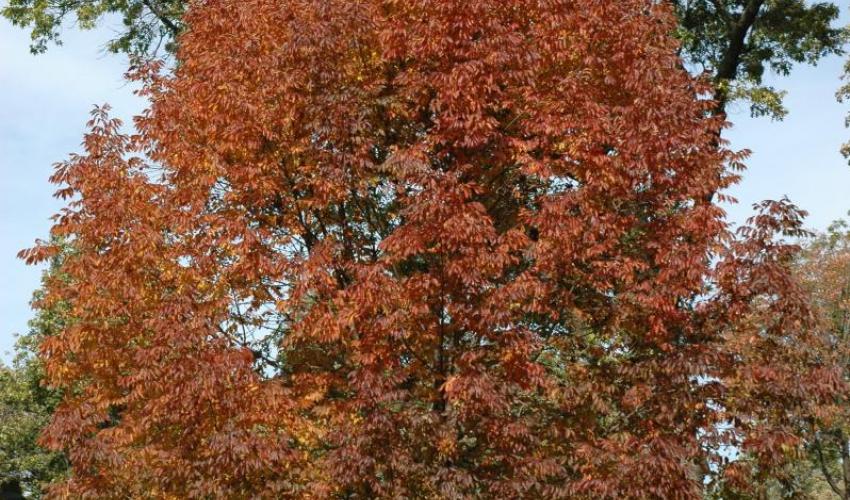 14/09/2017North America’s most widespread and valuable ash tree species are on the brink of extinction due to an invasive beetle decimating their populations, while the loss of wilderness areas and poaching are contributing to the declining numbers of five African antelope species, according to the latest update of The IUCN Red List of Threatened Species™.
14/09/2017North America’s most widespread and valuable ash tree species are on the brink of extinction due to an invasive beetle decimating their populations, while the loss of wilderness areas and poaching are contributing to the declining numbers of five African antelope species, according to the latest update of The IUCN Red List of Threatened Species™. -
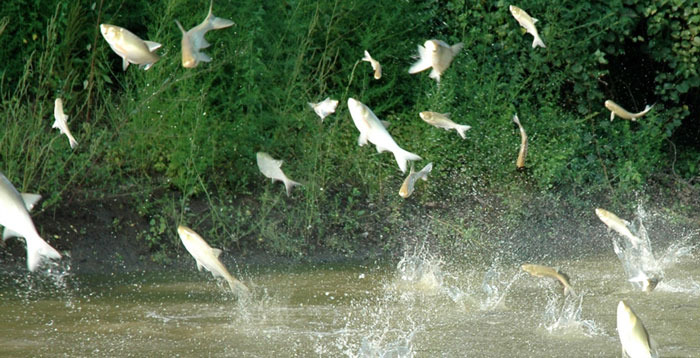 04/09/2017Before President Trump took office, a barrier designed to protect American jobs from a growing foreign threat had been researched by the U.S. Army Corp of Engineers.
04/09/2017Before President Trump took office, a barrier designed to protect American jobs from a growing foreign threat had been researched by the U.S. Army Corp of Engineers.
Filter - All
